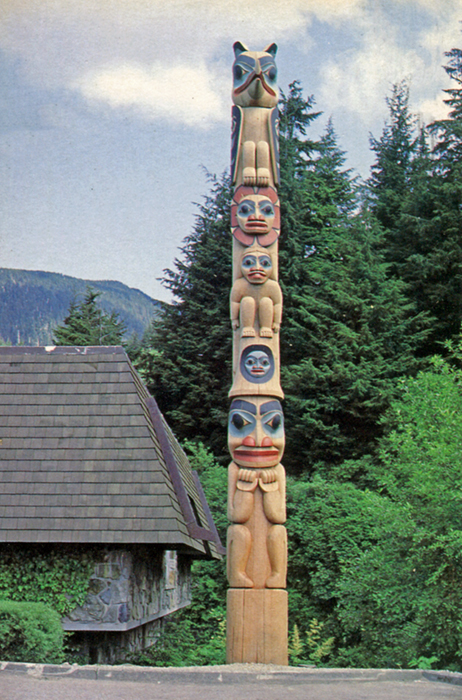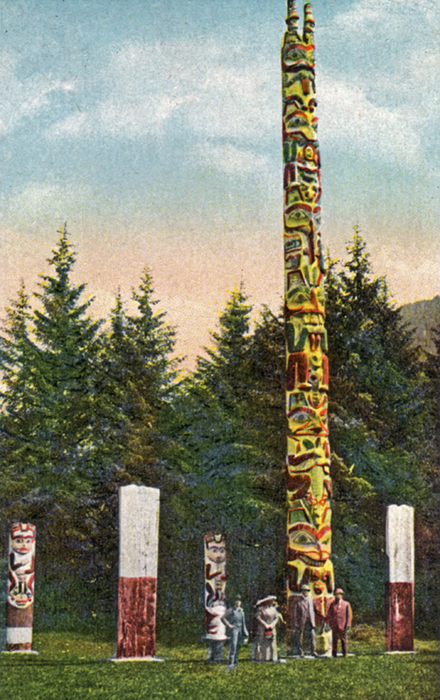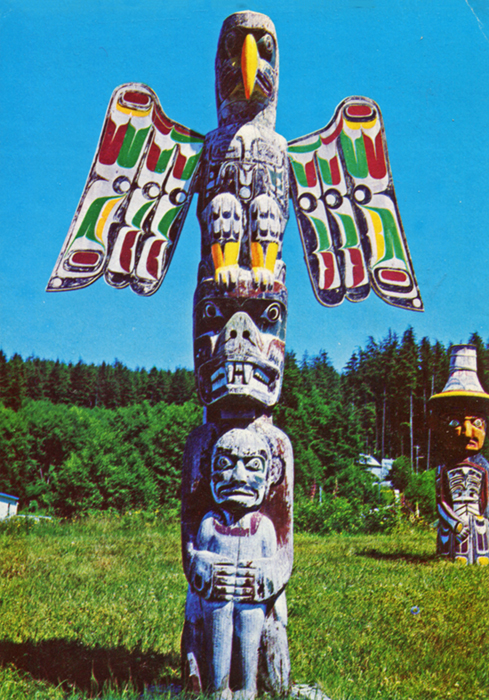Back to Don's Maps
 Back to Archaeological Sites
Back to Archaeological Sites
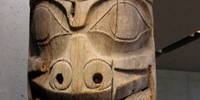 Back to Pacific NW Coast index
Back to Pacific NW Coast index
The First Nations of the Pacific Northwest
Totem Poles, House Posts, and Big Houses
The Indigenous peoples of the Pacific Northwest Coast are the pre-Columbian inhabitants of the Pacific Northwest Coast, their descendants, and many ethnic groups who identify with those historical peoples. They are now situated within the Canadian Province of British Columbia and the U.S. states of Alaska, Washington and Oregon.
The indigenous peoples of the Pacific Northwest Coast at one time had the most densely populated areas of indigenous people. The land and waters provided rich natural resources through cedar and salmon, and highly structured cultures developed from relatively dense populations. Within the Pacific Northwest, many different nations developed, each with their own distinct history, culture, and society. Some cultures in this region were very similar and share certain elements, such as the importance of salmon to their cultures, while others differed. Prior to contact, and for a brief time after colonisation, some of these groups regularly conducted war against each other through raids and attacks. Through warfare they gathered captives for slavery.
The creation of beautiful and practical objects (for all tribal communities) served as a means of transmitting stories, history, wisdom and property from generation to generation. Art provided Indigenous people with a tie to the land by depicting their histories on totem poles the Big (Plank) Houses of the Pacific Northwest coast – the symbols depicted were a constant reminder of their birth places, lineages and nations. Due to the abundance of natural resources and the affluence of most Northwest tribes, there was plenty of leisure time to create art. Many works of art served practical purposes, such as clothing, tools, weapons of war and hunting, transportation, cooking, and shelter; but others were purely aesthetic.
Spiritualism, the supernatural and the importance of the environment played integral roles in day-to-day life. Therefore, it was not unusual for their worldly goods to be adorned with symbols, crests and totems that represented some important figure(s) from both the seen and unseen worlds. Often different northern tribes would adorn their possessions with symbols that represented a tribe as a collective (i.e., clan); this would often be a signal of differentiation among tribal groups. Such symbols could be compared to a coat of arms, or running up the flag of a country on a sailing ship, as it approached a harbour.
After the arrival of the Europeans, Indigenous artefacts suddenly became a hot commodity to be collected and placed in museums and other institutions, and many tribal groups were looted of their precious items by over-zealous collectors. It is only in recent years that many Native organisations have been calling for a return of some of their sacred items, such as masks and regalia, that symbolise their cultural heritage.
Text above: Wikipedia
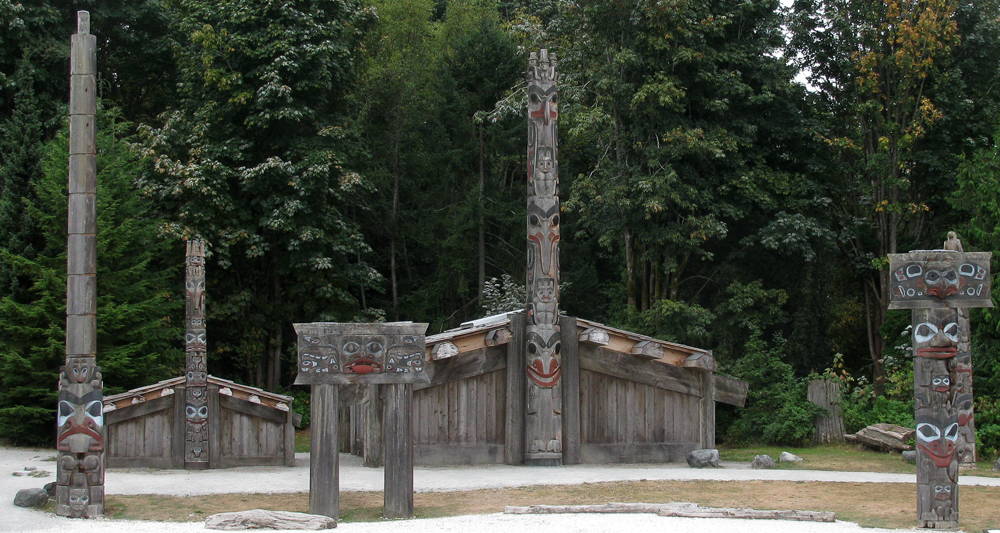
The University of British Columbia has a wonderful display of artefacts from the First Nations of the Pacific Northwest.
This is a group of buildings and totem poles which have been erected in the grounds.
Photo: Don Hitchcock 2012
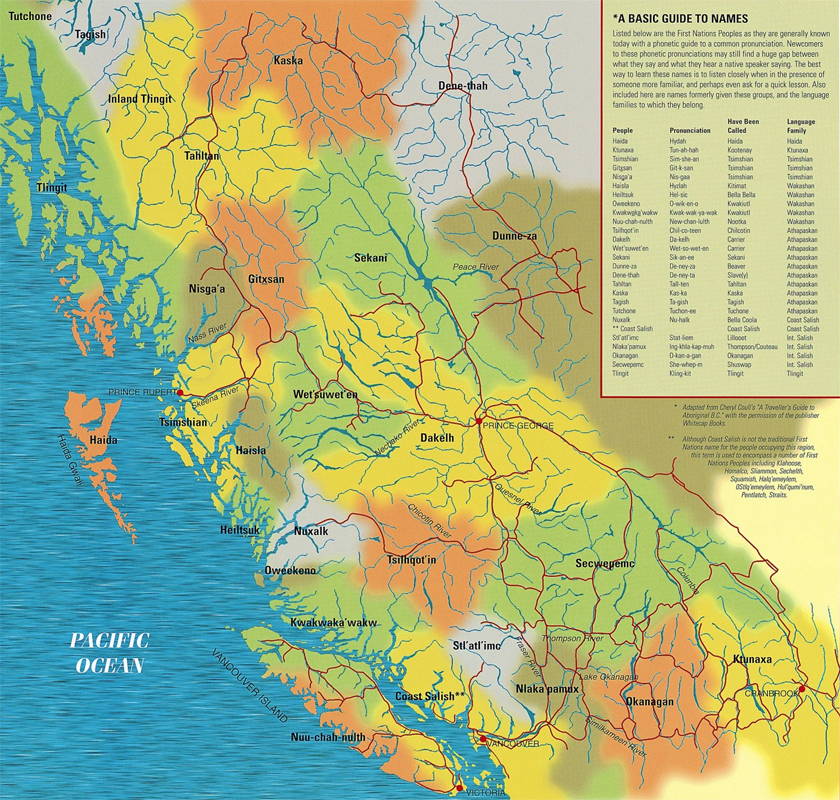
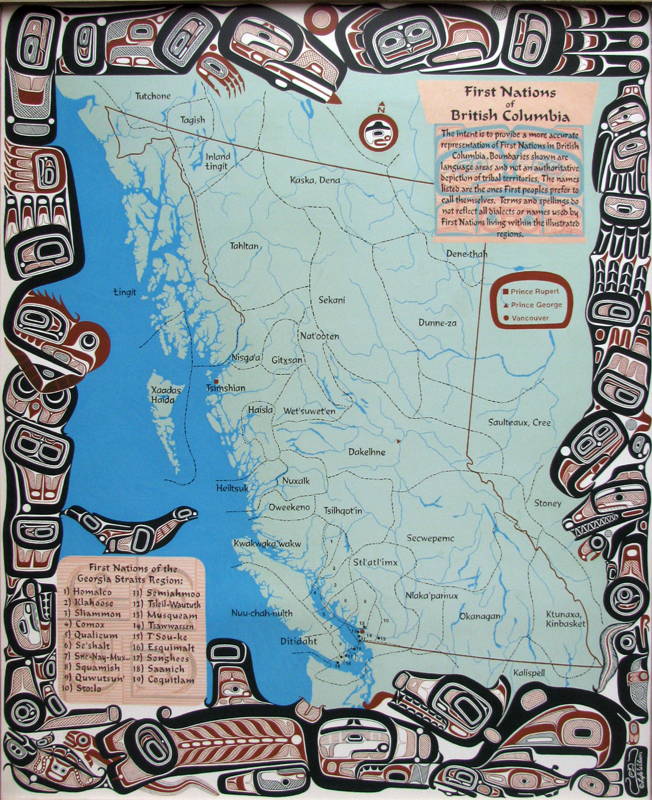
Maps of the First Nations of British Columbia.
The intent is to provide a more accurate representation of First Nations in British Columbia. Boundaries shown are language areas and not an authoritative depiction of tribal territories. The names listed are the ones First Peoples prefer to call themselves. Terms and spellings do not reflect all dialects or names used by the First Nations living within the illustrated regions.
Larger areas of First Nations People:
Tutchone, Tagish, Inland Tingit (Tlingit), Tingit (Tlingit), Kaska Dena, Tahltan, Dene-Thah, Sekani, Dunne-za, Nat'ooten, Nisga'a, Gitxsan, Xaadas Haida, Tsimshian, Haisla, Wet'suwet'en, Dakelhne (Dakelh), Heiltsuk, Nuxalk, Oweekeno, Tsilhqot'in, Saulteaux, Cree, Stoney (Nakoda), Kwakwaka'wakw, Stl'atl'imx, Nlaka'pamux, Nuu-chah-nulth, Ditidaht, Okanagan, Ktunaxa / Kinbasket, Kalispell
First Nations of the Georgia Straits Region:
1) Homolco, 2) Klahoose, 3) Sliammon, 4) Comox, 5) Qualicum, 6) Se'shalt, 7) Sne-Nay-Muxw, 8) Squamish, 9) Quwutsun', 10) Sto:lo (Staulo), 11) Semiahmoo, 12) Tsleil-Waututh, 13) Musqueam, 14) Tsawwassen, 15) T'Sou-ke, 16) Esq uimalt, 17) Songhees, 18) Saanich, 19) Coquitlam
Artwork (right): © Lyle Wilson
Photo (left): http://www.bced.gov.bc.ca/abed/map.htm
Source and text: Display, Museum of Anthropology, University of British Columbia
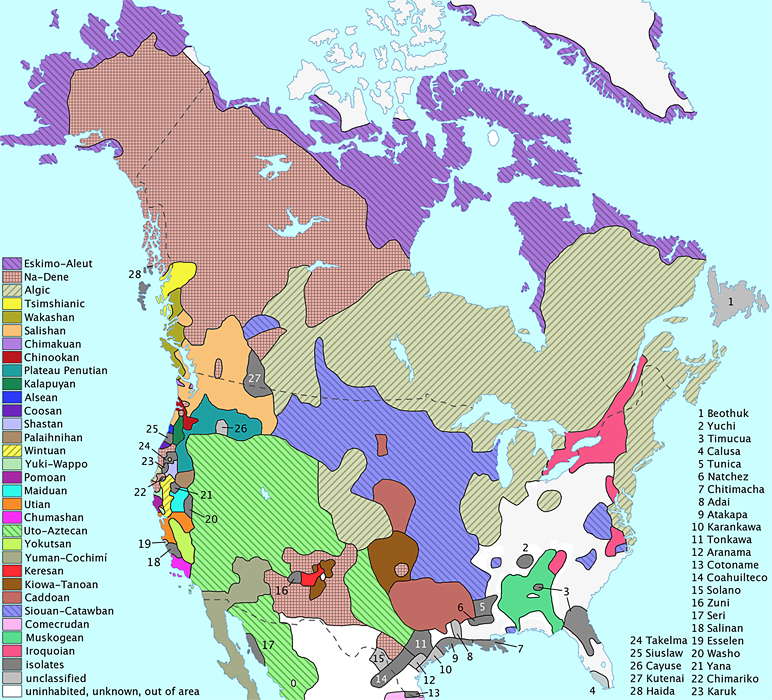
This is a very important map of the language areas of the First Nations across much of North America at the time of first contact.
Photo: en:User:ish ishwar in 2005, using GIMP software
released under CC-by-2.0
Permission: licensed under the Creative Commons Attribution 2.0 Generic license.
The use of the word 'totem' to describe the carvings historically found along the Northwest Coast is somewhat misleading. Even the earliest explorers recognized that the poles did not depict gods nor were they objects of worship. Rather the totem poles of the Northwest Coast are heraldic. These monumental carvings are better understood as physical manifestations of the owner’s family histories and rights. The images displayed are crest figures, many of which represent supernatural beings, or ancestors who encountered supernatural beings, from whom hereditary rights and privileges were obtained. These rights include lands, resources, house designs, images, names and ceremonies including the songs, masks, dances and regalia that are shown in the ceremonies. Poles proclaim and validate a person’s lineage and importance.
Text above: http://www.sfu.ca/brc/art_architecture/totem_poles.html
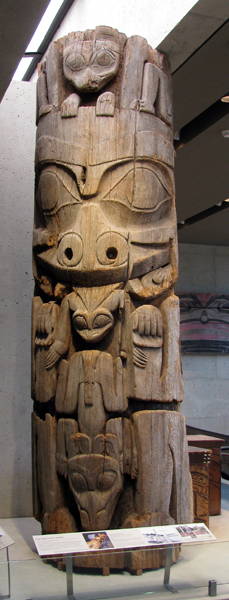
The carvings on house-front poles depict crests belonging to the owners of the house. The specific stories relating to each figure are known by those who hold the right to share this knowledge and preserve it for future generations.
This large bear figure, with a frog in its mouth and wolves above and below, is the base of what was once a 12.8 metre high pole. It stood before a clan house named TlldaGaaw Naay, or Mountain House, which belonged to the chief of Those Born in the Southern Part of the Island.
GyaaGang (House-front pole)
Haida: Gangxid KiiGawa Clan
SGaang Gwaay Linagaay (Ninstints, Haida Gwaii, BC)
Red cedar, 1860 or earlier
BC Totem Pole Preservation Committee purchase, 1957
A50018
Photo: Don Hitchcock 2012
Source and text: Display, Museum of Anthropology, University of British Columbia
Additional text: Stewart (1993)
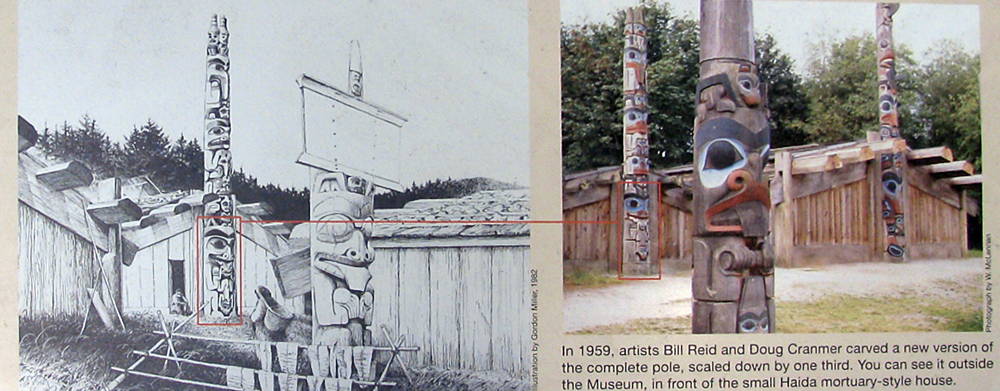
In 1959, Bill Reid and Doug Cranmer carved a new version of the complete pole, scaled down by one third. You can see it outside the Museum, in front of the small Haida mortuary-style house.
Source and text: Display, Museum of Anthropology, University of British Columbia
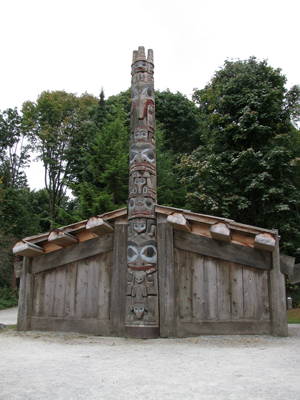
In 1959, artists Bill Reid and Doug Cranmer carved a new version of the complete pole of which the base is shown above, scaled down by one third. It is erected here outside the main Museum building, in front of a small Haida mortuary-style house.
Haida Mortuary House Frontal Pole
(from top to bottom)
Watchmen
Raven/Human with Human/Bird face on tail
Bear with Raven between legs
Frog-like creature with Mosquito face(?) between eyes
Bear with Frog in mouth, Wolf between legs, and Cub between ears
Alternative identification by Stewart (1993) of the carvings, top to bottom:
Three Watchmen are seated above Raven, who has arms and hands to signify his ability to transform into a human. A small face occupies Raven's upturned tail, while his claws emerge through the ears of Grizzly Bear, below.
Filling the space on Grizzly Bear's chest is a small Raven, with a wing on each side of its beak.
Beneath is a frog, wide eyed, with a small Mosquito between his eyes. Below Frog, a Bear cub crouches, its hind legs protruding through the ears of another Grizzly Bear, at the base of the pole.
A Frog protrudes from Grizzly Bear's mouth, and there is a Wolf cub between his front and hind legs.
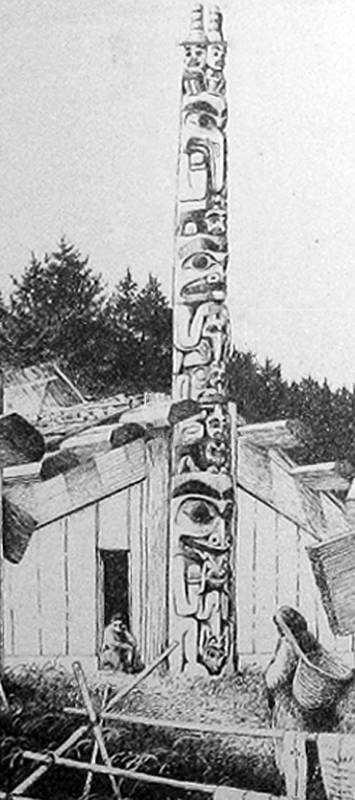

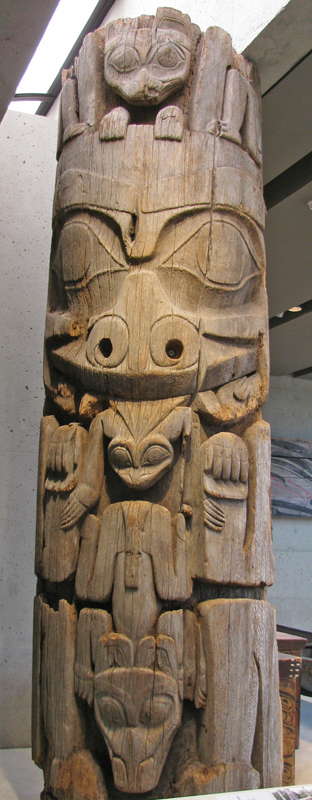
The complete totem pole as it looked in situ is shown in the illustration by Gordon Miller on the left.
In the centre is a photo of the recreated pole at 2/3 the original size, giving a volume of just less than 30% of the original totem pole.
On the right is a photograph of the base of the original totem pole of which the two salvaged sections above formed a part.
The carvings on house-front poles depict crests belonging to the owners of the house. The specific stories relating to each figure are known by those who hold the right to share this knowledge and preserve it for future generations.
This large bear figure, with a frog in its mouth and wolves above and below, is the base of what was once a 12.8 metre high pole. It stood before a clan house named TlldaGaaw Naay, or Mountain House, which belonged to the chief of Those Born in the Southern Part of the Island.
GyaaGang (House-front pole)
Haida: Gangxid KiiGawa Clan
SGaang Gwaay Linagaay (Ninstints, Haida Gwaii, BC)
Red cedar, 1860 or earlier
BC Totem Pole Preservation Committee purchase, 1957
A50018
Photo (right, centre): Don Hitchcock 2012
Illustration (left): Gordon Miller 1982
Source: Display, Museum of Anthropology, University of British Columbia
Except for the Watchmen, the pole is 2/3 scale copy of the older Haida pole inside museum: 50015a,b and A50018
Carved by Bill Reid with Douglas Cranmer, 1959
A50033
Photo: Don Hitchcock 2012
Source and text: Display, Museum of Anthropology, University of British Columbia
Additional text: Stewart (1993)
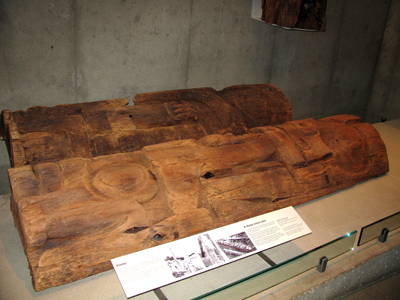
GyaaGang (House-front pole)
Haida: Gangxid KiiGawa Clan
SGaang Gwaay Linagaay (Ninstints, Haida Gwaii, BC)
Red cedar, 1860 or earlier
BC Totem Pole Preservation Committee purchase, 1957
A50015a-b
Carved figures, back fragment (A50015a):
Eagle with hands and feathers on arm. Claw framed by ear of bear below. Hawk-like creature against body.
Carved figures, front fragment (A50015b):
Bear with protruding tongue and raven on body, kneeling on head of unknown creature.
Photo: Don Hitchcock 2012
Source: Display, Museum of Anthropology, University of British Columbia

House frontal pole, red cedar.
Haida people, Tanu, British Columbia, 19th Century.
Haida houses served as ceremonial spaces where potlatches or feasts were performed to celebrate life cycle events. Memorial potlatches commemmorating the accession of new chiefs were, and still are, the most important events. Today potlatches are held in purpose-built community Big Houses.
This doorway is carved with various crest animals. Eagle sits at the top of the pole. Underneath is a subsidiary crest, probably Hawk. On either side of Hawk are the horns of Mountain Goat.
The large figure at the bottom is Whale - a baleen whale.
Further information from the online catalog:
Totem Pole (68.1898) Western Red Cedar, Thuja plicate, D.Don. From Queen Charlotte Islands.
'It formed the front and only entrance to the house of Mrs. Thomas Moody. It is made of Cedar (T. gigantes) and is about 20 years old. Its position with regard to the frame of the house is shown in photo no.1. Between the eaves of the totem projected the end of the ridge pole which rested on the top of the totem, helping to keep it in place. The pole was furthermore set about 4 ft. in the ground but had very slight support from the building. It represents the crest of the late owner's family - an eagle over another animal species unknown.'
The Hon. James Baker, Provincial Secretary, Citoris, B.C.
Catalog: 68.1898, Ethno 1958 Am 2.1
Photo: Don Hitchcock 2018
Text: Card at Museum, http://www.britishmuseum.org/, © Trustees of the British Museum, CC BY-NC-SA 4.0
Source: Original, British Museum
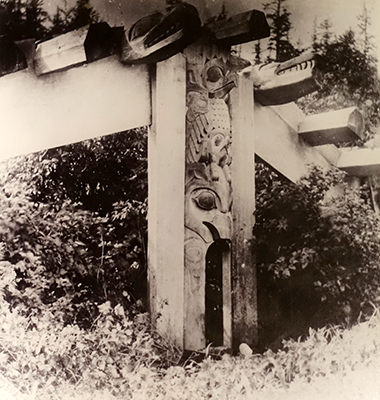
House frontal pole as above, in situ.
Eagle House, Tanu.
Catalog: 68.1898, Ethno 1958 Am 2.1
Photo: Royal British Columbia Museum, Victoria, B.C.
Rephotography: Don Hitchcock 2018
Text: Card at Museum, http://www.britishmuseum.org/, © Trustees of the British Museum, CC BY-NC-SA 4.0
Source: Poster, British Museum


Totem Pole, or House Frontal Pole of the Haida Nation, about 1850, in red cedar wood.
This 11 metre (listed as 12 metre in the digital catalog) pole was originally set at the front of Goose or Bear House in the village of Kayang, on Masset Inlet, Graham Island. It was purchased from Chief Wiah of Masset in 1903. At that time the village of Kayang had already been abandoned after the local community was devestated by epidemics of introduced diseases.
From top to bottom the pole features crests of a chief holding a talking stick, a sea-grizzly (sea monster), a shaman holding two rattles made of puffin beaks, a large whale and a sea-grizzly between the tail fins of a killer whale. Riding on the sea-grizzly's head is a small human figure.
The BM Pictorial Collection owns two photographic prints of this totem pole in its original location. See Am-B43-24 and Am-B43-25.
Catalog: Am1903,0314.1
Photo: (left) single photo, (right) higher definition image stitched from three photos, Don Hitchcock 2018, 2015
Source and text: Card at Museum, http://www.britishmuseum.org/, © Trustees of the British Museum, CC BY-NC-SA 4.0
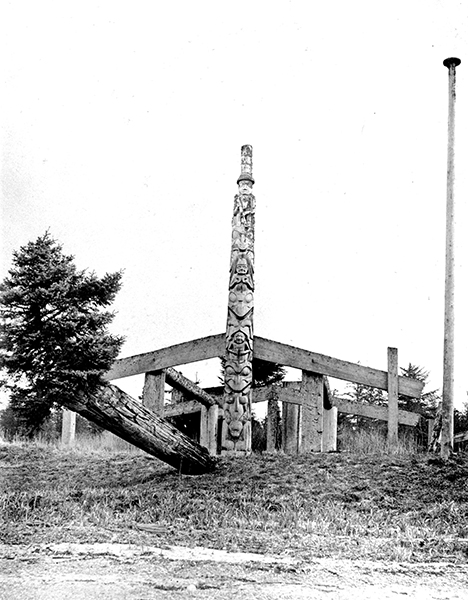
Totem pole made of wood (red cedar). The photograph shows the pole in situ circa 1877 in front of the remains of Bear House (also known as Goose House), Kayang, Massett, Haida Gwaii.
Catalog: Asset number (photograph) is 305128001, original totem pole number is Am1903,0314.1
Photo: © The Trustees of the British Museum
Source and text: http://www.britishmuseum.org/, © Trustees of the British Museum, CC BY-NC-SA 4.0


Memorial Pole (pts'aaan) for Chief Luuya'as
Eagle-Beaver Clan of the Nisga'a Nation.
British Columbia, Canada, about 1870, red cedar wood.
In memory of Chief Luuya'as Made by Nisga'a, circa 1870.
Totem poles are raised as memorials to leaders. This pole was carved in about 1870 in memory of Chief Luuya'as and depicts crests from the Eagle-Beaver clan.
Poles such as these have a similar function to European coats of arms. The top crest is a mythical sharp-nosed bird. Underneath is an Eagle, or possibly a Thunderbird. Next are two beavers, a mother and a cub. At the base of the pole is a mythical undersea creature called 'Man-Underneath' - who is shown catching a whale.
Each crest recalls a legendary event in the clan's history.
Raising poles involved tens or even hundreds of people. They used scaffolding and ropes to hold the pole upright while the base was wedged in, earth securing the pole in place.
Catalog: Am1987,Q.2
Photo: (left) single photo, (right) two stitched photos, higher definition, Don Hitchcock 2015
Source and text: Card at Museum, http://www.britishmuseum.org/, © Trustees of the British Museum, CC BY-NC-SA 4.0
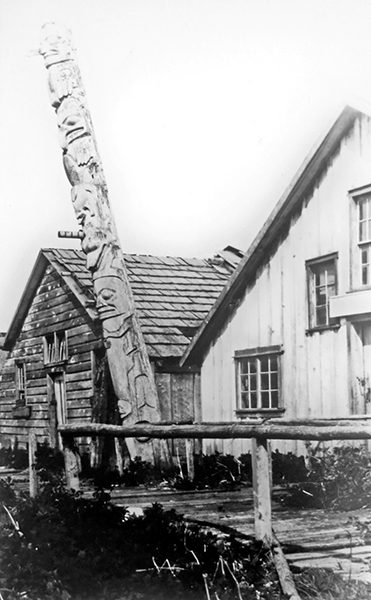
Memorial Pole (pts'aaan) for Chief Luuya'as (as in images above) in situ.
The pole originally had an eagle as the topmost crest. This was lost by the time of purchase from the descendants of Chief Luuya'as in 1932
Photo: © The Trustees of the British Museum
Source and text: Poster, © Trustees of the British Museum, CC BY-NC-SA 4.0


Coast Salish House posts of red cedar, British Columbia, 19th Century.
Both posts are surmounted by owl-like figures, no doubt guardians obtained in a vision quest, with fishers or weasels climbing the posts, perhaps representing a purification ritual in which preserved animals were passed over a person. These were collected by Edmund Verney in the Comox (literally 'rich') district of Coast Salish territory on Vancouver Island. They were sent to England in 1863, on HMS Princess Royal, an early acquisition of large sculpture on the Northwest Coast.
Catalog: Ethno 1944 Am2.393, Q87 Am5
Photo: Don Hitchcock 2018
Source and text: Card at Museum, http://www.britishmuseum.org/, © Trustees of the British Museum, CC BY-NC-SA 4.0
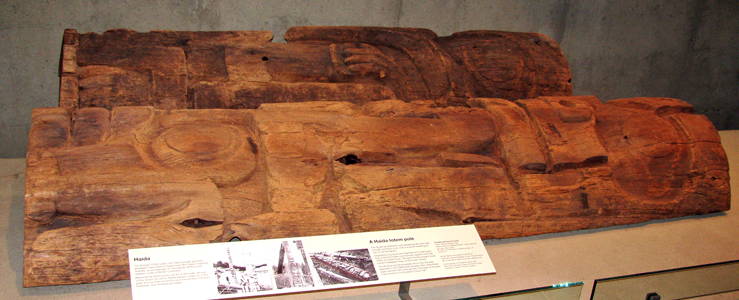
For at least 10 000 years, the Haida people and their ancestors have lived on Haida Gwaii (the Queen Charlotte Islands), an archipelago of 150 islands off the north-western coast of British Columbia.
Monumental totem poles carved of red cedar are one of the means by which Haida people, today as in the past, honour their ancestors and record their histories, territories, and inherited privileges.
Photo: Don Hitchcock 2012
Source: Display, Museum of Anthropology, University of British Columbia
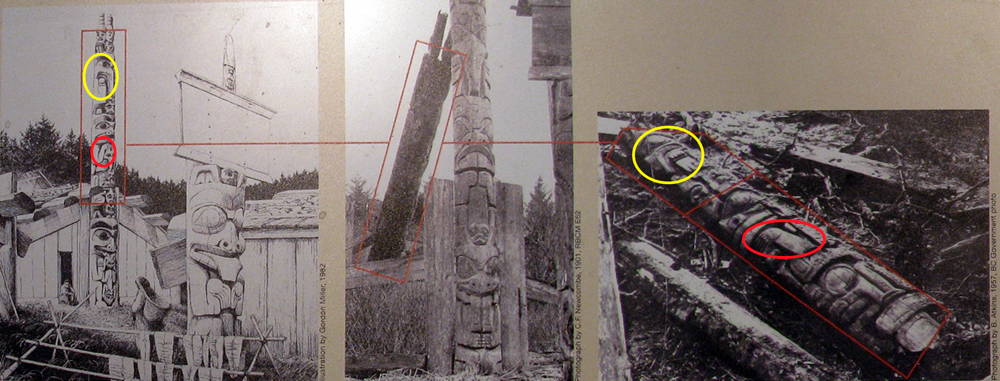
( Note that in this illustration the image on the left is shown from the right side, and the illustration of the pole on the ground shows the left side of the pole. Equivalent sections are marked with yellow and red ovals respectively - Don )
Monumental totem poles carved of red cedar are one of the means by which Haida people, today as in the past, honour their ancestors and record their histories, territories, and inherited privileges.
The proper presentation and witnessing of a totem pole through ceremony is as vital to a pole's meaning as are its carved figures.
Displayed lying down are fragments of a totem pole that would have been ceremonially raised in the mid 1800s on Haida Gwaii. The pole fronted a large house named TildaGaaw Naay, or Mountain House.
The drawing and photographs show how the pole appeared in the 1860s and decades later, when these upper sections fell to the ground. The base of the pole is preserved in the Museum's Great Hall (see below).
Source: Display, Museum of Anthropology, University of British Columbia


These are the two salvaged sections of the pole shown above, in the correct proportions.
The top section is smaller than the bottom section.
Source: http://collection-online.moa.ubc.ca/



House Frontal Pole
Haida
Another example of classic Haida design is seen in the replica of a pole that once stood up against a house in Masset on the Queen Charlotte Islands, a village that bristled with some fifty poles during the late nineteenth century. Sometime before 1878 the house was abandoned, and in 1901 Dr. Charles F. Newcombe bought the pole for the provincial museum in Victoria, B.C.
It stood in Beacon Hill Park for many years until a windstorm sent it crashing, breaking the pole beyond repair. The pieces were given to the Museum of Anthropology, and some of them are now displayed on the walls of the foyer. The museum commissioned Jim Hart of Massett to replicate the pole, with Bill Reid acting as consultant.
"I wanted to experience all aspects of carving the first pole for which I'd be responsible," Jim Hart said, "so I began by involving myself in choosing the cedar log." When some rot subsequently showed up, he adzed it out and carefully fitted in a section of good wood. For ten months he worked long and often lonely hours carving the pole. At the top of the pole is Raven, then Frog, Sea Bear with its cub, an upside-down human, and Bear holding Frog in its mouth; small frogs peek through the cars of Grizzly Bear at the base, holding Sculpin.
Additional text below from http://www.rrnpilot.org/items/16413 :
Free standing house frontal pole with hollowed out back. Bilaterally symmetrical distributive bas-relief carving with painted details, in flat black and orange red.
From top is a standing raven with attached cone-shaped beak; head and shoulders of frog; sea bear with dog-fish like face on ears, wide orange-red tongue extending over fore-paws raised to chin; sea-bear cub with head to bottom and body over top of sea-bear body above with hind limbs of top sea-bear under and to sides; upside down human head with arms emerging at sides; bear head with frog emerging from mouth; grizzly bear with sculpin between forepaws and frog on each ear.
All eyes are black and round with black round or tapering oval outlines; eyebrow bands are black; eye and ovoid detail on raven wings are black; ears are outlined in black; mouths and nostrils are red-orange. Large longitudinal cracks, darkened areas and green growth along centre front. Bird droppings along areas of highest relief.
Poles erected in front of houses, or the carved structural components at the front of houses, display the crests of the families who own them. They represent a family's status and affiliations.
This pole is a copy of one which was moved from old Masset to Beacon Hill Park, in Victoria, by Newcombe, in 1901. The original pole was from house 34 (MacDonald) an unnamed house, possibly owned by 'Eagle' of 'The Rotten House People.' The fragments of the old pole came to UBC in 1948. These remained in storage until a skilled Masset carver could be recruited to carve a new pole. This new pole was raised on the Museum's grounds on October 2, 1982. The old fragments are still in storage.
The cedar log was donated by Western Forest Products. Log preparation was undertaken by Fred Davis, Mike Lepago and Pete Durnell. Bill Reid served as an advisor/artistic consultant. Wood scientists for Forintek provided technical guidance.
Made by Jim M. Hart (Maker) and Fred Davis (Technician) in British Columbia, Canada between August 1981 and October 1982
Identification Number: Nb1.487
Manufacturing Technique: machine sawn, painted, adzed and carved
Height 11.0 m, width 1.0 m, depth 0.9 m
Condition: good
Accession number: 865/1
Creation Date: between August 1981 and October 1982
Photo (left) and text: Stewart (1993)
Photo (centre): Don Hitchcock 2012
Photo (right) and additional text: http://www.rrnpilot.org/items/16413
Source: Display, Museum of Anthropology, University of British Columbia



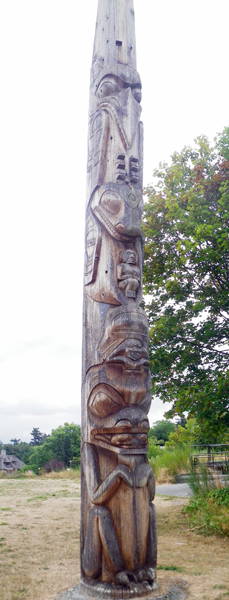
Running Wolf Totem Pole
Nb7.244
1980
The pole at the north end of the museum's outdoor exhibit had its beginning as a series of half-hour made-for-TV films on traditional skills in various cultures. Sunrise Films of Toronto commissioned Walter Harris, a well-known 'Ksan carving instructor, to create a totem pole with his sixteen year old son, Richard. (Traditionally, a carver would train his nephew.) To meet the deadline, the carver's sister, Doreen Jensen, herself an accomplished carver, his older son, Rodney, and others also worked on the pole. The Royal Bank of Canada, which funded the work, donated the completed pole to the Museum of Anthropology.
For the pole raising on 24 August 1980, a large contingent of Gitksan people from the Hazelton and Kispiox area of northern British Columbia flew in to create a lavish ceremony, rich in tradition. The pole was raised in three stages, marked by songs, speeches and dancing with masks. Hundreds of spectators helped to haul on the ropes. raising the pole to its upright position against a cloudless sky.
A pebble ceremony followed the Wolf dance. Those invited to the pole raising were asked to bring a pebble to throw into the excavated hole in which the pole was set. This gesture was symbolic of filling the hole with large rocks, as was done in early times, to buttress the base of the towering monument. All those attending then feasted on a salmon dinner served from
the nearby Haida house.
The film crew flew in and documented the final phase of their project - the pole raising - but that night thieves broke into their truck and stole not only the equipment but the reels of film. With improvisation, the film was completed, but it lacked complete coverage of the ceremonial event. The top of this unpainted pole carries the crest of Running Wolf, followed by Mosquito. Below is Killer Whale, with a dorsal fin and a blowhole on its forehead, and a pectoral fin on each side. Killer Whale is abducting a woman, crouched on its chest, whose pursuing husband is looking out from between the sea mammal's tail flukes: the Nanasimget story. At the base is Frog, with a small frog in its mouth. The elaborately carved folding doors at the entrance to the Museum of Anthropology are also the work of 'Ksan carvers, who worked under the guidance of Walter Harris. The rich array of figures illustrates a legend that tells of the origin of the first Gitksan people on the Skeena River.
Alternative description below from http://www.rrnpilot.org/items/15814 :
Unpainted simply carved bilaterally symmetrical totem pole with flat back. Figures from top: horizontal running wolf has bent limbs extended to front and back, wedge shaped head over forelimbs has bared teeth and protruding tongue; mosquito figure, separated from wolf by uncarved section, has u shaped ears, eyes that bulge at top and are inset at base, straight downward pointed proboscis has bared teeth, wings held next to body have ovoid and u decoration, three sets of bent legs and feet rest on a whale's head; killer whale has dorsal fin protruding from between mosquito's legs, blow hole below dorsal fin, ovoid eyes, bared upper teeth, pectoral fins next to body have ovoid and u decoration, small seated female figure (wife of Nanasimget) with hands resting on lap between whale's head and tail flukes; between tail flukes is the upper portion of a male figure (Nanasimget) with bent arms, head rests on curled hands; last figure is a frog with a small frog in its mouth, bent fore and hind limbs resting on front of body. Pole is set into a cement base. Moss on wolf figure, severe vertical cracking.
Made by Walter Harris (Maker) and Rodney Harris (Maker) in British Columbia, Canada during 1980
Identification Number: Nb7.244
Height 9.2 m, width 1.75 m, depth 0.8 m
Condition: fair
Accession number: 690/1
Culture: Gitxsan
Creation Date: during 1980
Photo (left): http://www.rrnpilot.org/items/15814
Photo (left centre) and text: Stewart (1993)
Photo (right centre and right): Don Hitchcock 2012
Additional text: http://www.rrnpilot.org/items/15814
Source: Display, Museum of Anthropology, University of British Columbia


Kolus, Young Thunderbird Totem Pole
A50041
Wooden pole carved in low relief, with opening at base; crescent shaped in cross section. The motifs are, from the top down: Kolus (a supernatural bird), a thunderbird, and an unknown creature with human facial features and gaping mouth as opening at base. Entire surface is painted in white, black, green, red and yellow in Northwest Coast stylised forms.
The beings represented on Kwakwaka'wakw totem poles are those beings from mythical times who became, or were encountered by, the ancestors of those who commissioned the pole, whose family had claimed the figures as crests. Crests could also be obtained as marriage gifts.
Kolus is a young thunderbird. Thunderbird is a supernatural bird identifiable by the presence of ear-like projections or horns on the head, and a re-curved beak.
The pole alludes to the story of Tongas people in south Alaska, who migrated south.
This pole was carved for the Edward S. Curtis film 'In the Land of the War Canoes' which was originally titled 'In the Land of the Head Hunters'. The pole was repaired and re-painted by carvers Ellen Neel in 1949 and Mungo Martin in 1950-51. It stood at Totem Park, UBC Campus until it was re-located to the Museum's Great Hall in 1976.
Made by George Hunt (Maker) in Fort Rupert, British Columbia, Canada and Tsaxis, British Columbia, Canada during 1914
Collected by Marius Barbeau and Arthur Price during 1947
Owned by Committee on Totem Poles before 1947
Identification Number: A50041
Height 720 cm, width 70 cm, depth 25 cm
Made in: Fort Rupert, British Columbia, Canada and Tsaxis, British Columbia, Canada
Condition: fair
Accession number: 2106/7
Culture: Kwakwaka'wakw: Kwagu'l
Photo (left): Don Hitchcock 2012
Photo (right): http://www.rrnpilot.org/items/17828
Text: http://www.rrnpilot.org/items/17828
Source: Display, Museum of Anthropology, University of British Columbia
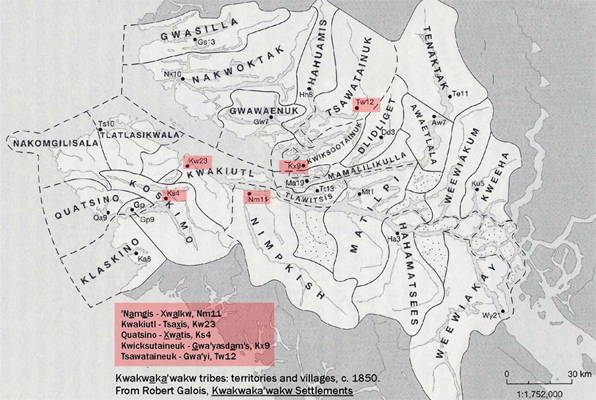
Kwakwaka'wakw lands, ca 1850.
R. Galois (text added)
Photo: possibly Galois (1994)
Source: http://www.firstnations.de/fisheries/kwakwakawakw.htm
From http://theravenscall.ca/en/who/life_story/middle_years
In 1962, with Kwakwaka'wakw assistant Douglas Cranmer, Bill Reid completed two houses and seven poles for the Haida village project at UBC. During this time, he was briefly married to his second wife, Ella Gunn.
In the old days, Haida master carvers would carve one side of a totem pole and then supervise an apprentice carving the other side. Michelangelo, Rodin, Fabergé, and other sculptors and goldsmiths had teams of assistants, many of whom were themselves accomplished artists and highly-skilled artisans, involved with all phases of the work.
In keeping with the tradition of both Haida and European master artists, Bill Reid had many people helping him with his large projects over the years, even before his Parkinson’s disease had diminished his ability to work physically. We gratefully acknowledge here some of those who were Bill’s assistants and collaborators on his major works: Doug Cranmer, George Norris, Guujaaw, Jim Hart, George Rammel, Stacey Brown, Tucker Brown and Don Yeomans.
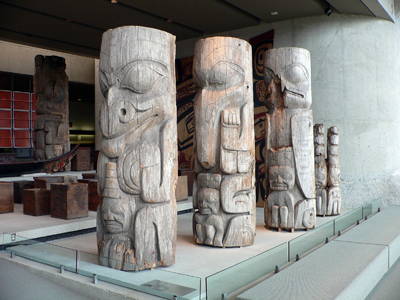
This is a house-front pole cut into parts for transportation, displayed in the UBC Anthropology Museum during renovations in 2007.
It is a fine photograph from Nathan Bauman's excellent blog.
Photo: © Nathan Richard Bauman
Source: http://nathanbauman.com/odysseus/?p=175
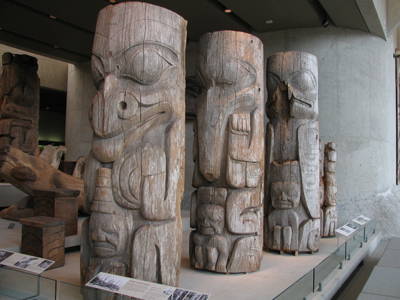
The pole is still in reasonable condition, though some parts have been damaged by the ravages of weather.
This Haida house-front pole once stood before a dwelling named 'Plenty of Ilimen-Hides in this House.' It belonged to an Indian clan named 'Those Born at Qadasgo Creek.'
Photo: Don Hitchcock 2012
Source: Display, Museum of Anthropology, University of British Columbia
Text: Wikipedia


Individual components of the pole.
On the left is a grizzly bear, with a human below it, wearing a ringed hat (base of pole)
On the right is a cormorant, with small human-like figure
Photo: Don Hitchcock 2012
Source: Display, Museum of Anthropology, University of British Columbia
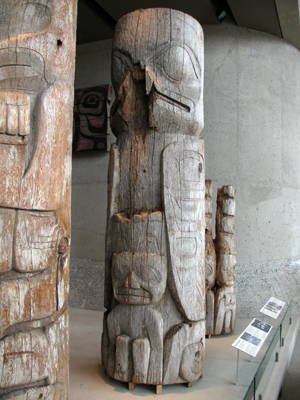
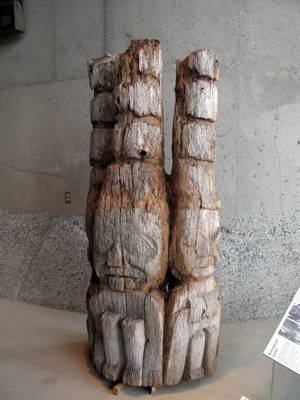
Although it is a shame it was cut in pieces, at least it means that each piece may be easily studied. The third piece (below the watchmen on top) originally had a beak which has since rotted away.
On the left is an eagle (missing its beak) with a small human-like eagle
On the right are three watchmen forming the top of the pole
Photo: Don Hitchcock 2012
Source: Display, Museum of Anthropology, University of British Columbia
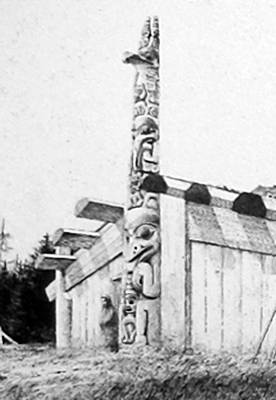
The pole in situ, forming part of the exterior of a building.
GyaaGang (House-front pole)
Haida
T'annu Llnagaay (Tanu, Haida Gwaii)
Red cedar ca 1870
BC Totem Pole Preservation Committee purchase, 1954
A50000 a-d
This pole once stood before a dwelling named 'Plenty of Tliman-Hides in this House' which Haida histories record belonged to the clan named Those Born at Qadasgo Creek. The meaning of 'TLIMAN' is no longer known. The pole was cut into four sections when it was removed and shipped from its original site.
Carved figures, as displayed from front to back:
Grizzly bear, with human wearing ringed hat (base of pole)
Cormorant, with small human-like figure
Eagle (missing beak) with small human-like eagle
Three watchmen (top of pole)
Illustration: Gordon Miller, 1982
Source: Display, Museum of Anthropology, University of British Columbia
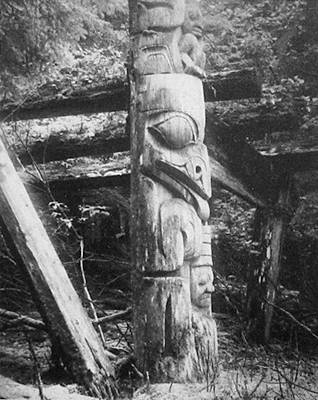
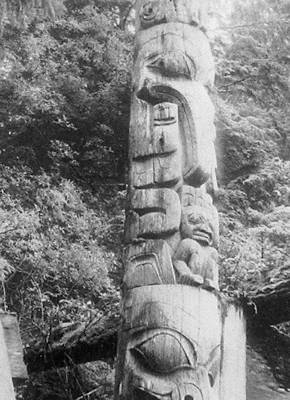
The pole before it was removed for safekeeping.
Photo: (left) Marius Barbeau, 1947, 102737
Photo: (right) Marius Barbeau, 1947, CMC 102721
Source: Display, Museum of Anthropology, University of British Columbia

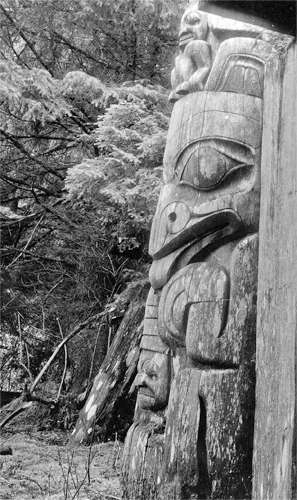
The pole before it was removed for safekeeping.
Side profile of the grizzly bear from the base of the frontal pole. In between the bear’s paws is a human head wearing potlatch cylinders.
Photo: © C.M. Barbeau, 1947
Permission: Courtesy George MacDonald, Director, Bill Reid Centre for NWC Art Studies at Simon Fraser University, Vancouver, BC.


On the left I have put the pieces together so that the reader can form a better idea of how the pole would have looked originally, and on the right is an historical photo of the pole in situ, photo by Wilson Duff, 1954.
Wilson Duff (1925-76) was a Canadian archaeologist, cultural anthropologist, and museum curator.
He is remembered for his research on First Nations cultures of the Northwest Coast, notably the Tsimshian, Gitxsan, and Haida, and especially for his interest in their plastic arts, such as totem poles. Along with Bill Holm and Harry Hawthorn, he was one of a small coterie of academics in the 1950s and '60s who worked to bring Northwest Coast art to international prominence. (This text from Wikipedia)
Photo: (left) Don Hitchcock 2012
Photo: (right) Wilson Duff, 1954, RBCM, PN 5792.
Source: Display, Museum of Anthropology, University of British Columbia
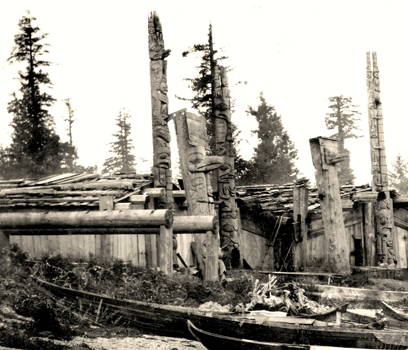
Tanu Village, Haida Gwaii, 1878, from which the pole above originally came.
Photo: George Dawson
Source: http://www.billreidgallery.ca/Programs/SFUPrograms.php
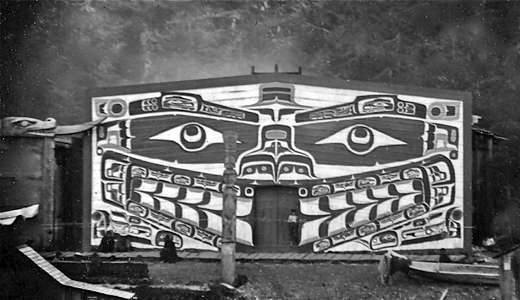
This brightly painted house at Gwayasdums village belonged to Chief John Scow / Skow. The house was erected around the year 1900 and depicts the face of a sea monster.
The sea monster design is traditionally the property of the ‘Namgis tribe but the privilege of displaying this crest was transferred to Chief Scow after his marriage to a ‘Namgis woman.
A carved figure stands in front with a copper on its head. It is referred to as 'in remembrance of the sale of a copper'.
'According to my grandparents, a long time ago the Sea Monster Numkalagyu emerged from the bottom of the sea in Blackfish Sound. He came to shore and helped found a group of people called 'Namgis. In order to portray what he had seen in his travels and the supernatural powers he obtained, this ancestor used the Sea Monster design on his house. Ever since that time, only people of the 'Namgis tribe and certain in-laws have had the privilege of using this design' (Chief Bill Scow,1981).
Language group: Kwakwaka'wakw
Village: Gwayasdums / Gwaestums (Gilford Island)
Photo: © C. F. Newcombe, 1900
Permission and text: Courtesy George MacDonald, Director, Bill Reid Centre for NWC Art Studies at Simon Fraser University, Vancouver, BC.
Additional text: http://www.sfu.ca/brc/virtual_village/Kwakwaka_wakw/gwayasdums--gilford-island-/chief-scow-s-house.html
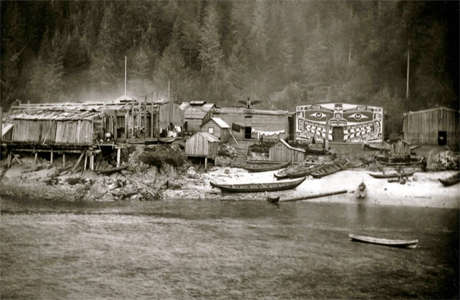
The housefront painting seen here inspired a reconstruction at The Royal British Columbia Museums Totem Park. Also of note is the sisiutl and thunderbird figures atop the adjacent building. The sisiutl (double headed serpent) is one of the most powerful crests and mythological creatures of the Kwaka'wakw and other indigenous peoples of the Pacific Northwest.
The house with the sisiutl belonged to Chief Sewid. The painted house on the right belonged to Chief Skow.
(This is a very valuable photograph which puts the Sea Monster House in perspective in its environment. The canoes drawn up on shore were a vital part of the life of the community, providing a basis for transport, trade, and fishing - Don )
Language group: Kwakwaka'wakw
Village: Gwayasdums / Gwaestums (Gilford Island)
Photo: © C. F. Newcombe, 1900
Permission and text: Courtesy George MacDonald, Director, Bill Reid Centre for NWC Art Studies at Simon Fraser University, Vancouver, BC.
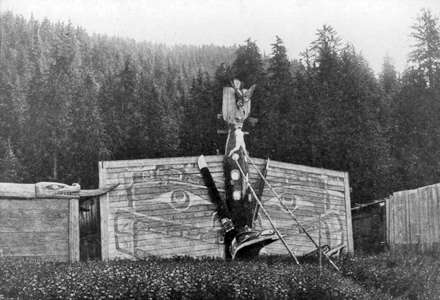
The Sea Monster House of Chief Skow / Scow with frontal pole in place and sea monster housefront painting still visible. A replica of this pole is now at the Burke Museum, University of Washington. One of the heads of the sisiutl (two headed serpent) atop the neighbouring house is also visible.
At the entry to the house stands a pole with Scow's principal crests. It depicts a whale with an ancestor on its back and a raven between its tail flukes. This pole was the second pole that Mungo Martin ever carved.
It was Kwakwaka'wakw artists like Mungo Martin, Charley James, Arthur Shaughnessy and Willie Seaweed who kept carving traditions active when the Canadian government prohibited the potlatch ceremony in 1885. The potlatch is a ceremony that validates the status of high ranking families and is often accompanied by a totem pole raising. Events of this kind were largely practised in secret until the ban was lifted in 1951.
Language group: Kwakwaka'wakw
Village: Gwayasdums / Gwaestums (Gilford Island)
Photo: © E. P. Curtis, 1912
Permission and text: Courtesy George MacDonald, Director, Bill Reid Centre for NWC Art Studies at Simon Fraser University, Vancouver, BC.
Additional text: http://www.sfu.ca/brc/virtual_village/Kwakwaka_wakw/gwayasdums--gilford-island-/chief-scow-s-house.html
A House Portal Pole is a tall pole standing at the centre of the house front. It rose above the house with the open mouth of the creature at the base forming the entrance. when European style doors were later built into houses no opening was cut and the pole became a frontal pole.
Text above: http://www.sfu.ca/brc/art_architecture/totem_poles.html

Chief Skow's Sea Monster House with faded paint and frontal pole in place. This house was later re-modelled with a raven crest painting and a raven's head protruding from above the entryway.
Language group: Kwakwaka'wakw
Village: Gwayasdums / Gwaestums (Gilford Island)
Photo: © Sam Barrett, 1915
Permission and text: Courtesy George MacDonald, Director, Bill Reid Centre for NWC Art Studies at Simon Fraser University, Vancouver, BC.
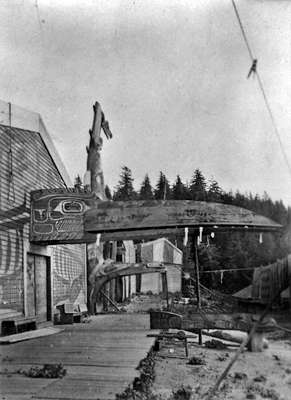
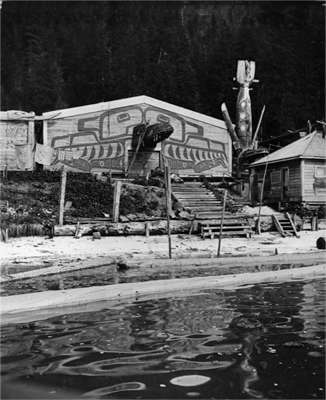
The Raven House housefront was formerly painted as a sea monster but has been re-created here as a raven with its head protruding from above the entry way. The mouth of the raven was rigged to open and be used as an entry during potlatches. There is a large pole carved by Mungo Martin on the far side of the house which formerly stood at the entry.
(Note the carving of a Sculpin, a bony fish, in front of the house, seen clearly in the photo on the left. This is a fascinating sculpture, essentially a totem pole designed to be displayed horizontally - Don )
By 1915 Chief Scow had become a widower and married a noble Heiltsuk woman. The old Sea Monster House was torn down and was reconstructed on the same spot. Similarly to the crest of the Sea Monster, included in his new wife's dowry was the Raven image painted on the new structure. As the pictures show, the frontal pole was kept but moved to the side of the house.
This housefront is painted as a raven with a head protruding above the entry way. There is a large pole standing on the far side of the house which once stood at the entry.
Scow's House - Skow House, Gwaestums
Language group: Kwakwaka'wakw
Village: Gwayasdums (Gilford Island)
Photo: © C. F. Newcombe, 1917
Permission and text: Courtesy George MacDonald, Director, Bill Reid Centre for NWC Art Studies at Simon Fraser University, Vancouver, BC.
Carved Figures
Large scale art of the coast goes beyond the carving of large poles. Artists also created a wide range of human and animal figures. Some smaller or larger than life. These works are generally commissioned by the head of a household, and also play a specific part in ceremonial and spiritual life.
Text above: http://www.sfu.ca/brc/art_architecture/totem_poles.html
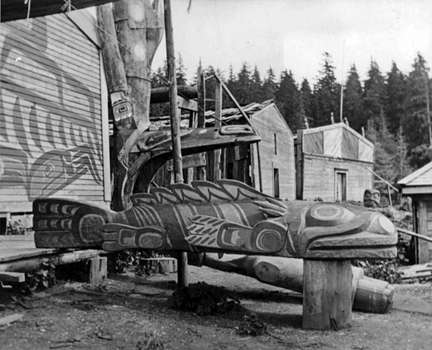
Sculpin (spiny fish) effigy in front of the Raven House with a carved human figure on the far side. This figure was later placed on top of the fish and used to support the raven's head protruding from the housefront. Also notable in this photo are the four figures on the gable of the house in the background and the large carving of a human head on the ground in front of the same house.
Language group: Kwakwaka'wakw
Village: Gwayasdums / Gwaestums (Gilford Island)
Photo: © C. F. Newcombe, 1917
Permission and text: Courtesy George MacDonald, Director, Bill Reid Centre for NWC Art Studies at Simon Fraser University, Vancouver, BC.
Additional text: http://www.sfu.ca/brc/virtual_village/Kwakwaka_wakw/gwayasdums--gilford-island-/chief-scow-s-house.html
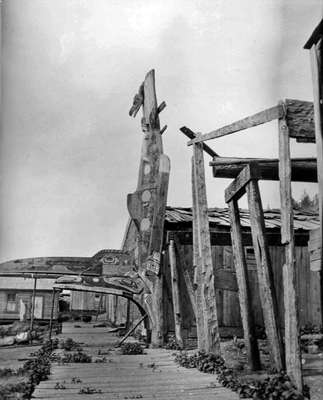
In this photo we can see the Sea Monster House Entry Pole, with the Raven Pole behind it. The Sea Monster House Entry Pole was re-erected to one side of the house when the Sea Monster House became the Raven House. The Sea Monster House Entry Pole was the second pole that Mungo Martin carved. The pole is now a part of the Hauberg collection at the Seattle Art Museum.
Language group: Kwakwaka'wakw
Village: Gwayasdums / Gwaestums (Gilford Island)
Photo: © C. F. Newcombe, 1917
Permission and text: Courtesy George MacDonald, Director, Bill Reid Centre for NWC Art Studies at Simon Fraser University, Vancouver, BC.
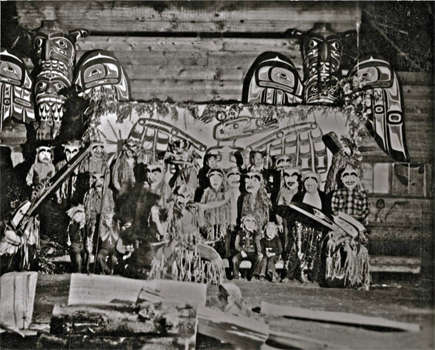
Interior of Johnny Scow's House with Atlakim dancers. The Atlakim dance is a winter ceremonial dance using forty masks, each with associated songs and dances. It celebrates the different guardian spirit powers to be found in the forest. The masks seen here are now in UBC and Denver collections. The posts are now in the Seattle Art Museum.
(Note the good condition of the interior posts, and the textile backdrop painted with a thunderbird image. The photo was taken using flash, possibly a magnesium flare - Don )
Language group: Kwakwaka'wakw
Village: Gwayasdums / Gwaestums (Gilford Island)
Photo: unknown
Permission and text: Courtesy George MacDonald, Director, Bill Reid Centre for NWC Art Studies at Simon Fraser University, Vancouver, BC.
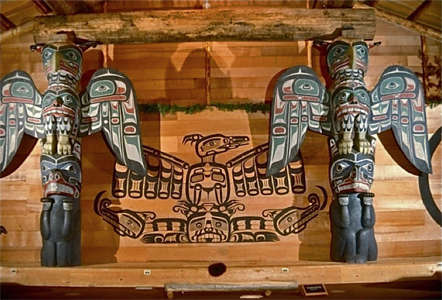
Re-creation of the rear interior of Chief Skow's Raven House using the original poles. These posts are now housed at the Seattle Art Museum. The posts were carved by Arthur Shaughnessy.
(Note the Thunderbird painted on the wall, possibly recreated from the photo of the Atlakim dancers above, and below it a Sisiutl. Sisiutl are frequently depicted as a two headed sea serpent or snake with a human-like head (and hands) in the middle of the body. All three heads are surmounted by 'horns of power', also seen on thunderbirds. - Don )
Language group: Kwakwaka'wakw
Village: Gwayasdums / Gwaestums (Gilford Island)
Photo: © B. Herem, 1980
Permission and text: Courtesy George MacDonald, Director, Bill Reid Centre for NWC Art Studies at Simon Fraser University, Vancouver, BC.
Additional text: Wikipedia

Re-creation of the interior entry of Chief Skow's Sea Monster House using the original poles. These poles now reside at the Seattle Art Museum.
(Note the Dzunuk'wa, the wild woman of the forest, at the base of each of these poles, with her characteristic pursed lips - Don )
Language group: Kwakwaka'wakw
Village: Gwayasdums / Gwaestums (Gilford Island)
Photo: © Bill Holm, 1981
Permission and text: Courtesy George MacDonald, Director, Bill Reid Centre for NWC Art Studies at Simon Fraser University, Vancouver, BC.

House at Musqueam, circa 1913
Tsimalano house post shown on right. House post with name Capilano shown on left. Unidentified woman and child. Photo RBCM taken for the land commission#8 666, #PN 6696 (?)
Jack Stogan, circa 1913-1916
Jack Stogan passed down his Musqueam name, Tsimalano, to his son Vince Stogan. Jack Stogan is shown on the right, standing in front of his house at Musqueam. Note the Tsimalano house post on the far right.
Source: RBCM, #P 12274, Display, Museum of Anthropology, University of British Columbia
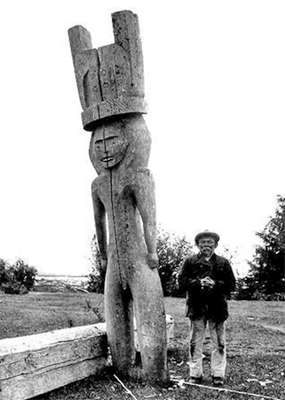
Musqueam house post of Capilano, 1898.
The Musqueam warrior Capilano (giyeplénexw) was famous for having fought the ferocious invading Lekwiltok warriors from Kwakwaka'wakw Territory. A carving representing Capilano (right) was photographed in 1898 at the Musqueam village located on present day Point Grey. The huge cedar house post was said to have been carved at the Capilano River in North Vancouver and towed across the Burrard Inlet to support a beam in a house built by Capilano II, the nephew of Capilano. Standing beside the house post is Charlie, Capilano III, nephew of Capilano II.
At Allard Hall, UBC, there is now a replica of this carved by Musqueam artist Brent Sparrow.
The post is a replica of a post depicting the Musqueam warrior Capilano (qíyəplènəxʷ), which was first installed in the late 1800s at the Musqueam village located on present-day Point Grey.
Photo: American Museum of Natural History
Text and source: http://www.firstnations.de/development/coast_salish.htm

On February 16, 2012 a 41- foot house post carved by Coast Salish artist Brent Sparrow was installed outside Allard Hall, UBC, Vancouver.
The post is a replica of a post depicting the Musqueam warrior Capilano (qíyəplènəxʷ), which was first installed in the late 1800's at the Musqueam village located on present-day Point Grey.
Photo and text: http://www.facebook.com/media/set/?set=a.368455666499834.94202.180644975280905&type=3

On March 20th 2012, a group of about 70 faculty, staff, students, alumni, and friends gathered in front of Allard Hall for a ceremonial affair to honour the newly raised First Nations Musqueam house post. Musqueam artist, Brent Sparrow Jr. was commissioned to carve this house post which depicts the human figure of qiyəplenəxʷ (Capilano). A number of representatives from the university, law school, and Musqueam Nation spoke about what this house post meant to each of them.
Dean Bobinski noted that the post celebrates the Musqueam leader, qiyəplenəxʷ. Although many people associate this name with the suspension bridge in North Vancouver, the Dean acknowledged that qiyəplenəxʷ is widely recognised for leading the [Musqueam] people in defending their territory, laws, and customs. In many ways this can be correlated with the types of work that students, faculty, and the Musqueam do today on this land when learning about and defending our legal values.
Cultural leader and band councillor, Howard Grant spoke on behalf of the artist, as is the practice with the Musqueam. Howard said that Brent was 'honoured to carve this house post as a way of commemorating the institution and what they’re defending'. The land where UBC stands has long been known as a place of defence for the Musqueam. In the past, this area was a strategic fortification site, known as q’ələχən, where Musqueam warriors and their families resided to protect the land from marauders.
Howard Grant also expressed that Brent was thankful to the selection committee for choosing him to carve the house post as well as to those who were in attendance and witnessed the ceremony.
Musqueam Elder Larry Grant spoke in hən’q'əmin’əm’, a Coast Salish dialect, followed by an English translation. He welcomed the public to the traditional, ancestral, and unceded territory of the Musqueam people and highlighted that the Musqueam have never formally surrendered or given up the territory upon which the university sits.
Photo and text adapted from: http://ubclegaleye.wordpress.com/2012/09/10/the-new-musqueam-house-post-at-allard-hall/
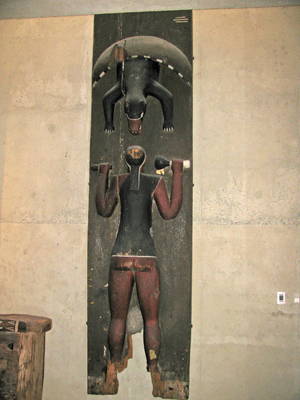
Tsimalano house post from Musqueam, late 19th century
Gift to UBC from the Graduating Class of 1927 A50004
' This one here is originally the house post of my Great Grandfather Tsimalano.
My name is Vince Stogan. I was chosen by my elders to carry the name Tsimalano which has been handed down generation after generation. We're known now as the Stogan family. Our people used to live in longhouses. Each longhouse had its own house post. This one here is originally the house post of my great-grandfather Tsimalano'.
This house post shows a man and a bear. The standing man has a knife and a rattler.
When they got close to an animal with the rattler, they would sing a song to hypnotise the animal.
Photo: Don Hitchcock 2012
Source: Display, Museum of Anthropology, University of British Columbia

Man and Bear House Post, Stanley Park 1938
Photo: James Crookall
Donation: Doris Crookall in 1979
Source: http://searcharchives.vancouver.ca/totem-pole-13;rad
Permission: Public Domain
We were rich people by having all that
'On this house post there is a man and a bear. The man you see standing there… has a knife and a rattler. That's what my Dad, Jack Stogan, was saying. When they'd reach an animal… with the rattler… they would sing a song… to hypnotise the animal. It indicates how our people used to live a long time ago. They had all kinds of salmon, all kinds of wildlife… we were rich people by having all that.'
To indicate whose house you're walking into
'They'd have them on each side of the door… of the main entrance… to indicate whose family house you're walking into. Each longhouse had a male and a female on each side of the door as you walk into a longhouse. Each house post had its own design… they weren't all like this. This one here indicated that it was the house of Tsimalano. Now we have one longhouse for the Musqueam community.'
Text below from http://www.musqueam.bc.ca/our-story
The Musqueam people have been present in what is now Greater Vancouver for several thousands of years. Archaeological journals have recorded evidence of Musqueam’s existence in this area, particularly the Marpole midden - located at the mouth of the North Arm of the Fraser River, in excess of 4,000 years and at the Musqueam reserve in excess of 3,500 years. Over 143 heritage sites were recorded in Musqueam Traditional Territory in Musqueam’s 1984 Comprehensive Land Claims submission to Canada. In the interim eighteen sites have been documented for a total of 161.
Current Musqueam values and teachings are based on our traditional culture. A major part of these teachings and values is the kinship system. Family and relations are more closely defined in Musqueam’s teachings than in Euro-Canadian ways. Traditionally, large extended families lived close together and the children were taught the importance of family and family history. Our people lived in multi-family homes that have been called bighouses. Large extended families lived in one house (parents, grandparents, aunts, uncles, children, etc.) These families shared in all the tasks and chores of a household. Yet, each nuclear family was kept separate by partitions often made of bulrush mats. When it came to the teachings and the learning of the traditional ways everybody partook in this informal education process. It was very important that our customary system of authority be taught to the young people. Power was given and controlled within the families. When a problem arose in the community each house was represented by a person who was selected by the family to represent them – to be the head of the family on that particular issue. There was no formal structural level of government as there is today.
That's why it's here
'There is supposed to be a male and a female house post, but I'm sorry to say that the [female house post] was destroyed. We had them stored underneath the church. So my late brother, Walker Stogan, said: 'Let's take [this one] down to the University for safe-keeping'… that's why it's here. And I hope everyone will understand now that we brought it here so that people can see… that a long time ago… the only poles we had were house posts.'
From: http://www.snuneymuxwvoices.ca/english/post.asp
Traditionally, the Coast Salish people did not carve totem poles. Totem poles are usually free-standing poles with images depicting crests that belong to families. The Snuneymuxw and other Coast Salish peoples did carve grave figures, cedar planks for big house walls, and house posts, which could support beams inside a house or stand outside a big house.
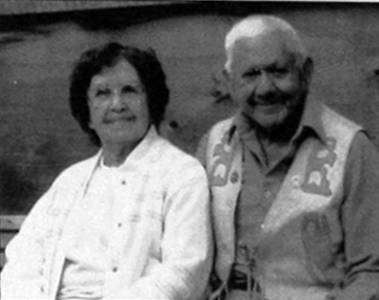
Musqueam Elders Vince Stogan and wife Edna Stogan 1996.
Vince Stogan was a locally and internationally respected elder, teacher, and spiritual leader. He was awarded an honorary degree (Doctor of Laws) from the University of British Columbia. This label was created to acknowledge and thank the Stogan family for their many contributions to the Museum of Anthropology. Dr Vince Stogan passed away June 29, 2000.
Photo: Bill McLennan
Source: Display, Museum of Anthropology, University of British Columbia
The Kwakwaka'wakw, or Kwak'wala-speaking people, are today represented by eighteen tribes or nations. Their traditional territories extend over the north-eastern side of Vancouver Island to the adjacent coastal mainland of British Columbia, encompassing many islands, mountain ranges, and river systems.
In the beginning, the Kwakwaka'wakw people emerged from mystical and supernatural origins of transformation at special places. These places became the territorial landmarks that defined the Kwakwaka'wakw ownership and domain.
The first ancestors multiplied and are the current membership of the Kwak'wala-speaking people. From the beginning they were bound by the common language of Kwak'wala. They were bound by a common geography. There emerged a common belief system, and a network of First Nations societies.
House Post
Depending on the style of the house, one large single post at the rear wall and a pair of posts at the front (or two pairs, one at the front and one at the rear) support the main beams of the roof. These posts often carry carvings that also represented family lineages and histories.
Text above: http://www.sfu.ca/brc/art_architecture/totem_poles.html

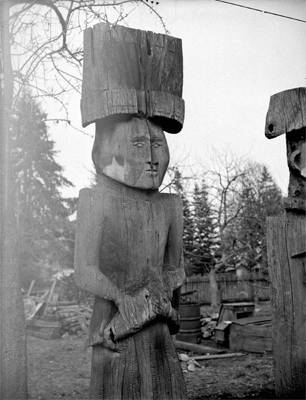
Cowichan Indian totems. These totems are inside house posts, originally they would have stood inside the house and supported house beams.
Photo: Williams Bros. Photographers Collection
Donated by Donn B.A. Williams in 1987
Source: http://searcharchives.vancouver.ca/cowichan-indian-totem-inside-house-posts;rad , http://searcharchives.vancouver.ca/cowichan-indian-totem;rad
Permission: Public Domain

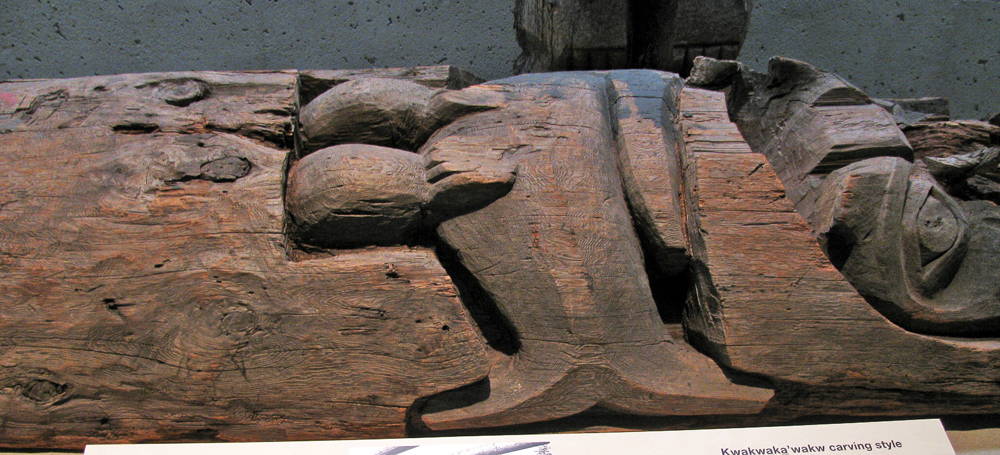
Dlam (Interior house post)
Photo (top): Don Hitchcock 2012, panorama of three photos stitched together
Photo (bottom): Don Hitchcock 2012, detail of the lower part of the Dlam
Source: Display, Museum of Anthropology, University of British Columbia
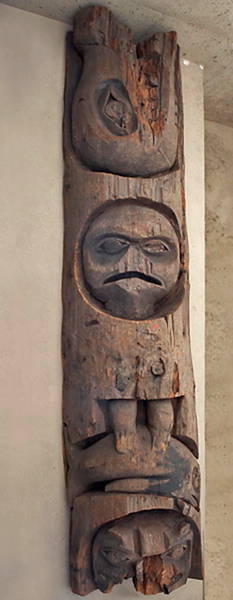

Dlam (Interior house post) as shown in the photo above, including a detail of a face carved in the post.
Kwakwaka'wakw, Kwagu'ł tribe, Fort Rupert BC.
Red cedar, ca 1890. Committee on Totem Poles purchase, 1947.
Photo: http://www.rrnpilot.org/items/17788
Source: Display, Museum of Anthropology, University of British Columbia
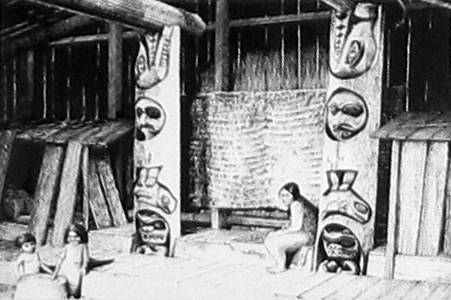
Dlam (Interior house post) as shown in the photo above, which seems to be the one shown here on the left.
Kwakwaka'wakw, Kwagu'ł tribe, Fort Rupert BC.
Red cedar, ca 1890. Committee on Totem Poles purchase, 1947.
Source: Display, Museum of Anthropology, University of British Columbia
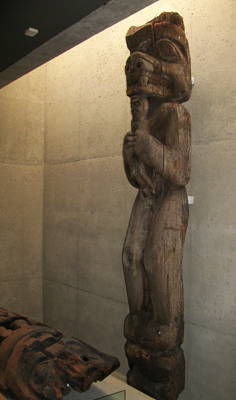

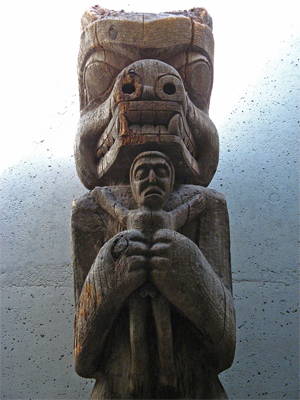
Dlam (interior house post)
Kwakwaka'wakw (Hope Island, BC)
Red cedar, 1900.
BC Totem Pole Preservation committee purchase, 1956.
A50007c
Height 430 cm, width 67 cm, depth 75 cm
This carved post from the house of Ha'm'ca depicts a bear holding a small human in its paws. Perhaps it tells of the encounter of an ancestor with a supernatural being, or proclaims the defeat of a rival.
Photo (left): Don Hitchcock 2012
Photo (centre): http://www.rrnpilot.org/
Photo (right): Darko, http://my.opera.com/gdare/albums/showpic.dml, Access Publicly available
Source: Display, Museum of Anthropology, University of British Columbia
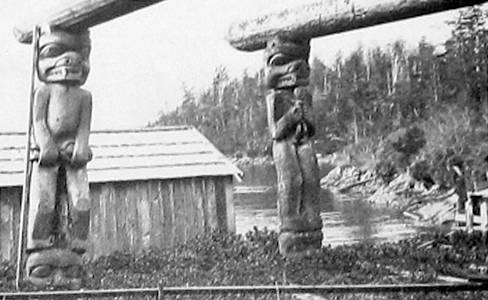 Kwakwaka'wakw house posts.
Kwakwaka'wakw house posts.
The one on the right is shown in the photographs above.
Today, as in the past, totem poles are raised for different reasons. The two poles displayed here are carved interior house posts. As supports for enormous roof beams, they stood as part of the architecture of large dwellings designed to house several related families.
They also stood as dramatic sculptures depicting the supernatural ancestors and histories of the chief's na'mima, or 'people of one kind'.
Kwakwaka'wakw carving style
Distinctive styles of carving and painting belong to the different First Nations of the Northwest Coast. The development of these styles over time can be seen in the ways that artists stylised or abstracted animal and human figures. These house posts are sculpted in a style we can recognise as Kwakwaka'wakw. Figures are deeply carved, often with exaggerated features but somewhat naturalistic head and body proportions.
Source: Display, Museum of Anthropology, University of British Columbia

Carved interior house posts. A man and woman are being supported by grizzly bears with a double sea lion lintel on top. These house posts stood in the entry way to Chief Herbert (Copper) Johnson's house.
Language Group: Kwakwaka'wakw
Village: Gwayasdums (Gilford Island)
Photo: © Sam Barrett 1915
Permission: Courtesy George MacDonald, Director, Bill Reid Centre for NWC Art Studies at Simon Fraser University, Vancouver, BC.
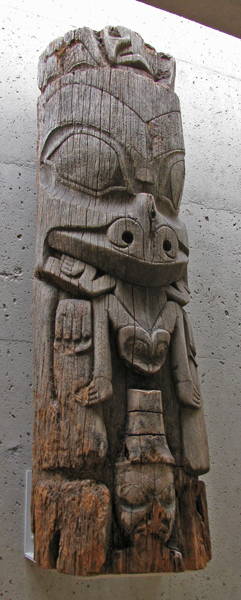 Red cedar totem pole fragment.
Red cedar totem pole fragment.
Culture: Haida: Kunghit
From Ninstints, Skunggwai
Base portion of a totem pole, crescent shaped in cross-section, carved in shallow and deep relief. Seated grizzly bear, with a partial human face between its squared, erect ears; curled nostrils; upturned mouth holds hindquarters of a frog which hangs between the bear's upright human hands with four fingers folded over each palm. A human face wearing a two ringed hat appears between bear's legs. Faint traces of light blue are apparent in eye socket areas, red in nostrils, and black on pupils.
History Of Use: Stood outside against the centre of front wall of a small unnamed house, possibly a mortuary house of Chief Ninstints (Duff and Kew) although Macdonald considers this unlikely.
Ninstints was abandoned in the 1880's. The pole was still intact in 1901, at which time it had, from the top down: a separate eagle; a three ringed hat; a supernatural snag; and a whale. The following people assisted with this expedition: Smyly, John; Atkins, Bernard; Reid, Bill; Duncan, Kelly; Jones, Roy; Jones, Clarence; Jones, Frank.
Made in Ninstints, British Columbia, Canada and Skunggwai, British Columbia, Canada during 1850
Collected by Wilson Duff, Michael Kew, Harry Hawthorn and Wayne Suttles between June 1957 and July 1957
Owned by Skidegate Band Council in Trust
Owned by British Columbia Totem Pole Preservation Committee before July 1957
Received from British Columbia Totem Pole Preservation Committee (Transferring institution) during July 1957
Name: House Frontal Totem Pole
Identification Number: A50012
Type of Item: carved, hollowed and painted cedar wood and paint totem pole
Overall: height 270 cm, width 90 cm, depth 40 cm
Made in: Ninstints, British Columbia, Canada and Skunggwai, British Columbia, Canada
Condition: fair, Accession number: 2113/1
Field Collector: Wilson Duff, Michael Kew, Harry Hawthorn and Wayne Suttles
Previous Owner: Skidegate Band Council in Trust and British Columbia Totem Pole Preservation Committee
Received from: British Columbia Totem Pole Preservation Committee (Transferring institution)
Collection Date: between June 1957 and July 1957
Photo: Don Hitchcock 2012
Text: http://www.rrnpilot.org/items/10054
Source: Display, Museum of Anthropology, University of British Columbia
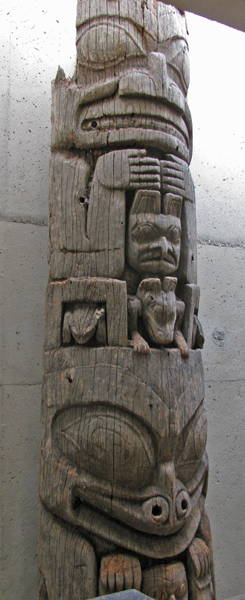 Naaxwa GyaaGang (Interior house post)
Naaxwa GyaaGang (Interior house post)
Haida: Kunghit
SGaang Gwaay Linagaay (Ninstints, Haida Gwaii, BC)
Red cedar and metal, carved and hollowed, 1850 or earlier
BC Totem Pole Preservation Committee purchase, 1957
A50016
This house post once stood against the back wall of a lineage house named Xuuya Naay, or Raven House. As well as supporting one end of the main roof beam, it displayed the inherited privileges belonging to Taajuu 'Laanas: Wind Place Family. When it was photographed in 1901, at least 50 years after it was carved, Raven House had already been abandoned for several decades. A series of epidemic diseases, including smallpox, had devastated the Haida population.
Carved figures, base to top:
Bear with human between forelegs, cub between ears, and frogs in ears. Human with unknown creature beneath hands.
Totem, crescent shaped in cross section, carved in shallow and deep relief. From top to bottom: human with hands at right angles and fingertips touching. The arms are folded with the elbows resting on squared ears of figure below. Enclosed within this frame is a small human/hawk face with beak, surmounting the head, shoulders, and forepaws of an emerging bear cub. At the base is a bear from whose ears frogs look downward. The bear has curled nostrils; upturned mouth, raised forearms with five fingers folded over each palm, small human face between forearms.
Stood at centre of back wall inside house called 'Raven House', belonging to the lineage of the'Sand Town People' of Raven moiety of Kunghit Haida. MacDonald lists it as house number 17.
Pole standing when collected. The following people assisted with this expedition; Smyly, John; Atkins, Bernard; Reid, Bill; Duncan, Kelly; Jones, Roy; Jones, Clarence; Jones, Frank.
Figures are crests belonging to the lineage of the owners of the house, the 'Sand Town People' of the Raven moiety. They may also refer to the Bear Mother myth.
Made in Ninstints, British Columbia, Canada and Skunggwai, British Columbia, Canada before 1900
Collected by Wilson Duff, Michael Kew, Harry Hawthorn and Wayne Suttles between June 1957 and July 1957
Owned by Skidegate Band Council in Trust
Overall: height 400 cm, width 130 cm, depth 50 cm
Accession number: 2113/5
Field Collector: Wilson Duff, Michael Kew, Harry Hawthorn and Wayne Suttles
Previous Owner: Skidegate Band Council in Trust and British Columbia Totem Pole Preservation Committee
Collection Date: between June 1957 and July 1957
Photo: Don Hitchcock 2012
Text: http://www.rrnpilot.org/items/10203
Source: Display, Museum of Anthropology, University of British Columbia

Illustration of the pole in situ in 1850, a photograph of the pole from 1901, and the examination of the pole in 1957, one hundred years after it was first carved.
Source: Display, Museum of Anthropology, University of British Columbia
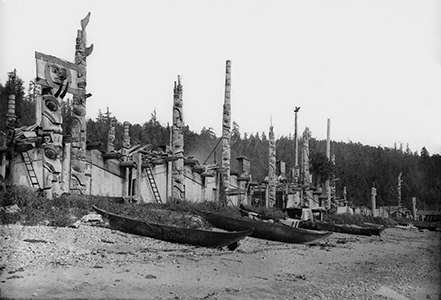
Skidegate Haida Village in the Queen Charlotte Islands, July 1878.
Photo: George M. Dawson/Library and Archives Canada/PA-037756
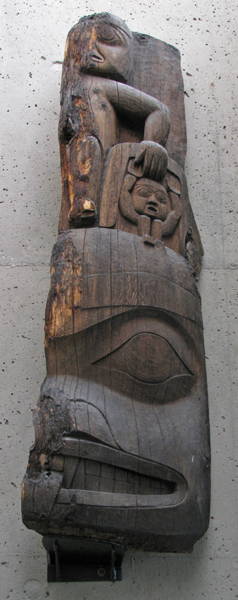
Gyedem gan (Totem pole)
Gitanyow (formerly Kiwancool, BC)
Red cedar, paint; ca 1890
Gift of Walter C. Koerner, 1976
(Presented in 1960 to Walter C. Koerner, financial supporter of the Kitwancool Totem Pole Restoration Project, by the Gitanyow Wolf Clan)
A2546
If this were the only thing you could see here, the little man in the ear,
it would be worth the price of admission.
Bill Reid
Rectangular wooden pole fragment. Carved in the bottom is a bear head with large ovoid eyes, a slightly protruding snout, teeth, a protruding tongue and pointed ears. Within its ear is a small human figure. Upon the animal’s head stands a human figure with an arm extended down to the figure in the ear. Pole is unpainted.
This pole fragment was removed from Kitwancool in 1960 and was a gift from the Wolf Clan to Walter C. Koerner. It was removed by the Kitwancool Totem Pole Restoration Project, supervised by Wilson Duff, British Columbia Provincial Museum, with financial support from Walter C. Koerner.
Made in Kitwancool, British Columbia, Canada before 1900
Received from Walter C. Koerner (Donor) on April 8, 1976
Identification Number: A2546
Height 194 cm, width 58 cm, depth 30 cm
Accession number: 336/36
Photo: Don Hitchcock 2012
Source and some text: Display, Museum of Anthropology, University of British Columbia
Additional text: http://www.rrnpilot.org/items/12192
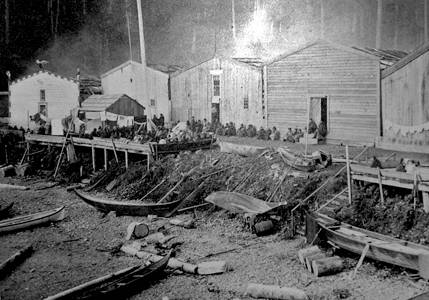
Kwakwaka'wakw villages
In myth time, the first ancestors brought their houses from the supernatural world, or built new ones where they chose to stay. These are the origin sites on which Kwakwaka'wakw villages came to be established.
Towards the late 1800s, the impacts of colonisation and population decline meant that while some villages remained on these sites, others amalgamated or were left empty as people moved to take part in a changing economy.
A photograph by Charles Frederic Newcombe shows people gathered in front of cedar-plank houses, their canoes pulled up on the beach, for a potlatch held at Xwamdasbe' in 1899.
Photo: Charles Frederic Newcombe, 1899, RBCM PN 238
Source: Display, Museum of Anthropology, University of British Columbia
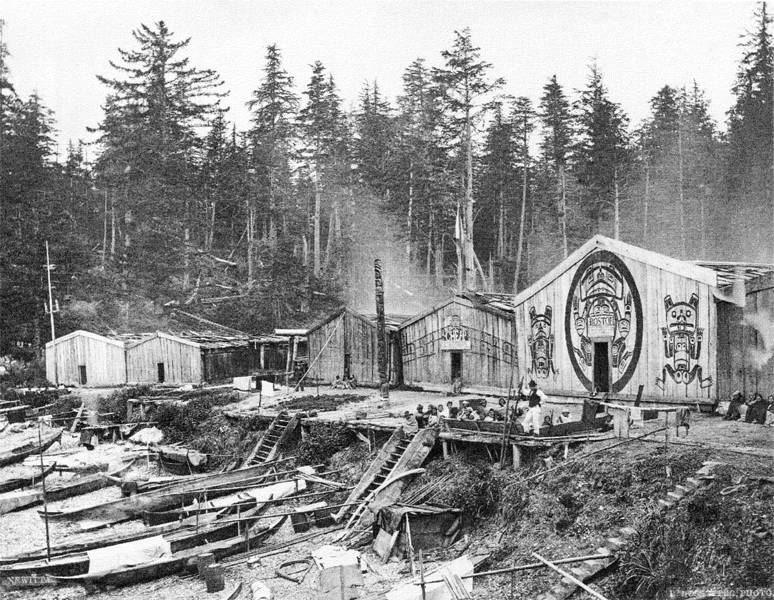
Edward Dossetter photograph taken at the Kwakwaka'wakw village of Xwamdasbe' on Hope Island in 1881.
Painted signs over the entrances to two of the Big Houses proclaim the high social status of their owners.
Photo: Edward Dossetter
Source: American Museum of Natural History Negative No. 42298 in Savard (2005)
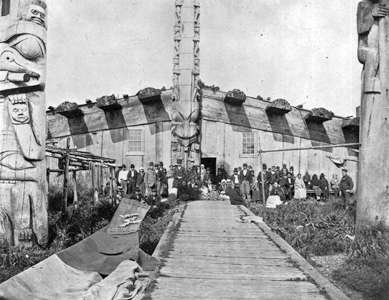
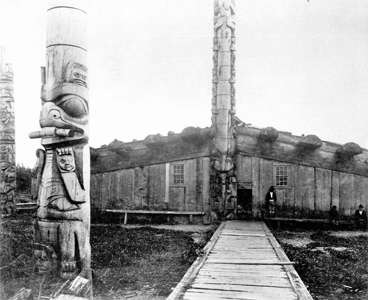
(left) Inhabitants of the Monster House with Israel Powell (on left), the first Indian superintendent of British Columbia, 1879.
(right) View of Chief Wiah's Monster House from its boardwalk that stretched from the house to the beach.
The memorial pole on the left is virtually identical to to the interior pole of the house.
Language group: Haida
Village: Masset, Graham Island, Queen Charlotte Islands
Photo: (left) © O.C. Hastings, 1879
Photo: (right) © B. Buxton, 1882
Permission: Courtesy George MacDonald, Director, Bill Reid Centre for NWC Art Studies at Simon Fraser University, Vancouver, BC.
Memorial Pole:
About a year after an important chiefs death, his successor raised a pole in his memory. These poles depicted the appropriate crests and symbols that represented outstanding achievements or events in the life of the deceased chief. A memorial pole can also be raised for a high-ranking person whose life achievements merit the honour.
Text above: http://www.sfu.ca/brc/art_architecture/totem_poles.html
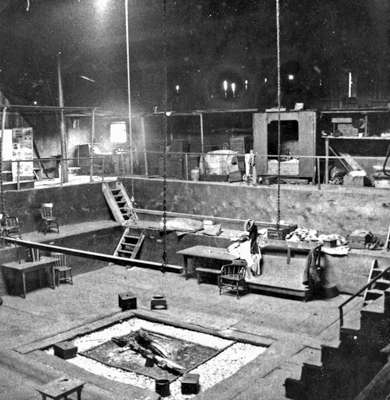
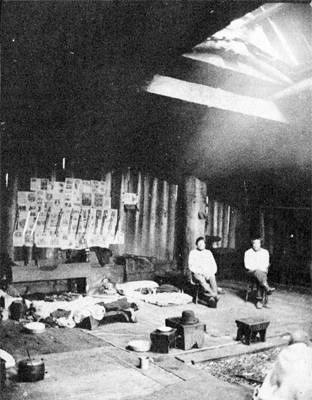
(left) Interior view of Chief Wi:ha's 'Monster' House, 1884, when the house was still occupied.
(right) Interior view of Chief Anetlas' 'Star' House.
Richard Maynard took both photographs at the Haida village of rad raci7waas (Massett) in 1884. These modified Victoria cards (measuring 82 mm x 125 mm) are the earliest extant photographs that record the interior of houses on Haida Gwaii. The view inside Chief Anetlas' house is less well-known but documents three people, Chief Anetlas and another man sitting on chairs. A third man, wearing a blanket, is squatting beside the central fire pit. The seated men are relaxed with legs crossed and arms folded and appear to be comfortable with having their photograph taken.
These photographs are all the more remarkable when you consider that an estimated exposure of three to five minutes was required, for example, to make the photograph of Chief Wi:ha's house.
Language group: Haida
Village: Masset, Graham Island, Queen Charlotte Islands
Photo: (left) © Richard Maynard
Permission: Courtesy George MacDonald, Director, Bill Reid Centre for NWC Art Studies at Simon Fraser University, Vancouver, BC.
Text: Savard (2005)
Photo: (right) © Richard Maynard, Royal British Columbia Museum PN5325, in Savard (2005)
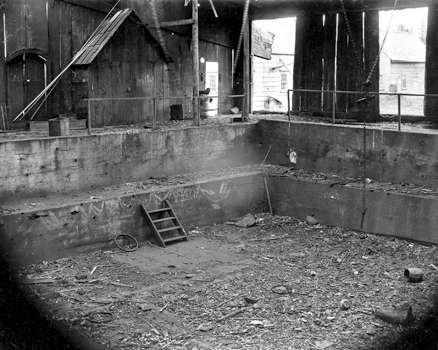
The interior of the Monster House showing the house pit, and Chief Wiah's sleeping compartment.
(Note that the house is in disrepair, and abandoned by 1898 - Don )
Language group: Haida
Village: Masset, Graham Island, Queen Charlotte Islands
Photo: © G. Dorsey, 1898
Permission: Courtesy George MacDonald, Director, Bill Reid Centre for NWC Art Studies at Simon Fraser University, Vancouver, BC.


This Monster House interior pole once stood at the rear of the Monster House. The pole represented Chief Wiah’s crest of a standing beaver with potlatch rings and the crest of a sculpin fish prominently displayed on its abdomen.
Harry Wiah, son of Chief Wiah, stands on the left.
It is very similar to the memorial pole that stood outside the house suggesting that they are by the same carver. The stick that the beaver holds is inlaid with multiple pieces of abalone, and a detachable stack of cylinders has been added to the top of the pole.
(The glass negative of the photo on the left is cracked, but this is still a wonderful and valuable photo. The pole stands on the sea shore, and was presumably on its way to its present abode, standing in the Canadian Museum of Civilization’s Grand Hall. - Don )
Language group: Haida
Village: Masset, Graham Island, Queen Charlotte Islands
Photo: (left) © C.F. Newcombe, ca 1900
Photo: (right) Canadian Museum of Civilization, ca 1925
Permission: Courtesy George MacDonald, Director, Bill Reid Centre for NWC Art Studies at Simon Fraser University, Vancouver, BC.
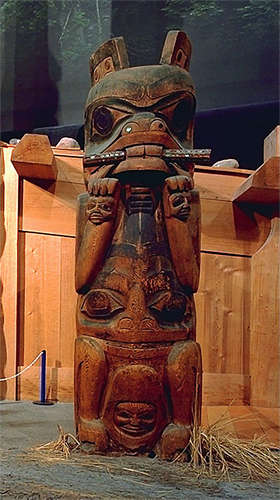
The post as it now stands in the Canadian Museum of Civilization. It no longer has the stack of cylinders on top of the pole.
Interior house pole of Chief Wiah, displaying his crest of a standing Beaver with a Sculpin on its belly. The Beaver is gnawing a stick inlaid with nearly one hundred pieces of abalone shell. This pole was probably carved when the house was constructed circa 1850. It now stands before the Haida house in the Grand Hall of the Canadian Museum of Civilization.
Acquired from Chief Henry Wiah of Masset in 1901 by Charles F. Newcombe.
CMC VII-B-1130 (S92-4407)
Photo and text: http://www.civilization.ca/cmc/exhibitions/aborig/haida/havho05e.shtml
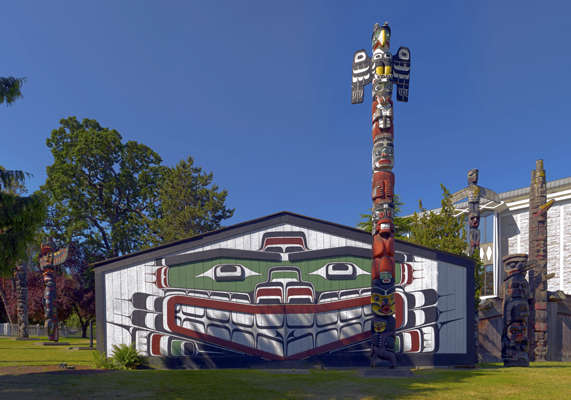
Wawadit'la, also known as Mungo Martin House, a Kwakwaka'wakw 'big house', with heraldic pole. Built by Chief Mungo Martin in 1953. Located at Thunderbird Park in Victoria, British Columbia.
The house was built by Mungo Martin and David Martin with carpenter Robert J. Wallace. Based on Chief Nakap'ankam's house in Tsaxis (Fort Rupert). The house 'bears on its house-posts the hereditary crests of Martin's family.' It continues to be used for ceremonies with the permission of Chief Oast'akalagalis 'Walas 'Namugwis (Peter Knox, Martin's grandson) and Mable Knox.
Pole carved by Mungo Martin, David Martin and Mildred Hunt. 'Rather than display his own crests on the pole, which was customary, Martin chose to include crests representing the A'wa'etlala, Kwagu'l, 'Nak'waxda'xw and 'Namgis Nations. In this way, the pole represents and honours all the Kwakwaka'wakw people.'
Photo: Ryan Bushby, 2007
Permission: licensed under the Creative Commons Attribution-Share Alike 2.5 Generic license

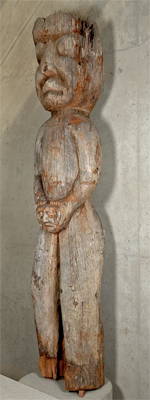
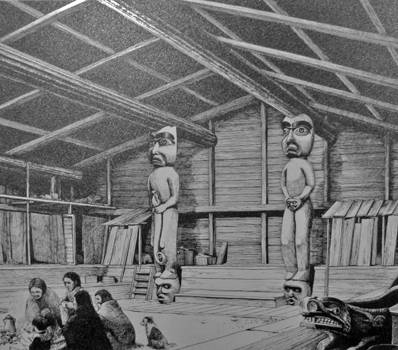
Xwamdasb'e
The Tlatlasikwala village site of Xwamdasb'e, also known as Hope Island, is located near the northern tip of Vancouver island.
The two house posts shown in the illustration were part of an unfinished Bighouse in the village. Their owner, Ha'm'cit, died before the house was finished.
Red cedar, ca 1900
BC Totem Pole Preservation Committee purchase, 1956
A50007a
Large wooden house post carved in high relief. Human figure with large engraved ovoid shaped eyes, protruding nose and slightly triangular mouth; the arms are holding a small face in front of its waist.
This post stood inside a house and supported a main beam. Figures represented on house posts were often supernatural beings which the family living in the house had the right, through their history and origins, to display as a family privilege.
The posts of the unfinished house of Ha'm'cit were carved by a man from Smith Inlet called Si.wit who moved to Xu'mtaspi and married Tom Omhyid's mother. Ha'm'cit died before the house was finished. (Information provided to Prof. Wilson Duff by Mungo Martin). The artist's potlatch name was P'aczsmaxw.
Wayne Suttles places the Xu'mtaspi village as Nahwitti, in historic times, however it was occupied jointly by the Nahwitti, the Yalhinuxw, and the Noqemqilisala (of Hanson Lagoon).
Made in Hope Island, British Columbia, Canada and Xwamdasbe', British Columbia, Canada during 1900
Collected by Michael Kew, Wilson Duff, Helen Codere and Wayne Suttles during 1956
Owned by Ambrose Humchitt
Owned by British Columbia Totem Pole Preservation Committee before 1956
Height 370 cm, width 75 cm, depth 65 cm
Accession number: 2112/2 a
Culture: Kwakwaka'wakw: Tlatlasikwala
Photo (left): Don Hitchcock 2012
Photo (centre): http://www.rrncommunity.org/items/17306
Photo (right): Illustration: Gordon Miller, 1982
Source: Display, Museum of Anthropology, University of British Columbia
Text: http://www.rrncommunity.org/items/17306
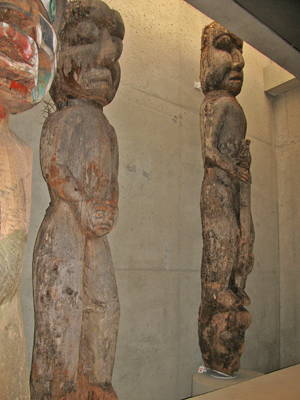
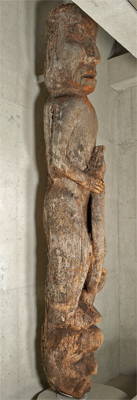

Xwamdasb'e
The Tlatlasikwala village site of Xwamdasb'e, also known as Hope Island, is located near the northern tip of Vancouver island.
The two house posts displayed here were part of an unfinished Big House in the village. Their owner, Ha'm'cit, died before the house was finished.
(Note that the posts are displayed in reverse order in the museum compared with the illustration, which has the man holding a head on the right - Don )
Man with snake: Kwakwaka'wakw Tlatlasikwala
Xwamdasbe' (Hope Island, BC)
Red cedar, ca 1900
BC Totem Pole Preservation Committee purchase, 1956
A50007b
Large wooden house post carved in high relief. Represented is a large human figure with large engraved ovoid shaped eyes, protruding nose and mouth; the arms are holding a serpent in lower front. The snake is long, has a carved nose and a curled tail. The figure is standing upon a human head with sunken eyes, protruding nose and partially pursed lips.
This post stood inside a house and supported a main beam. Figures represented on house posts were often supernatural beings which the family living in the house had the right, through their history and origins, to display as a family privilege.
According to Tom Omhyid, the snake was a Sisiutl, a serpent, often represented with 2 heads and associated with wealth and power. The sisiutl was the belt of qa'niqilakw.
The posts of the unfinished house of Ha'm'cit were carved by a man from Smith Inlet called Si.wit who moved to Xu'mtaspi and married Tom Omhyid's mother. Ha'm'cit died before the house was finished. (Information provided to Prof. W. Duff by Mungo Martin.) The artist's potlatch name was P'aczsmaxw.
Wayne Suttles places the Xu'mtaspi village as Nahwitti, in historic times, however it was occupied jointly by the Nahwitti, the Yalhinuxw, and the Noqemqilisala (of Hanson Lagoon).
Made in Hope Island, British Columbia, Canada and Xwamdasbe', British Columbia, Canada during 1900
Collected by Michael Kew, Wilson Duff, Helen Codere and Wayne Suttles during 1956
Owned by Ambrose Humchitt
Identification Number: A50007 b
Height 430 cm, width 60 cm, depth 70 cm
Hope Island, British Columbia, Canada and Xwamdasbe', British Columbia, Canada
Accession number: 2112/2 b
Photo (left): Don Hitchcock 2012
Photo (centre and right): http://www.rrncommunity.org/items/17307
Source: Display, Museum of Anthropology, University of British Columbia
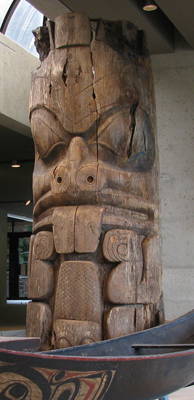
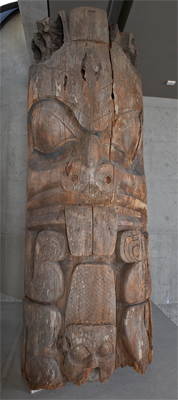 House Frontal Totem Pole
House Frontal Totem Pole
Base section of a wooden totem pole, crescent shaped in cross section and carved in shallow and deep relief. Depicted is a seated beaver with one potlatch ring between erect ears; protruding upper incisors; raised forepaws and hind paws grasping chewing sticks. Below its rectangular shaped crosshatched tail is a human face with large circular eyes. Traces of blue in eye sockets and around nostrils.
Beaver was one of crests owned by the lineage of Chief Ninstints (Tom Price), 'Those Born Up the Inlet', of the Eagle moiety.
Remainder of pole, except top figure, burned when the village was burned in 1892 by the Koskimo and the crew of a sealing schooner. The following people assisted with this expedition: Smyly, John; Atkins, Bernard; Reid, Bill; Duncan, Kelly; Jones, Roy; Jones, Clarence; Jones, Frank.
Made in Ninstints, British Columbia, Canada and Skunggwai, British Columbia, Canada during 1850
Collected by Wilson Duff, Wayne Suttles, Michael Kew and Harry Hawthorn between June 1957 and July 1957
Identification Number: A50013
Cedar wood and paint
Height 330 cm, width 130 cm, depth 60 cm
Accession number: 2113/2
Culture: Haida: Kunghit
Photo (left): Don Hitchcock 2012
Photo (right): http://www.rrnpilot.org/items/10172
Text: http://www.rrnpilot.org/items/10172
Source: Display, Museum of Anthropology, University of British Columbia
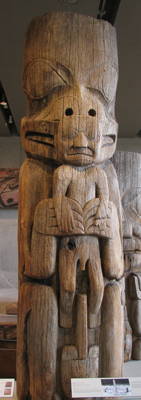
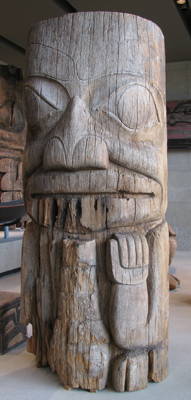
GyaaGang (House Front Pole)
Haida
K'uuna Linagaay (Skedans, Haida Gwaii, BC)
Red cedar ca 1860
BC Totem Pole Preservation Committee purchase, 1954
A50002 a,c
The carvings on house-front poles depict crests and stories belonging to the house owners.
This pole, and the house named 'House Mother' that it fronted, were owned by a brother of the village chief. His wife became wealthy through the salvage of a sailing ship, and so was able to contribute to building this and another lineage house. Perhaps the figure at the pole's base represents this wealthy woman or the ancestor after which the house was named.
Photo: Don Hitchcock 2012
Source: Display, Museum of Anthropology, University of British Columbia
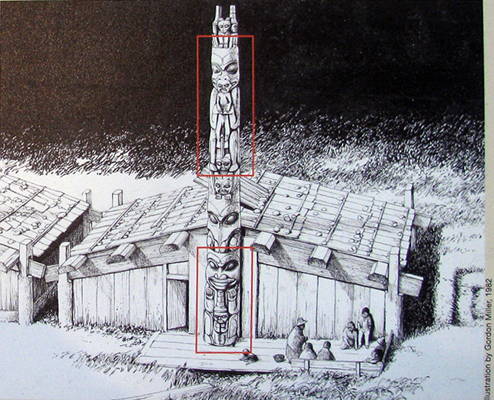
GyaaGang (House Front Pole)
Haida
The two sections in the photos above were once part of the same house-front pole, together with a middle section (A50002b) now displayed on the ramp leading into the Great Hall.
Carved figures, front section (top of pole)
Grizzly bear holding its cub in human form. Finned killer-whale between the bear's legs. The bear was once topped by a figure since rotted away: a small mountain goat perched between two watchmen.
Carved figure, back section (base of pole):
Woman with a labret, or lip plug, indicating her high rank.
Illustration: Gordon Miller, 1982
Source: Display, Museum of Anthropology, University of British Columbia
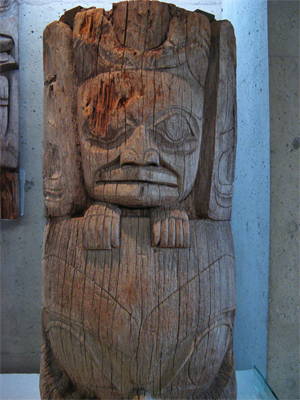
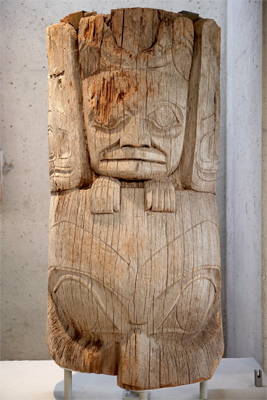
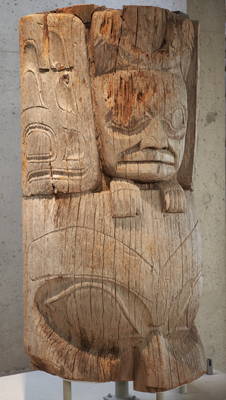
GyaaGang (House Front Pole)
Haida
This is the middle section (A50002b) of the two pieces above, now displayed on the ramp leading into the Great Hall.
Photo (left): Darko, http://my.opera.com/gdare/albums/, Access Publicly available
Photo (centre and right): http://www.rrnpilot.org/items/9636
Source: Display, Museum of Anthropology, University of British Columbia
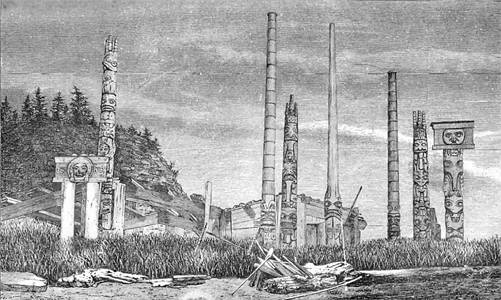
A lithographic reproduction of one of George Dawson’s field photographs of Skedans village, taken July 18, 1878
Source: Martin (2009)

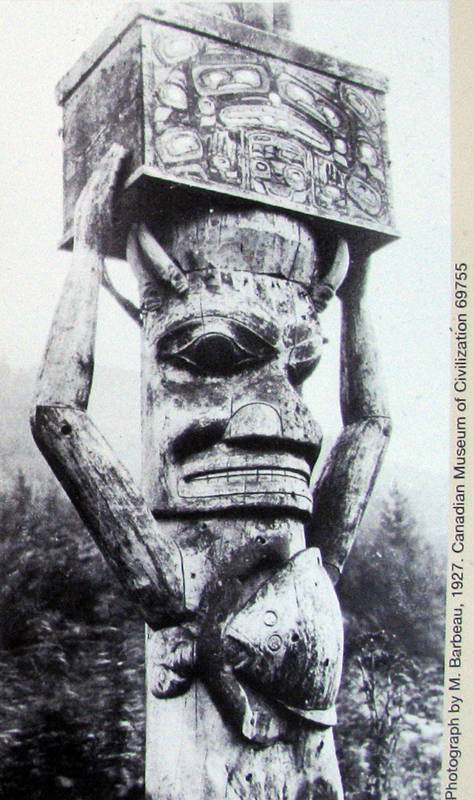
Eagle-Halibut Pole of Laay'
From the House of Sim'oogit Laay, Lax-w'isax clan of Eagle tribe
Carved by Oyee
Nisga'a
Red cedar, paint; ca 1870
Committee on Totem Poles purchase, 1947
A50020
Crest figures from top to bottom:
Xsgaak (Eagle, now missing)
K'aat (Shark), with faces above (7 metre long fin in storage)
Human face surmounted by four cylinders
Ts'imilx (Beaver)
Ansgiy'st (Burial box)
Hagwi'look'am ts'im-aks (Man Underneath)
Naxnogam txux hlok'gwit Gunas (Halibut swallowing Gunas)
(Note that in the old photo we can more clearly see the tiny faces carved in the bases of the 'horns' of the large face. Note also the decorations on the original box, which have not been recreated in the restoration of this pole - Don )
'After the guests of the opposite phratry (a kinship group constituting two or more related clans ) from all over the river had begun to raise the pole, a bad storm broke out and the pole fell. Held responsible for the accident, the guests had to contribute to the cost of the new erection, having 'thrown to the ground the honour of the Eagles after it had been elevated' '
Barbeau (1950)
The Eagle-Halibut pole of Laay' was first raised in the 1870s, as told above, at the Nisga'a village of Gwinwok, on the Nass River. During a severe flood around 1900, the pole was washed downriver. Eventually it was re-erected at Gitiks.
The pole was purchased for the Museum of Anthropology in 1947, and partially restored in 1975 by conservator Roy Waterman, with the assistance of Nisga'a artist Norman Tait. The carved and decorated chest that was originally part of this pole had become separated from it, and is now in the collection of the Canadian Museum of Civilization, in Quebec.
Photo (left, two images stitched together): Don Hitchcock 2012
Photo (right): M. Barbeau, 1927
Source and text: Display, Museum of Anthropology, University of British Columbia

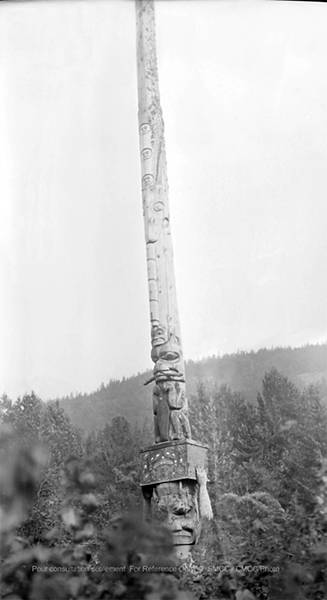
(left) Eagle-Halibut pole of Laay (in situ at Gwinwok ?)
(right) Eagle-Halibut pole of Laay re-erected at Gitiks
(Note that the dates for these photos are difficult to interpret, since both are given as 1927, whereas the photo on the left would have to be before 1900 if it is at Gwinwok. Both photos of apparently different localities for the same pole by the same photographer are given the same date of 1927 - Don )
Photo (left) Display, Museum of Anthropology, University of British Columbia
Photo (right) Control no. IMG2008-0642-0012-N, http://catalogue.civilization.ca/
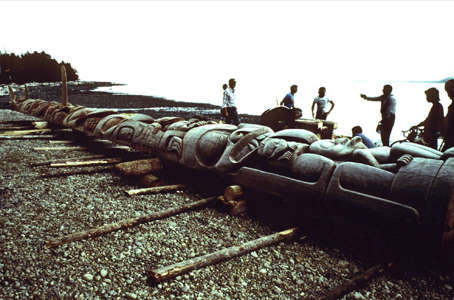
Bill Reid pole lying on the beach waiting to be erected at Skidegate.
Reid spent the two summers and falls of 1976 and 1977 carving a pole for Skidegate, his mother’s village, where only one decaying old pole, erected in 1882, still stood. He invited several artists to participate in the carving.
Joe David carved the Bear cubs, Robert Davidson carved the inner ovoids in the Raven’s wing, and Gary Edenshaw, known as Guujaaw, remained Reid’s assistant for the entire project, carving one side of the pole.
Language group: Haida
Village: Skidegate, Queen Charlotte Islands
Photo: Unknown photographer ca 1978
Permission: Courtesy George MacDonald, Director, Bill Reid Centre for NWC Art Studies at Simon Fraser University, Vancouver, BC.
Text: http://theravenscall.ca/en/who/life_story/middle_years/2
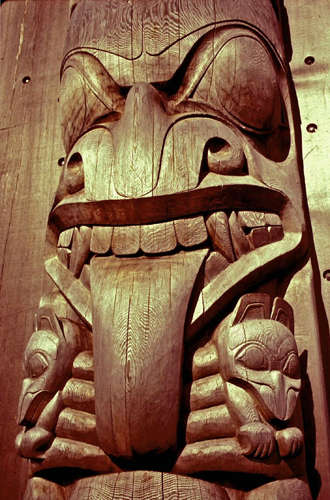
The Bill Reid pole at the Band Council Office in Skidegate was raised in 1978. This pole was the first to be raised in Skidegate in nearly one hundred years.
Following Haida protocol, Reid gifted the pole to Chief Skidegate, who raised it, with the collaboration of the village people, in front of a traditional Haida house (the Band Council office in Skidegate) that had been built to receive it.
Bill Reid’s Haida name, Iihljiwaas ('Princely One'), first given to him in 1954, was publicly confirmed.
Language group: Haida
Village: Skidegate, Queen Charlotte Islands
Photo: © G. MacDonald, ca 1978
Permission: Courtesy George MacDonald, Director, Bill Reid Centre for NWC Art Studies at Simon Fraser University, Vancouver, BC.
Text: http://theravenscall.ca/en/who/life_story/middle_years/2
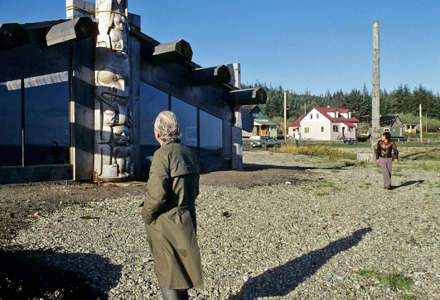
Bill Reid assessing his house reconstruction at Skidegate, ca 1980.
Language group: Haida
Village: Skidegate, Queen Charlotte Islands
Photo: © G. MacDonald, ca 1980
Permission: Courtesy George MacDonald, Director, Bill Reid Centre for NWC Art Studies at Simon Fraser University, Vancouver, BC.
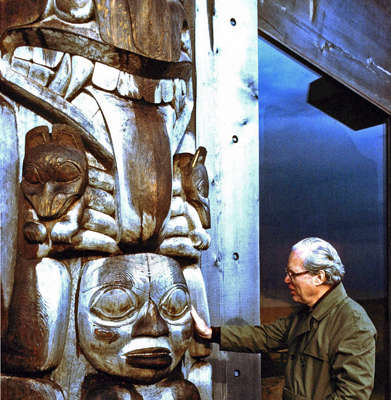
Bill Reid touching the cheek of the Bear Mother figure. The cubs are shown above her head on either side.
Language group: Haida
Village: Skidegate, Queen Charlotte Islands
Photo: © G. MacDonald, ca 1980
Permission: Courtesy George MacDonald, Director, Bill Reid Centre for NWC Art Studies at Simon Fraser University, Vancouver, BC.
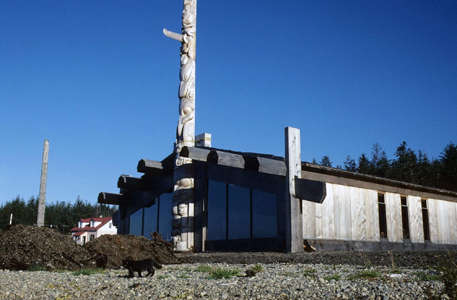
Bill Reid pole in front of the Skidegate Band Council Office.
(note that the Totem Pole is not yet firmly attached, but is held in place by a rope attached to the Council Office - Don )
Language group: Haida
Village: Skidegate, Queen Charlotte Islands
Photo: © G. MacDonald, ca 1980
Permission: Courtesy George MacDonald, Director, Bill Reid Centre for NWC Art Studies at Simon Fraser University, Vancouver, BC.
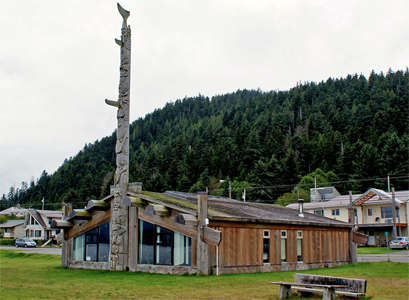
Bill Reid pole in front of the Skidegate Band Council Office.
Language group: Haida
Village: Skidegate, Queen Charlotte Islands
Photo: http://maps.fphlcc.ca/skidegate
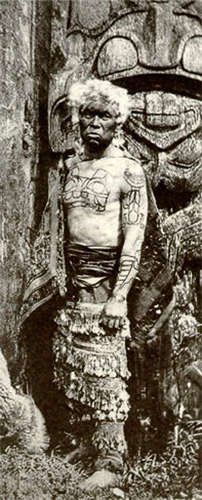
Haida Chief Xa'na of Grizzly Bear House with tattooed hereditary crests, Masset, British Columbia, 1881. Photograph by Edward Dossetter.
Language group: Haida
Village: Masset, Graham Island, Queen Charlotte Islands
Photo: © Edward Dossetter, 1881
Source: http://www.vanishingtattoo.com/tattoo_museum/haida_tattoo_images.html
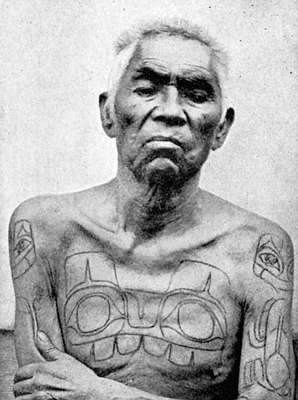
Haida Chief Xa'na of Grizzly Bear House with tattooed hereditary crests
Showing the characteristic figures used in tattooing.
Photo and text: Collison (1915)
Permission: Public Domain
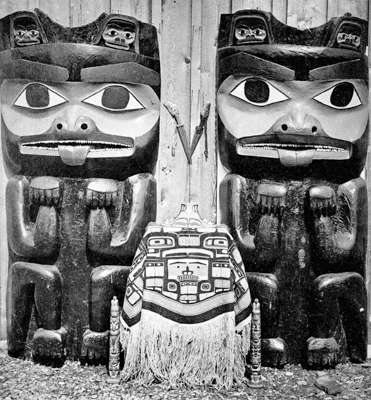
Interior posts of the Grizzly Bear House. Newcombe recorded in 1906 that these were the posts taken by Jacobsen to Berlin. He states that they supported the large round roof beams and faced the door.
Here they are shown just before their removal from Masset, arranged for display with a Chilkat blanket, painted hat, and two daggers that probably belonged to Xa'na. The formal display represented in the photograph is typical of that put on at a chief's funeral. The Chilkat blanket is draped over a box that may be the coffin box of Xa'na.
Language group: Haida
Village: Masset, Graham Island, Queen Charlotte Islands
Photo: © R. Maynard, 1884
Permission: Courtesy George MacDonald, Director, Bill Reid Centre for NWC Art Studies at Simon Fraser University, Vancouver, BC.


Raven-of-the-Sea pole
Carved by Mungo Martin (ca 1881 - 1962)
Kwakwaka'wakw
Red cedar, paint; 1902
Committee on Totem Poles purchase, 1947
A50037
Carved figures from top to bottom:
Gwa'wina (Raven)
T'tix'an (Sea lion), with bird and human in tail flippers
Gala (Crown-of-the-Dog Grizzly Bear), biting a copper Yak'an'takw (Speaking-through Man)
Commissioned by Kwaxalanukwame' (Chief John Drabble) to stand in front of his house in Alert Bay, this pole was the first to be carved by the artist and chief, Mungo Martin.
When Mungo restored this pole at UBC around 1950, he also carved the raven that now sits at the top; it replaced an earlier version of the bird with outspread wings.
From 1949 to 1951, Mungo Martin was in residence at the Museum of Anthropology, restoring his own Raven-of-the-Sea pole from Alert Bay and carving two new poles with his family's crests. IN 1951, the museum erected Martin's poles, the internal frame of an old-style house, and three other poles at a three-acre site on the UBC campus that had been set aside as the location for a totem park. (Jonaitis, 2006)
Photo (left): two images stitched together, Don Hitchcock 2012
Photo (right): http://www.rrnpilot.org/items/17826
Source and most text: Display, Museum of Anthropology, University of British Columbia
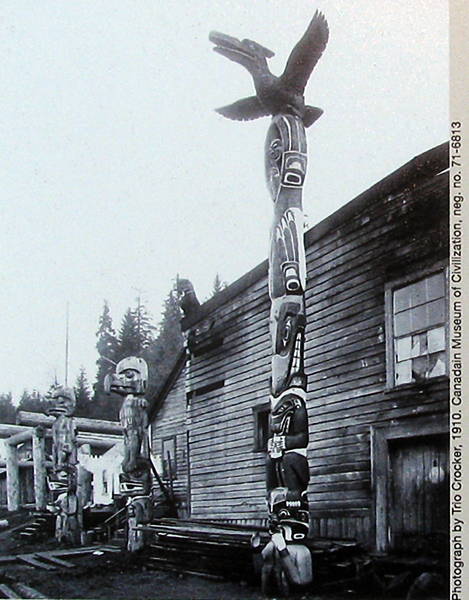
Raven-of-the-Sea pole in situ, the original version with wings extended
Carved by Mungo Martin (ca 1881 - 1962)
Together with his wife, Abayah, Mungo Martin left his home community of Tsaxis (Fort Rupert) in 1949 to work at UBC on a four-year project to restore old totem poles. He also carved two new memorial poles with his family's crest figures.
As a respected carver, ceremonialist, teacher, and composer among his own people, Mungo Martin recorded his knowledge about Kwakwaka'wakw histories and songs while he was here, and encouraged community members to sell their regalia to the Museum. The resulting collection is unique for its direct ties to families who hold ongoing rights to the privileges represented.
The photograph is by Ernest 'Trio' Crocker, who sold distinctive photographs of Victoria city, and when he could get friends to drive him, scenes from further up Vancouver Island. In 1946 Crocker sold some 20 000 glass-plate images to the British Columbia Archives for a mere $250. He died in 1968, and his collection, one of the largest photographic holdings in the archives, languished until they were discovered in 1993 by UVIC art students in search of a fit subject for curating as an exhibition. One of the students, Ellen Peel, wrote her MA thesis on the Crocker collection.
(this paragraph from Grant (2001) )
Photo: Ernest 'Trio' Crocker, 1910, Canadian Museum of Civilization, neg. no. 71-6813
Source: Display, Museum of Anthropology, University of British Columbia
Ridicule Pole or Figure
Another way of declaring superiority of a chief might be for him to erect a ridicule pole or figure that showed a rival chief in some belittling attitude. A shame pole would be displayed to show contempt for a rival's misdeeds or an unfulfilled social obligation. In this sense, the carving would represent some aspect of the event and if it did not shame the person into paying the debt, fulfilling the promise or otherwise making good on the shortcomings, it stood as a reminder of the disgrace for all to see.
Text above: http://www.sfu.ca/brc/art_architecture/totem_poles.html
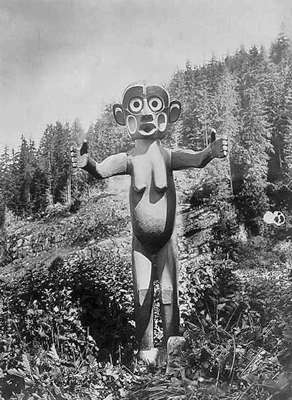
Tsonoqwa figure at Gwayasdums on Gilford Island.
The figure is more than 7 metres tall.
For three years, this original Dzunuk'wa figure faced down the beach toward the owner's in-laws, who had not paid a marriage debt. Such 'ridicule poles' were raised to shame someone who owed a debt to a chief. When the in-laws honoured the debt, the pole was pivoted to face the water. Symbols of wealth, shield-shaped coppers were then added to her head and hands.
Photo: © E. Curtis 1914
Source: http://www.old-picture.com/indians/Tsunukwa-Kwaustums.htm
Text: http://collections.burkemuseum.org/ethnology/display.php?ID=13196
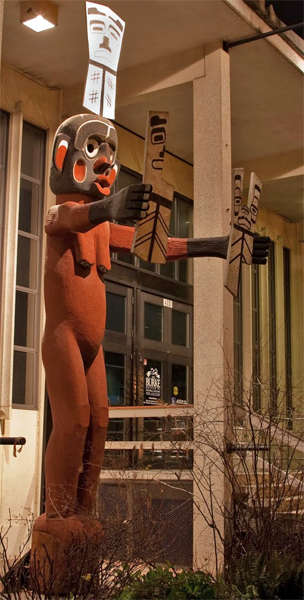
This is a carving of a Dzunuk'wa figure, a supernatural creature with importance to the Kwakwaka'wakw people, standing in front of the Burke Museum. This replica was carved for the Burke Museum in 1970 by Curator Emeritus, Bill Holm.
Some people equate Dzunuk'wa, (pronounced D’ZOO-no-kwa) with Sasquatch, sometimes called Bigfoot, the shy hairy giant of the forest. Others view her as a fearsome creature that can be the source of great wealth. The privilege of representing Dzunuk'wa in carving and performance is a prized heritage of some Kwakwaka'wakw chiefs (the Kwakwaka'wakw people live on northern Vancouver Island and the adjacent mainland of British Columbia).
The pole outside the museum is a replica of the original (pictured above in a 1914 photo by Edward Curtis), which was erected in Gwa'yasdam's village on Gilford Island, B.C in the early 19th century. This kind of pole is sometimes called a "ridicule pole" and these poles were raised to shame someone who owed a debt to a chief. For three years, this original Dzunuk'wa figure faced down the beach toward the owner's in-laws, who had not paid a marriage debt. When the in-laws honoured the debt, the pole was pivoted to face the water. To acknowledge the payment of the debt, the owner had carvings of shield-shaped coppers added to her head and hands, to represent wealth.
Bill Holm initially painted the Dzunuk'wa figure’s entire body black, based on the black and white historical photos that he was using for reference. But based on later analysis of Emily Carr's colored image, Holm has come to believe the body of the original sculpture was painted red. The replica was changed from black to red in 2002, when it was placed outside the Burke. The head of the original sculpture is also in the Burke Museum's ethnology collections.
Posted by: MaryAnn Barron Wagner, Communications
Source and text: http://burkemuseum.blogspot.com.au/2010/03/what-is-that-series-on-outdoor-artwork_30.html
Photo: Steve Whiston
Commemorative Figure
On a very important occasion or potlatch a commemorative figure of the host chief may be carved. These sculptures are raised for the special occasion on a pole in front of the house or high on the gable of the house as a statement of self worth.
Text above: http://www.sfu.ca/brc/art_architecture/totem_poles.html
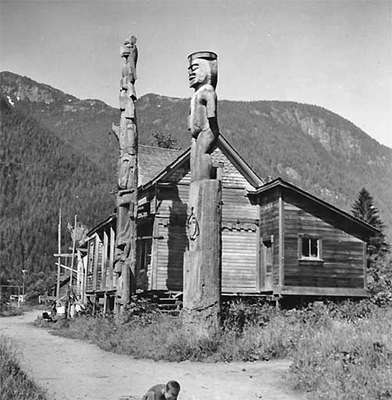
The closest pole to the camera is the George Scow pole erected to commemorate a potlatch he held.
Photo: © Adelaide de Menil, ca. 1966
Source: http://www.sfu.ca/brc/art_architecture/totem_poles.html

Memorial pole
Carved by Mungo Martin (ca 1881 - 1962)
Kwakwaka'wakw
Red cedar, paint; 1951
Commissioned from the artist
A50035
Carved figures from top to bottom:
Huxwhukw (Man-eating, supernatural bird)
Gigame' (Chief) holding wak'es (frog)
Nan (Bear) hoding kutala (salmon)
Ma'x'inux (killer whale)
T'sawi (Beaver)
Mungo Martin carved two new totem poles while he was at UBC: this one, and the other located on the hill directly outside MOA's Great Hall. The figures he chose represent crests to which Mungo had ancestral rights, with the pole outside commemorating Chief Kalilix, the head of his family line.
This pole was deinstalled from the MOA grounds and placed in storage due to condition problems in Sept. 2005. The beak had previously been removed from the pole in 1998 and placed in storage due to instability from inner rot in the top of the pole. In 2012 the pole was installed in the MOA Great Hall, with the beak re-attached using an internal steel mount.
Made by Mungo Martin (Maker) in Vancouver, British Columbia, Canada during 1951
Height 11.4 m, diameter 0.7 m
Condition: fair
Accession number: 2109/1
Photo (left): two images stitched together, Don Hitchcock 2012
( At the time of writing, October 2012, this is the only photo of this pole available on the net.
If any reader has large format photos of this or any other pole, I would be glad to have them for this site - Don )
Source: Display, Museum of Anthropology, University of British Columbia
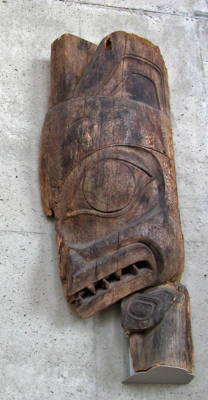
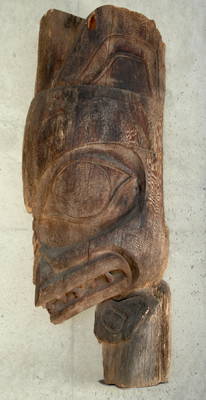
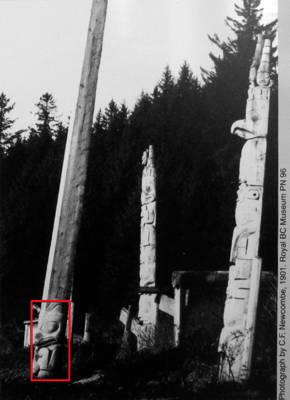
Pole fragment
Haida
K'uuna Llnagaay (Skedans, Haida Gwaii, BC)
Red cedar; ca 1870
Gift of Walter C. Koerner, 1976
A2544
The Sea-Grizzly Bear or Snag crest is represented on this fragment of a Haida totem pole. The figure originally formed the base of a memorial pole, and was topped by a long, projecting fin (see old photo at right).
According to the ethnographer Charles Newcombe, the pole was raised by one of the chiefs from the mainland village of Kitkatla, who had given away a great deal of property at Skedans.
Alternative description from http://www.rrnpilot.org/items/12591 :
Carved wood Memorial pole fragment with a slight crescent shape in cross section. Depicted is a figure with bear-like characteristics with a large ear, eye and a slightly protruding mouth with bared, pointy teeth. In between its teeth is a carved section that runs through to the front of the mouth, possibly a tongue that would have stuck out the front.
Height 210 cm, width 113 cm, depth 35 cm
Condition: fair
Accession number: 336/34
Photo (left): Don Hitchcock 2012
Photo (centre): http://www.rrnpilot.org/items/12591
Photo (right): C.F. Newcombe, 1901. Royal BC Museum PN 96
Source: Display, Museum of Anthropology, University of British Columbia
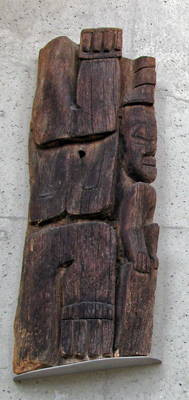
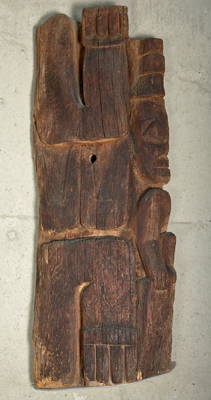
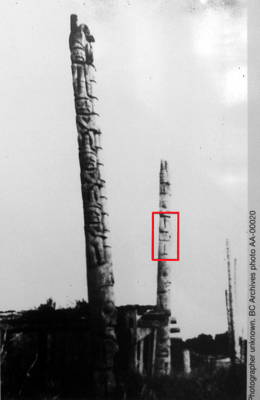
Pole fragment
Haida
K'uuna Llnagaay (Skedans, Haida Gwaii, BC)
Red cedar; ca 1870
Gift of Waiter C. Koerner, 1976
A2542
Elements of two crest figures are visible on this fragment of a Haida house-front totem pole. On the left are the limbs of what may be a transforming bird/human, with two feathers emerging beneath the arm. This being's head appears human rather than bird-like in the photograph, Depicted on the right side of the fragment is a standing human figure wearing a three-ringed nobility hat - a symbol of the person's chiefly status.
Alternative description, http://www.rrnpilot.org/items/11411 :
Carved wooden pole fragment with a slight crescent shape in cross section. On the left side is a crouching figure with wing-like forms in between a human hand and foot. On the right is a standing human wearing a hat with two potlatch rings.
Height 185 cm, width 75 cm, depth 35 cm
Condition: fair
Accession number: 336/32
Photo (left): Don Hitchcock 2012
Photo (centre): http://www.rrnpilot.org/items/11411
Photo (right): Unknown, BC Archives photo AA-00020
Source: Display, Museum of Anthropology, University of British Columbia
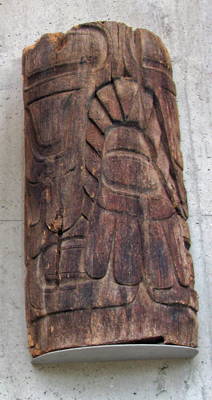
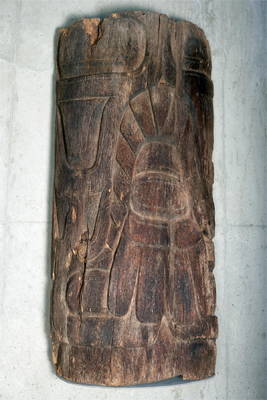
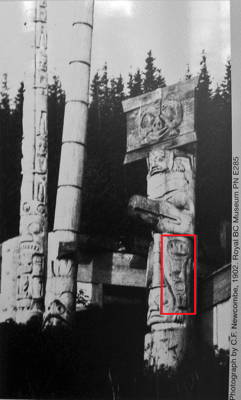
Pole fragment
Haida
T'anuu Llnagaay (Tanu, Haida Gwaii, BC)
Red cedar; ca 1870
Gift of Waiter C. Koerner, 1976
A2541
This totem-pole fragment is carved to represent fanned-out feathers, and so may have been the back of a bird crest figure, similar to the eagle carved on another pole, shown right. It was probably part of a free-standing pole, like the mortuary and memorial poles also shown in the photograph. These are carved all around, while house-frontal poles are hollowed out at the back.
Alternative description from http://www.rrnpilot.org/items/11410 :
Carved wooden pole fragment; crescent shaped in cross section. Depicted are large feathered wing on either side with tail feathers in between.
Made in Tanoo, British Columbia, Canada
Height 186 cm, width 107 cm
Condition: fair
Accession number: 336/31
Photo (left): Don Hitchcock 2012
Photo (centre): http://www.rrnpilot.org/items/11410
Photo (right): C.F. Newcombe, 1902. Royal BC Museum PN E285
Source: Display, Museum of Anthropology, University of British Columbia
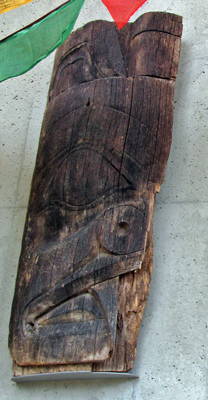
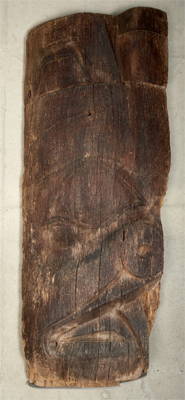
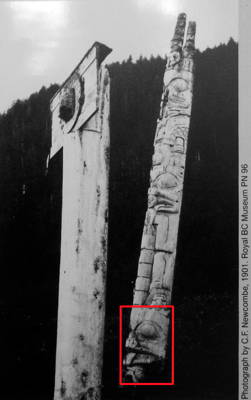
Pole Fragment
Haida
Hlkinul Llagaay (Cumshewa, Haida Gwaii, BC)
Red cedar; ca 1870
Gift of Walter C. Koerner, 1976
A2543
This fragment of a Haida totem pole shows the side view of an animal's head. We can see an ear, eye, nose, and mouth, with part of one long front tooth, suggesting that a beaver crest is depicted.
Pictured and isolated with a red rectangle in the old photograph shown here is a different pole but which has a similar figure at its base. Rising from the centre of the forehead is a tall stack of hat rings (sgil, meaning 'wealth spirit'), indicating the great status of the family whose history the pole represents.
Description from http://www.rrnpilot.org/items/12590 :
Carved wooden pole fragment with a beaver motif. Large ear, ovoid eye, snout and downturned mouth with a large tooth. In the middle of its head is a cylindrical shaped piece of wood with two horizontal incised lines possibly representing potlatch rings.
Made in Cumshewa, British Columbia, Canada
Height 210 cm, width 100 cm, depth 33 cm
Condition: fair
Accession number: 336/33
Photo (left): Don Hitchcock 2012
Photo (centre): http://www.rrnpilot.org/items/12590
Photo (right): C.F. Newcombe, 1901. Royal BC Museum PN 96
Source: Display, Museum of Anthropology, University of British Columbia


The Pole of Tatentsit
Pole carved in high relief out of cedar wood, and painted.
Depicts from bottom to top: a raven, human holding a white and black copper, Sisiutl with a supernatural creature in its tail and a frog(?) in its mouth, an eagle and human. The large protruding beak of the raven has been attached. The entire surface is painted in black, white, green and red with Northwest Coast stylised forms.
(Sisiutl is the god of warrior invincibility, a magic war-canoe that can go underground (Winalagalis), and guardian of the house of the sky people - Wikipedia )
Free standing totem poles such as this were usually memorial or commemorative poles erected in honour of a person who had died, usually by the successor to his name. The beings represented on Kwakwaka'wakw poles are those beings from mythical times who became, or were encountered by, the ancestors of those who are being commemorated, whose family claimed the figures as crests. Crests could also be claimed as marriage gifts.
Barbeau called it The Pole of Tatentsit. According to Barbeau, the pole was erected for, or by, T'at'entsit on the occasion of a large potlatch. The pole was re-adzed and re-painted by Kwakwaka'wakw carver Mungo Martin before shipping in 1947. Repainted and repaired by Ellen Neel (1949) and by Mungo Martin (1950-51). It stood at Totem Pole Park, UBC Campus until it was re-located to the Museum's Great Hall c. 1976.
Thunderbird is a supernatural bird identifiable by the presence of ear-like projections or horns on the head, and a re-curved beak. Sisiutl is a serpent often represented with two heads, and associated with wealth and power. Raven is represented with a long, straight beak, sometimes slightly squared or rounded at the tip.
Raven Chief is holding a copper, a symbol of wealth.
Made by Charlie James (Maker) in Fort Rupert, British Columbia, Canada and Tsaxis, British Columbia, Canada during 1900
Collected by Marius Barbeau and Arthur Price during 1947
Owned by Committee on Totem Poles before 1947
Identification Number: A50038
Height 12.2 m, width 2.11 m, depth 0.83 m
Made in: Fort Rupert, British Columbia, Canada and Tsaxis, British Columbia, Canada
Condition: fair
Accession number: 2106/5
Culture: Kwakwaka'wakw: Kwagu'l
Photo: two images stitched together, Don Hitchcock 2012
Text: http://www.rrnpilot.org/items/17827
Source: Display, Museum of Anthropology, University of British Columbia
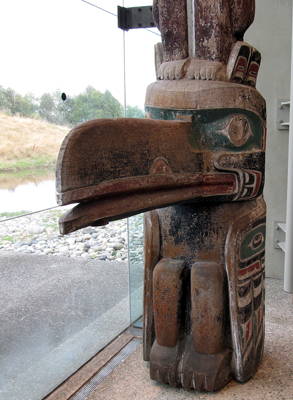
Raven from the Pole of Tatentsit shown above.
Identification Number: A50038
Photo: Maria Hitchcock 2012
Source: Display, Museum of Anthropology, University of British Columbia

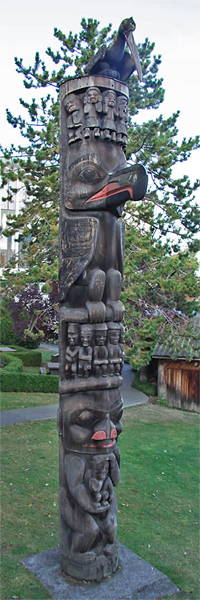

Memorial Totem Pole of Skim-sim and Will-a-daugh.
Carved by Haesemhliyawn
Original on left, replica centre and right
Replica is named the Gitxsan Pole, 1960
Carvers: Mungo Martin, Henry Hunt and Tony Hunt
Wooden memorial pole carved in shallow and deep relief; crescent shaped in cross section. Motifs from the bottom to top: Wild Woman of the woods holding a child, row of children playing the gambling game lahal, a thunderbird, row of children playing lahal, a woodpecker. The woman is missing her long beak-like nose. Pole is unpainted.
Another version of a description of the carvings, from a display at the museum:
Carved figures top to bottom:
Wee-get-weltku (giant woodpecker)
Human figures ('House carvings')
Skim-sim (Mountain Eagle)
Row of children or small people: the ones who fish through holes in the ice
Will-a-daugh holding a child (projecting nose missing from main figure)
Yet another version of a description of the carvings, from http://www.royalbcmuseum.bc.ca/exhibits/tbird-park/html/present/ex11/ex11.htm
Giant Woodpecker, (Wee-get-welku) a crest that originated with the story of an ancestress who kept a woodpecker as a pet, feeding it constantly. It turned into a huge monster and ate everything made of wood before it was finally killed.
Five small human figures, the house carvings.
Mountain Eagle, (Skim-sim) who kidnapped and mated with a young woman and devoured their offspring. (According to Wilson Duff , the large bird figure is the mother of the Prince of the Wolves.)
Eleven small human figures, who fish through holes in the ice.
Will-a-daugh holding her child. Will-a-daugh was a chief’s niece at Ke-an (Prince Rupert) who conceived a child from a wood grub. The nose of the ancestress on the original pole was probably long and sharp edged. Marius Barbeau described the figure as 'Person with a large nose . . . holding a child or human being in its hands.'
This pole stood outside the house of Weerhae, a chief of the Laxsel Clan of the Gitanyow. Known as the pole of Skim-sim and Will-a-daugh.
In 1958, an agreement was signed by the People of Kitwancool (as Gitanyow was then known), permitting anthropologists to collect and preserve this and several other poles in museums. In return, the anthropologists agreed to publish the histories, stories, and traditions of Kitwancool so future generations of both Native and non-Native students could learn about them. The booklet, 'Histories, Territories and Laws of the Kitwancool' (edited by Wilson Duff, Anthropology in British Columbia Memoir No. 4) was published by the British Colombia Provincial Museum, and is still in print.
Crests belong to the family of the person in whose honour the pole was raised.
Made by Haesemhliyawn (Maker) in Kitwancool, British Columbia, Canada between 1800 and 1899
Collected by Wilson Duff and Michael Kew during 1958
Owned by British Columbia Totem Pole Preservation Committee before 1958
Received from British Columbia Totem Pole Preservation Committee (Transferring institution) during 1958
Identification Number: A50019
Height 11.5 m, width 1.2 m, depth 0.7 m
Made in: Kitwancool, British Columbia, Canada
Condition: fair
Accession number: 2114/1
Culture: Gitanyow
Creator: Haesemhliyawn (Maker)
Field Collector: Wilson Duff and Michael Kew
Creation Date: ca 1890
Collection Date: during 1958
Photo (left, original): two images stitched together, Don Hitchcock 2012
Photo (centre, replica): © RBCM, 2006, http://www.royalbcmuseum.bc.ca/exhibits/tbird-park/html/present/ex11/
Photo (right, replica): Thunderbird Park, 1975. BC Government photograph. BC Archives I-20999, http://www.royalbcmuseum.bc.ca/exhibits/tbird-park/html/late/ex13/ex13.htm
Text: http://www.rrnpilot.org/items/17785
Source: Display, Museum of Anthropology, University of British Columbia
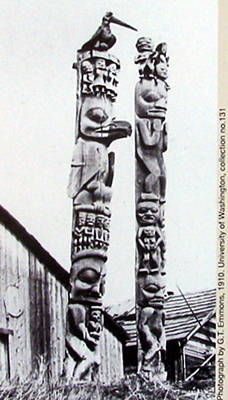
Memorial Totem Pole of Skim-sim and Will-a-daugh.
Carved by Haesemhliyawn
The History of the House of Skim-sim, the Mountain Eagle
This pole was the first pole erected in Kitwancool by the clan of the Wolves. lt had been erected about a thousand years ago near Ke-an (Prince Rupert Harbour). When a pole decays, or at the death of a chief, a new pole is always erected in the same place. When these people migrated, they took along duplicates of their totem poles and erected them in their new permanent villages.
When a pole is erected or changed, it is erected at the same place. A feast is always given and the territories are discussed. They tell the people the size of their village, the mountains they own, their hunting and fishing grounds. They tell this so that each new generation will know what they own. The new chief and his council divide the land. They tell each clan which mountains they can have, and what areas they can hunt and fish in.
Wolf Clan Chief, Wee-kha (Ernest Smith), 1958
Text: Duff (1959)
Photo: G.T. Emmons, 1910. University of Washington, collection 131.
Source: Display, Museum of Anthropology, University of British Columbia
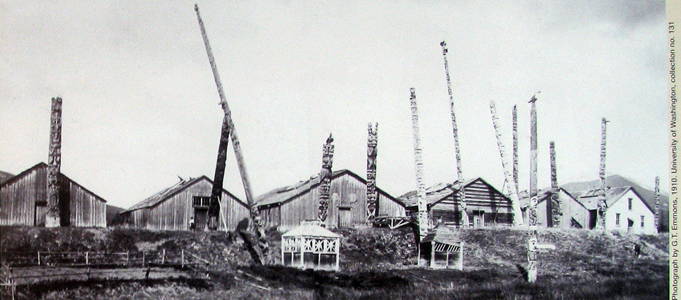
Gitanyow (Kitwancool) village, north of the Skeena River, 1910.
The two poles shown above, including the Skim-sim pole, may be seen in front of the third house from the left.
Like many Northwest Coast villages, Gitanyow represents an amalgamation of groups of people who trace their origins to different places. The totem poles carved in the 1800s and 1900s stood as documents of these histories and migrations, which occurred over thousands of years.
Photo: G.T. Emmons, 1910. University of Washington, collection 131.
Source: Display, Museum of Anthropology, University of British Columbia

Map of the locations of Skeena River Totem Poles, including the location of Gitanyow (Kitwancool) village.
Photo: http://www.cathedralgrove.eu/text/06-Totem-Poles-2.htm
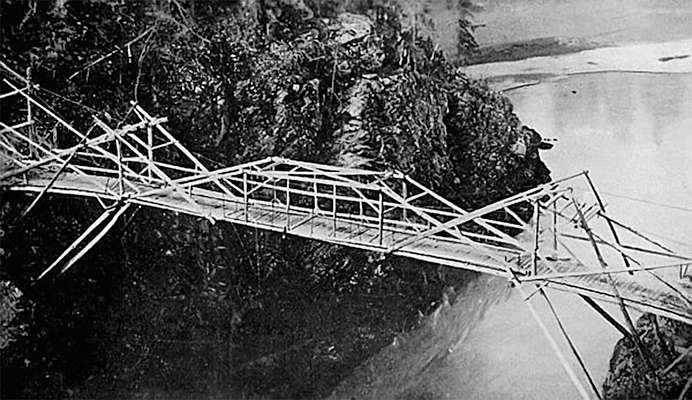
An old First Nations bridge spanning the Bulkley River (a tributary of the River Skeena) near Hazelton, B.C.
Photo and text adapted from: Collison (1915)
Permission: Public Domain
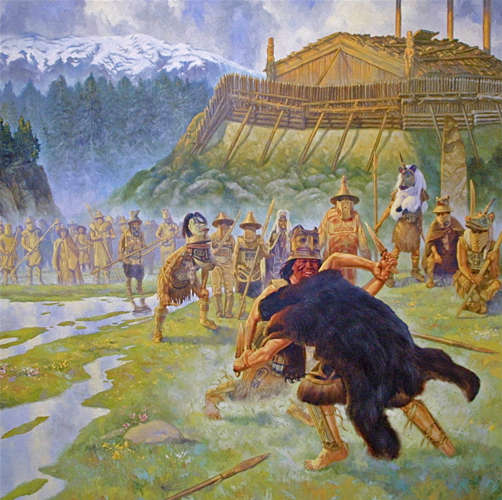
C. Hopkins, Painting of Warriors Doing Battle
The Battle of Champions at the Kitselas Fortress shows how two designated warriors settled a dispute about access to trade routes on the Skeena River.
The Tsimshian and Athabaskan communities each fronted one of their best fighters, armed with personal totems, wooden shin guards and copper daggers (weapons, apparently, worth a slave), and the resulting battle was enough to settle the issue permanently, with no further loss of life.
Photo: © Chris Hopkins
Permission: Courtesy George MacDonald, Director, Bill Reid Centre for NWC Art Studies at Simon Fraser University, Vancouver, BC.
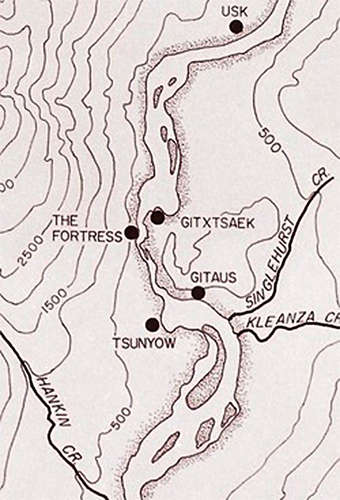
Kitselas Canyon topographic map.
Gitselasu or Kitselas, which means 'People of the Canyon', are part of the Tsimshian language family and their territory borders on that of the Gitxsan in Northwestern British Columbia. The Kitselas Canyon is about 1.7 kilometers long, and the area had five known traditional villages. On the Eastern side of the Skeena River were Gitsaex and Gitaus villages. Located on a small island was the fortified village of Gitlaxdzawk (The Fortress). Near the mouth of the bay was the village of Tsunyow. The fifth village (not shown), known today as the archaeological site of Paul Mason, was named for an elder who was one of the people who discovered the site.
The traditional territory of the Gitselasu includes the area along the Skeena River between Terrace to the West and Lorne Creek to the East. The Gitselasu were known to be wealthy and powerful people. Due to their strategic position at the Kitselas Canyon, they were able to control the lucrative trade route along the Skeena river. In order to travel through Gitselasu territory, a toll would have to be paid to the Gitselasu chiefs contributing to the overall wealth of the area.
Many of the former villages in the Kitselas Canyon were abandoned due to the small pox epidemics of the late 19th century. During this time, the remnant populations came together in what are today the two core villages of the area, Gitaus and Kulspai.
Photo: © G.F. MacDonald, 1979
Text: Berthiaum R. 1999. The Gitselasu: The People of Kitselas Canyon, Indian and Northern Affairs Canada: www.ainc-inac.gc.ca
Kitselas First Nations Website: www.kitselas.bc.ca.
Source: http://www.sfu.ca/brc/virtual_village/tsimshian/gitselasu.html
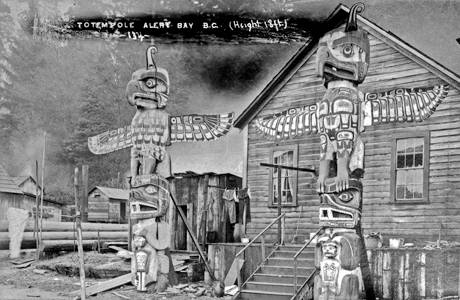
Totem pole. Alert Bay, BC, Height 18 ft, 190?.
Photo: Charles H. Smith
Source: http://searcharchives.vancouver.ca/totem-pole-alert-bay-b-c-height-18ft;rad
Permission: Public Domain
(left) Raven stealing the sun totem pole was carved by Dempsy Bob, A Tahitan Tlingit from Prince Rupert, BC.
It was raised on May 21, 1983 beside the Tongass Historical Museum in Ketchikan, Alaska, to honour the Tongass Tlingit and tells the story of Raven bringing daylight to the people.
Photo: Wm. Lattin, 1987
Printed by Mike Roberts
Color Productions, Oakland 94623
(right) Haida Totem Pole. A carved wooden totem pole, 41 feet high, placed in front of the Milwaukee Public Museum in 1921.
This pole, bearing the hereditary crests and totemic symbols of an important Haida family stood, until 1913, at the town of Ian, Masset Inlet, Queen Charlotte Islands, BC.
It is one of the finest examples of the Northwest Coast Indian wood carving tradition.
Photo: 'Phostint', made only by Detroit Publishing Co. © Milwaukee Public Museum, Wis.
Source for both postcards: Courtesy of Norbert Hobrath.
(left) Alert Bay, BC. The most famous of all the totems in Sitka is the Memorial Totem, which is the largest totem in Alaska, located in Indian River Park in Sitka.
The four smaller totems are corner posts for an Indian Ceremonial House.
Photo: No information given
(right) Totem poles are the unique hallmark of the Maritime Indians of British Columbia and the neighbouring coast and islands. Seven principal tribal divisions, each with its language, art and form of nationhood make up the totem pole carving people.
The golden age of totem poles was between 1850 and 1900. Major poles and great carvers have come since then, but not since 1910 has the art been exercised on a tribal basis. The Kwakiutl Tribe were spread over the upper part of Vancouver Island and the adjoining mainland. On the memorial poles shown the bird represents the eagle - symbol of nobility, helpful to man. The grizzly bear below stands for strength and ferocity. The small pole represents a human holding a 'copper' - a symbol of power and authority,
Photo: Eric J. Cooke Photo productions, Sidney BC
Source for both postcards: Courtesy of Norbert Hobrath.
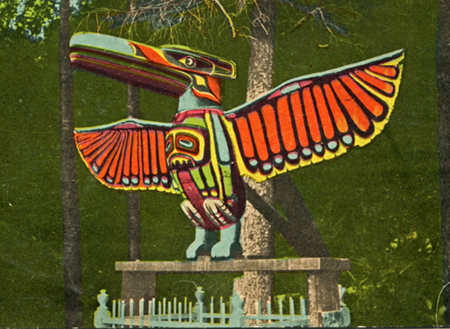
Totem pole from Alaska.
Photo: La Voy
Published: Lowman and Hanford co. Pub. Seattle
Source for the postcard: Courtesy of Norbert Hobrath.
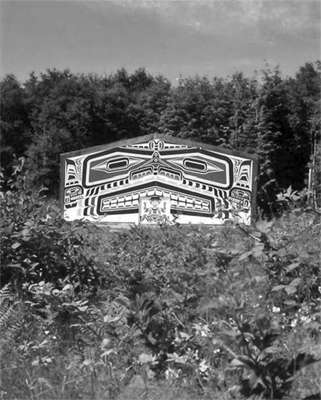
Big House, Cormorant Island.
Alert Bay or 'Yalis, meaning 'Spreading Leg Beach' was an ancient resource site and has been a traditional home of the 'Namgis people for several thousand years. It is located on Cormorant Island in the Queen Charlotte Strait. In 1860 the site was renamed 'Alert Bay' after a British naval gunship. Colonial entrepreneurs set up a fish saltery at 'Yalis in 1870 and persuaded the 'Namgis people to relocate there from Xwalkw to provide labour for the new factory.
Language Group: Kwakwaka'wakw
Photo: © Adelaide de Menil, 1967
Permission: Courtesy George MacDonald, Director, Bill Reid Centre for NWC Art Studies at Simon Fraser University, Vancouver, BC.
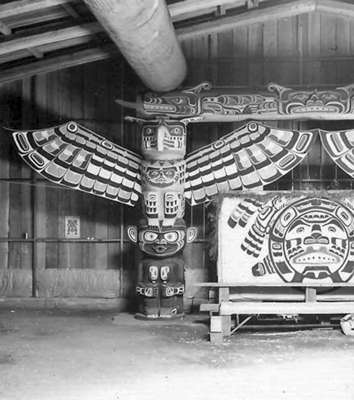
The interior of the big house in the image above, showing a Thunderbird, the eagle figure at the top of the pole, supported by Dzunuk'wa with her characteristic lips, and with a Sisiutl, the double headed sea serpent as the strong crosspiece of the house, shown with a human head at its centre, as is usual.
One of the myths surrounding the Thunderbird:
Whale was a monster, killing other whales and depriving the quileute tribe of meat and oil. Thunderbird, a benevolent supernatural being, saw from its home high in the mountains that the people were starving. It soared out over the coastal waters, then plunged into the ocean and seized Whale. A struggle ensued; the ocean receded and rose again. Many canoes were flung into trees and many people were killed. Thunderbird eventually succeeded in lifting Whale out of the ocean, carrying it high into the air and then dropping it. Then another great battle occurred on land.
In one of many variant versions of the myth, the sound of the whale dropping into the sea is the source of thunder. A young boy of a Vancouver Island people, the Comox, was fascinated by the sound of thunder, and heard it from behind a point of land. He crossed that point, following the sound of thunder, and discovered the spectacle of the Thunderbird seizing and dropping the whale. The Thunderbird saw the boy, and told him that the story was now his, and he had the right to wear the Thunderbird mask and wings at the potlatch.
In another variant, the flapping of the Thunderbird's wings is the source of the thunder.
Dzunuk'wa is a female cannibal spirit, the wild woman of the forest, whose specialty is roasted babies, but is also associated with wealth and nourishment.
Sisiutl is a dramatic supernatural creature. The double headed Sea Serpent is one of the most high ranking crests in Kwagiulth culture. Its power possesses it to shift shape and transform from animal to man at anytime. As well, a Sisiutl can change itself into a self-propelled canoe which the owner must feed with Seals.
Touching the serpent or even looking at it, or a glance from it, can cause death. Legends say Shamans tried to kill the Sisiutl for its healing power and magic. It’s closely assocated with war and strength, death and revival, so warriors try to kill it to rub its blood on themselves to attain its skillful strength and become invulnerable. A warrior would often wear a head band or belt in the image of a Sisiutl to provide protection from harm.
Flakes of shiny mica found on beaches were thought to be the discarded scales from the serpent’s body. Whether carved or painted, the Sisiutl is depicted with a profile head, teeth and a large curled tongue at each end of its serpetine form and in the centre is a human head. Fins run along its back and curled appendages or horns rise from all three heads. The painted body represents scales and it may be carved horizontally, formed into a U-shape or coiled into a circle.
Sisiutl guarded the entrance to the homes of the supernatural. It was painted on the sides of canoes and hung over doorways to protect the inhabitants from evil spirits.
Language Group: Kwakwaka'wakw
Photo: © Adelaide de Menil, 1967
Permission: Courtesy George MacDonald, Director, Bill Reid Centre for NWC Art Studies at Simon Fraser University, Vancouver, BC.
Text: adapted from Wikipedia, http://quizlet.com/1581163/new, http://www.nativeonline.com/legends.html
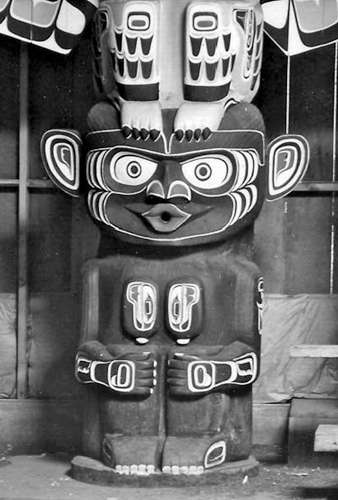

Close up (left) of the Dzunuk'wa figure, the wild woman of the woods, at the base of the Totem Pole above, and the central body (right) of the Thunderbird.
Language Group: Kwakwaka'wakw
Photo: © Adelaide de Menil, 1967
Permission: Courtesy George MacDonald, Director, Bill Reid Centre for NWC Art Studies at Simon Fraser University, Vancouver, BC.
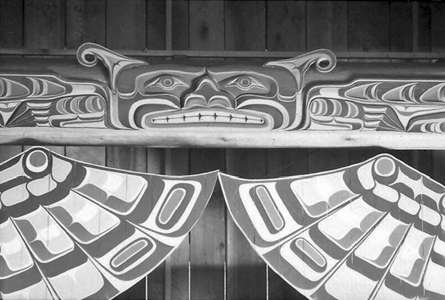
Human face in the middle of the Sisiutl, the double headed sea serpent in the Big House, Cormorant Island.
Language Group: Kwakwaka'wakw
Photo: © Adelaide de Menil, 1967
Permission: Courtesy George MacDonald, Director, Bill Reid Centre for NWC Art Studies at Simon Fraser University, Vancouver, BC.

Northern Style Haida Totem pole.
A50024
The carving and painting of this pole seems to combine elements of different First Nations art styles. The fine surface adzing and balanced composition shows the expertise of a knowledgeable carver. If other works by this artist are eventually identified, a cultural provenance could be developed.
The top figure is possibly a crane or heron with a human face between its wings. Below are a hawk or thunderbird, whale, and an unidentified figure at the base.
Carved wooden totem pole, slightly triangular in shape, depicting figures from top to bottom: heron (?) with a small face between its wings, hawk, whale, and human figure. Hawk’s beak is protruding. The pole is painted blue, black, green and red with Northwest Coast stylised designs. Underside is concave.
Made in Haida Gwaii, British Columbia, Canada during 1900
Owned by George Henry Raley before November 1948
Received from H. R. MacMillan (Funding source) and George Henry Raley (Seller) during November 1948
Height 2570 mm, width 430 mm, depth 324 mm
Condition: good
Case 016
Accession number: 1960/748
Photo: Don Hitchcock 2012
Source: Display, Museum of Anthropology, University of British Columbia
Additional text: http://www.rrnpilot.org/items/28137


Nisga'a Nass River Totem pole.
A8212
This pole has a collecting provenance of Nisga'a and fits with the style of larger Nisga'a poles. The weathered condition of the surface indicates that it was in the outside environment for some time.
The figure on the top is a human falling from the sky, a bird-like creature with a recurved beak, possibly a Giibilk, and a human with a child at the base.
Totem pole carved from cedar wood. The bottom of the pole has a human holding a smaller human, followed by a bird figure, and topped with a human in an upside down position. All of the figures have black circle in tapering oval eyes with either red or black brows above and a red mouth. The bird figure has three-feathered wings with circles, ovoids, and split u's. The ears of the human at the bottom holding the smaller human have a frontal face each. The feet of the upside down human at the top bend forward.
Collected between 1950 and 1962
Received from Edith Bevan Cross (Seller) and H. R. MacMillan (Funding source) on July 30, 1962
Height 220 cm, width 40 cm, depth 50 cm
Condition: fair
Case: 016
Accession number: 81/133
Photo (left): Don Hitchcock 2012
Photo (right): http://www.rrnpilot.org/items/8388
Source: Display, Museum of Anthropology, University of British Columbia
Additional text: http://www.rrnpilot.org/items/8388

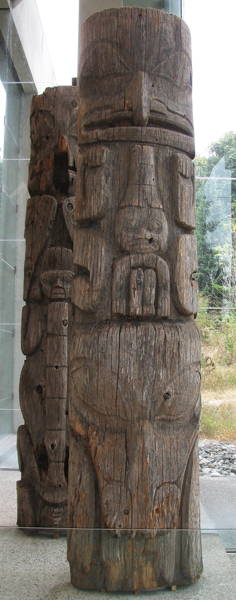
House Frontal Totem Pole
These two poles were once part of a larger pole.
The pole stood outside, against the centre of the front wall of an unnamed house.
A50014 a on left, A50014 b on right.
Top portion of pole A50014 a (top of original pole) crescent shaped in cross section and carved in shallow and deep relief. At the top is an eagle with round eyes intersecting mouth; in-folded wings and claws flank a human face with feathers, representing the tail of eagle turned under, on head. The eagle is missing its beak that attached at the mouth.
Below is a frog facing downwards, with a wide body, legs at sides of pole and five ringed column in middle of back. There is a small upside down human face between squared erect ears of the top figure from part. The pole is unpainted.
Bottom portion of pole A50014 b (bottom of original pole) crescent shaped in cross section and carved in shallow and deep relief. At the top is a kneeling human/hawk transformation figure with beaked nose re-curved into mouth, raised forearms with five fingers folding over each palm and a human body. In the centre of the kneeling figure is a small squatting human wearing a two ringed potlatch hat. At the bottom is a raven with wings folded at its sides. The pole is unpainted.
Eagle and Frog are crest figures belonging to the lineage of 'Those Born in the Southern Part of the Islands' of the Eagle moiety, Kunghit Haida.
Made in Ninstints, British Columbia, Canada and Skunggwai, British Columbia, Canada before 1900
Collected by Wilson Duff, Michael Kew, Harry Hawthorn and Wayne Suttles between June 1957 and July 1957
Identification Number: A50014 a
Overall: height 4.4 m, width 1.0 m, depth 0.6 m
Condition: fair
Accession number: 2113/3 a
Creation Date: before 1900
Collection Date: between June 1957 and July 1957
Identification Number: A50014 b
Overall: height 4.4 m, width 1.0 m, depth 0.53 m
Condition: good
Accession number: 2113/3 b
Creation Date: before 1900
Collection Date: between June 1957 and July 1957
Photo: Don Hitchcock 2012
Text: http://www.rrnpilot.org/items/10201
Source: Display, Museum of Anthropology, University of British Columbia


'House Raven Found' House Frontal Totem Pole
This single totem pole was previously cut into three sections, now rejoined.
It is carved in shallow and deep relief and is crescent shaped in cross section.
Beginning at the bottom is a bear with squared ears, protruding tongue and raised forepaws with claws. An incomplete oval hole/door is cut in the stomach.
Next is a small inverted human riding the back of a whale.
Next is a semi-human with squared erect ears, whose hands clutch and legs flank the tail of a downward facing killer whale with pectoral fins at its sides.
Next is a cormorant or raven with a long beak whose tip recurves ending even with the elbows of its human arms which are winged, human legs.
Next is a eagle with eyebrows meeting cheeks, short, recurved beak, wings folded in, talons curled into squared, erect ears of bird below.
At the top is a small killer whale head below decayed top figures. The bottom killer whale is missing its dorsal fin.
The lower two sections were set up along University Boulevard, UBC in 1958-1959. All figures also found on other poles in Skedans which was abandoned in the 1880's. The house had apparently rotted away by the 1940's.
It stood outside against the centre of the front wall of a house called 'House Raven Found', owned by Raven Phratry of the clan of "Those Born at Qagials".
The figures are from narratives owned by clans of the house owner, who belonged to the clan "Those Born at Qagials" of the Raven Moiety. The most important crest of the house owner was at the base of house frontal poles in Skedans. Human limbs of raven or cormorant indicate the ability to transform from animal to human.
Made in Skedans, British Columbia, Canada during 1870
Collected by Wilson Duff between June 22, 1954 and July 4, 1954
Owned by George Young
Owned by British Columbia Totem Pole Preservation Committee before August 1954
Received from British Columbia Totem Pole Preservation Committee (Transferring institution) during August 1954
Identification Number: A50001
Height 9.0 m, width 1.2 m, depth 0.4 m
Condition: fair
Accession number: 2110/2
Culture: Haida
Previous Owner: George Young and British Columbia Totem Pole Preservation Committee
Photo (left): two images stitched together, Don Hitchcock 2012
Photo (right): http://www.rrnpilot.org/items/9951
Text: http://www.rrnpilot.org/items/9951
Source: Display, Museum of Anthropology, University of British Columbia

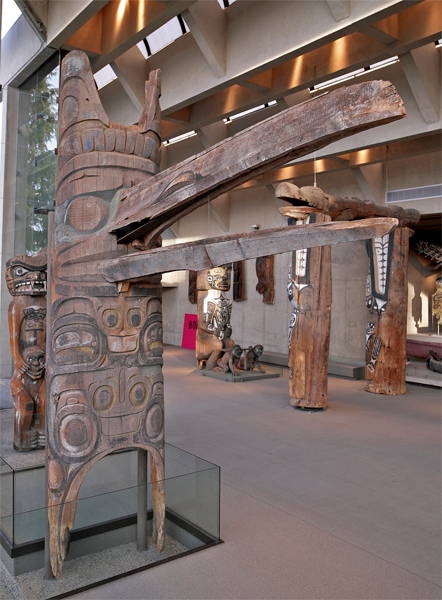
Raven Pole, Cuáxsi (House-front pole)
Wuikinuxv culture
Kitit Village (RIvers Inlet, BC)
Red cedar, paint, ca 1890
BC Totem Pole Preservation Committee purchase, 1956
A50006
This pole belonged to my late father, Simon Walkus, Sr. (1900-1969), a hereditary chief. His name, Xvusemdaas Waakas, means 'FIrst to drink at the head of the Great River.'
The name of the pole is not remembered; It was known only as the Raven Pole. It stood in front of my father's house at Kitit, an island located at the head of the Wannock River. The house was called Galuthudala, which means 'protruding above the rest.' There were at least seven other Big Houses there; his was at the centre.
Nuuwaqawa (Evelyn Windsor), 2009
Wuikinuxv Nation
Description:
Wood totem pole carved in low relief; crescent shaped in cross section. Depicted is a supernatural bird (hokhohw) with archway opening at base. The figure has large protruding ears; in its body are two eagle heads in profile. A large beak in two pieces extends out from the pole. The beak once was supported by a figure of a man standing on a crouching grizzly bear. The base of the pole was originally longer. The surface is painted in green, yellow, black and blue in Northwest Coast stylised designs.
The beings represented on Kwakwaka'wakw totem poles are those beings from mythical times who became, or were encountered by the ancestors of those who commissioned the pole, whose family had claimed the figures as crests. Crests could also be obtained as marriage gifts. This pole originally stood as an entrance to a house. It was relocated as a memorial at the grave of the man for whom it was erected (the brother of Chief Simon Walkus).
Hokhohw is one of the supernatural birds associated with the rituals of the Hamatsa Society, which performs during the Kwakwaka'wakw winter ceremonial season. The right to become initiated as a Hamatsa dancer is an inherited family privilege accessible to only some Kwakwaka'wakw families. Hokhohw is recognised by a long and pointed beak.
Made in Rivers Inlet, British Columbia, Canada during 1890
Collected by Wilson Duff, Wayne Suttles, Michael Kew and Helen Codere during 1956
Owned by Simon Walkus
Name: House Frontal Totem Pole
Identification Number: A50006
Height 4.6 m, width 1.4 m, depth 3.7 m
Condition: fair
Accession number: 2112/1
Photo (left): Don Hitchcock 2012
Photo (right): http://www.rrnpilot.org/items/17964
Text: http://www.rrnpilot.org/items/17964
Source: Display, Museum of Anthropology, University of British Columbia

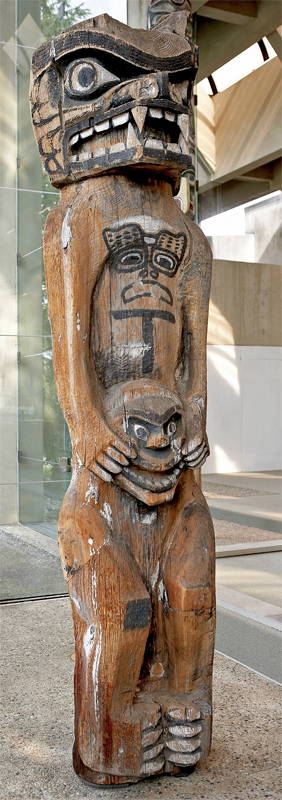
Dlam (Interior house post)
Kwakwaka'wakw: 'Namgis
'Yalis (In 1860, 'Yalis was renamed 'Alert Bay' after a British naval gunship)
Red cedar, paint, ca 1890
BC Totem Pole Preservation Committee purchase, 1956
A50036 (not A50006 as the card in the Museum identifies it)
With a look of fierce defiance, this house post once stood inside a Big House belonging to Chief Pal'nakwala Wakas. It depicts a grizzly bear - an important 'Namgis crest figure - holding the head of a rival chief. A copper shield, further symbolising the Wakas family's high rank, is painted on the bear's chest.
The artist and chief, Doug Cranmer (1927 - 2006), inherited his father's chiefly name Pal'nakwala Wakas at a memorial potlatch he hosted in 1974. He recalled as a child seeing this house post standing in his mother's yard at Alert Bay, long after the original Wakas house had been dismantled.
Alternative description, from http://www.rrnpilot.org/items/17791:
Wooden house pole carved in high relief. Depicted is a bear with a protruding snout and ears and large, carved bared teeth. In its front paws is a human head. On the chest of the bear is an image of a face in the shape of a copper, a symbol of power and wealth. Some features of the post are painted in black and white with Northwest Coast stylised designs.
House posts often served as structural supports inside large dwelling houses. Figures represented on Kwakwaka'wakw house posts were supernatural beings which the family living in the house had the right, through their history and origins, to display as a family privilege.
The bear is usually represented in Kwakwaka'wakwsculpture with a squared snout and ears, flared nostrils, and sharp teeth.
This post was repaired and repainted by Kwakwaka'wakw carvers Ellen Neel in 1949 and Mungo Martin in 1950-51.
Collected by Marius Barbeau and Arthur Price during 1947
Identification Number: A50036
Height 3.8 m, width 0.86 m, depth 0.43 m
Condition: fair
Accession number: 2106/3
Photo (left): Don Hitchcock 2012
Photo (right): http://www.rrnpilot.org/items/17791
Source: Display, Museum of Anthropology, University of British Columbia
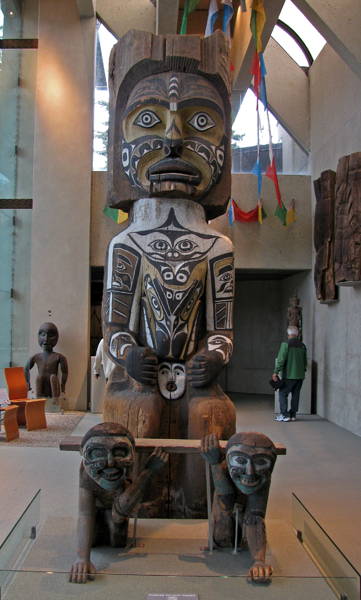
Human Figure House Post with Slaves
Quatsino artist Siwis (George Nelson) carved this ancestor figure and slaves around 1906.
BC Totem Pole Preservation Committee purchase, 1956
A50009 d-f
Part of interior house frame. The large wooden human figure (part d) is carved in high relief in a seated position. It is painted with a killer whale on its chest and broken coppers on both arms. In between his hands and below the killer whale is a small white face. The head is large, has a protruding nose and mouth, large carved eyes and is heavily decorated with yellow, white and black Northwest Coast stylised designs. Before the figure stands a wooden platform or seat supported by two kneeling slave figures (parts e-f), with unusual grimacing faces. Both figures have their outside arm rested on the ground while the other is turned backwards as if to support the seat that rests on their backs. Their eyes and bared teeth are carved in shallow relief while the rest of their face is carved in high relief. Their arms and upper body are painted green with black rings around the wrist and forearm. Their faces are painted green, white and black with Northwest Coast stylised designs.
The beams and figures stood as part of a house frame, and acted as structural supports. Figures represented on house frames were supernatural beings which the family living in the house had the right, through their history and origins, to represent.
Slaves were captured members of other Northwest Coast groups.
Part d, the large human figure, was repainted by Bill Holm in Seattle for the World's Fair of 1958. Gerry Marks did restoration work on the slave figures in 1976 - the replacement arm of one figure is signed 'G. Marks (1/76)'. This may have been the house photographed by E. Curtis in 1910 shortly after completion, according to Hawthorn (1979).
Made by George Nelson (Maker), Bill Holm (Technician) and Gerry Marks (Technician) in Quatsino, British Columbia, Canada and Xwatis, British Columbia, Canada during 1906
Collected by Helen Codere, Wilson Duff, Wayne Suttles and Michael Kew during 1956
Owned by Chief Johnny, Charley Clair
Received from British Columbia Totem Pole Preservation Committee (Transferring institution) during 1956
Material: cedar wood, iron metal, adhesive and paint
Part d: height 4.0 m, depth 1.1 m
Part e, f: height 90 cm, width 145 cm, depth 118cm
Made in: Quatsino, British Columbia, Canada and Xwatis, British Columbia, Canada
Condition: fair
Accession number: 2112/4 d-f
Culture: Kwakwaka'wakw : Gusgimukw
Creator: George Nelson (Maker), Bill Holm (Technician) and Gerry Marks (Technician)
Creation Date: during 1906
Photo: Don Hitchcock 2012
Source: Display, Museum of Anthropology, University of British Columbia
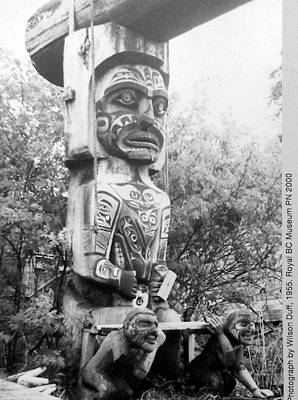
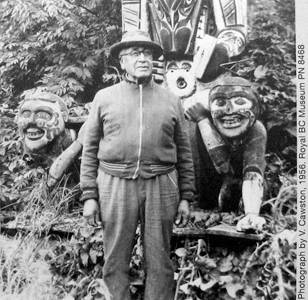
Ancestor figure with slaves
With copper shields painted on its arms, pieces of copper (now missing, but shown in the old photo) attached to its chin, and a sea-lion or whale head emerging from its chest, this imposing ancestor figure makes visible the Kwakwaka'wakw concept of the house as a sacred entity: an embodiment of the lineage and its supernatural origins.
Slaves are portrayed holding up the ceremonial bench. Although capturing slaves through intertribal warfare had been abandoned on the Northwest Coast by 1900, these figures symbolise the wealth uplifting Tza'kyius and his lineage.
On the left, the photo shows the ancestor figure and the slaves as they were in 1955.
On the right, the photo shows the Quatsino artist Siwis (George Nelson) who carved the ancestor figure and slaves around 1906. He also carved a series of interior posts that supported the lateral beams of the house. The sea-lion house posts and crossbeam displayed in the photo further down this page were carved by Qautsino Hansen.
Photo (left): Wilson Duff, 1955. Royal BC Museum PN 2000
Photo (right): V. Cawston, 1956. Royal BC Museum PN 8468
Source: Display, Museum of Anthropology, University of British Columbia
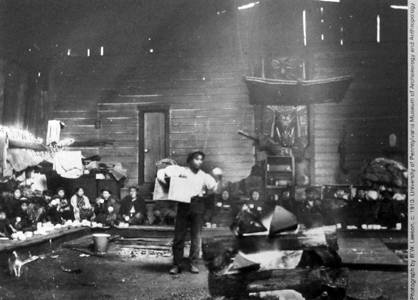
This photo shows a ceremonial feast inside the Klix'ken Bighouse, ca 1910. The ancestor figure stands against the rear wall, behind which was a smaller room for private use.
Sometime around 1906, the Klix'ken, or Sea Lion House, was built in Xwatis village, deep inside Quatsino Sound on northern Vancouver Island. By this time, Aboriginal peoples along the coast had largely replaced their traditional cedar lineage houses with Victorian framed houses of milled lumber. Klix'ken House was the last old-style dwelling erected in Xwatis. Although it featured a modern exterior with milled-lumber front and three windows around the door, its interior revealed a monumental post-and-beam structure with carved symbols of the family's history and wealth.
Tza'kylus was the owner of this great house and of the sea-lion crest after which it was named. Two large sea-lion house posts carved by Quatsino Hansen stood inside the front door, supporting a crossbeam said to represent a double-headed sea lion. The other end of the ridge beam spanning the length of the house was held up by the head of a figure, carved by George Nelson, that depicts a powerful transformer being - a founder of the lineage. With copper shields painted on his arms, pieces of copper (now missing) attached to his chin, a sea-lion or whale head emerging from his chest and two slaves holding up the ceremonial bench before him, this imposing ancestor figure makes visible the Kwakwaka'wakw concept of a house as a sacred entity: an embodiment of the lineage and its supernatural origins (KD)
Photo: B.W. Leeson, ca 1910. University of Pennsylvania Museum of Archaeology and Anthropology
Text: Mayer et al (2010)
Source: Display, Museum of Anthropology, University of British Columbia
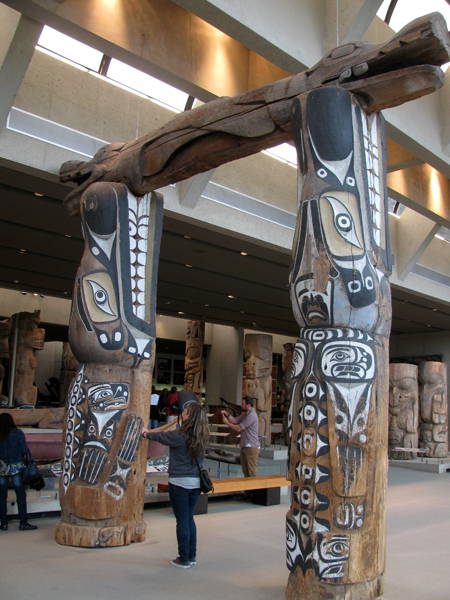
Klix'ken Gukwdzi (Sea-Lion House)
Gusgimukw (Kwakwaka'wakw)
Xwatis (Quatsino, BC)
Red cedar, paint; ca 1906
BC Totem Pole Preservation Committee purchase, 1956
A50009 a-c
These carved posts and figures once stood inside a Gukwdzi, or Bighouse, at Quatsino Sound on northern Vancouver Island. Tza'kyius was the owner of this great house and of the sea-lion crest after which it was named.
Photo: Don Hitchcock 2012
Source: Display, Museum of Anthropology, University of British Columbia
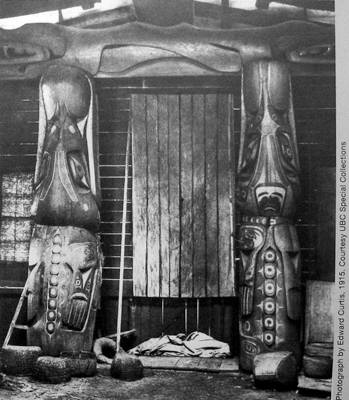
The two sea-lion posts with crossbeam formed part of the house frame just inside the front door. The crossbeam, said to represent a double-headed sea lion, originally supported one end of an 18 metre long ridge beam spanning the length of the house. Its opposite end was held up by the carved human figure portraying a supernatural ancestor, shown above.
Photo: Edward Curtis, 1915, UBC Special Collections
Source: Display, Museum of Anthropology, University of British Columbia
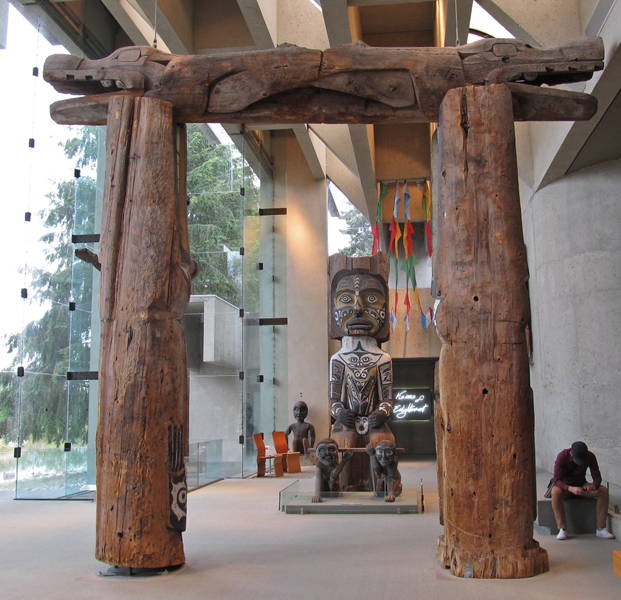
Human Figure House Post with Slaves, and Sea-Lion House posts
This photo shows the close relationship between the two major elements of the Klix'ken Bighouse, which had these two massive sculptures holding up the main 18 metre long ridgepole of the house. They have been placed in a similar position to that of their original placement.
Photo: Maria Hitchcock 2012
Source: Display, Museum of Anthropology, University of British Columbia
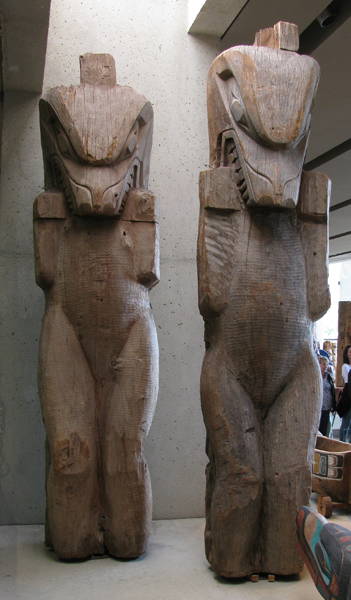
Grizzly Bear House Posts
(These are the most menacing of all the sculptures in the exhibition. The artist has created a masterwork - Don )
Two wood interior house posts (parts c-d) carved in the form of grizzly bears standing upright with their hind legs slightly bent, front paws raised to the mouth and the paws bent downwards. Both posts are missing the bottom of their hind legs. The heads of the bears are identical, with large protruding snouts that face downwards, deeply carved eyes and bared teeth. Each has a rectangular wooden protrusion at the top middle forehead.
(The rectangular protrusion is probably to provide a key, a locating piece to stop any movement, for the lintel of the door, or the ridge pole, which previously they supported - Don )
These were the house posts of Chief Kiwidi of Tswadenak. The house was built by Kiwidi. Mrs. Sam Weber of Kingcome Inlet is the daughter of Kiwidi.
Made by Awalaskanis (Maker) in Gilford Island, British Columbia, Canada and Gwa'yasdam's, British Columbia, Canada between 1820 and 1840
Collected during 1956
Owned by Mrs. Sam Webber and Chief Kiwidi
Identification Number: A50010 c-d
Material: cedar wood and metal
Part C: height 340 cm, width 60 cm
Part D: height 340 cm, width 60 cm
Made in: Gilford Island, British Columbia, Canada and Gwa'yasdam's, British Columbia, Canada
Condition: fair
Accession number: 2112/5 c-d
Culture: Kwakwaka'wakw: Kwikwasut'inuxw
Creator: Awalaskanis (Maker)
Previous Owner: Mrs. Sam Webber, Chief Kiwidi and British Columbia Totem Pole Preservation Committee
Photo: Don Hitchcock 2012
Text: http://www.rrnpilot.org/items/29155
Source: Display, Museum of Anthropology, University of British Columbia
Speaker's Post, or Speaking through Post
Another part of greeting ceremonies are the speaker's post. This is a carved ancestral figure with an open, perforated mouth; the officially appointed speaker stands behind it to announce the names of guests as though the ancestor is receiving the visitors in person.
Text above: http://www.sfu.ca/brc/art_architecture/totem_poles.html

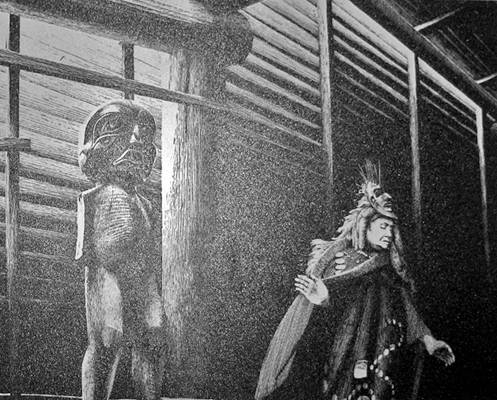
Yak'ant'akw (Speaking through post)
Kwakwaka'wakw: 'Nak'waxda'xw
Ba'a'a (Blunden Harbour, BC)
Red cedar and paint, ca 1860
Gift of Sydney Gerber, 1954
A50043
A carved figure such as this one, with its prominent, open mouth, was used during winter ceremonies inside the Bighouse.
A person who held the privilege of speaking on behalf of the hosts would conceal himself behind the figure, projecting his voice forward. It was as though the ancestor himself was calling to the assembled guests.
Photo (left): Don Hitchcock 2012
Photo (right): Illustration by Gordon Miller, 1982
Source: Display, Museum of Anthropology, University of British Columbia
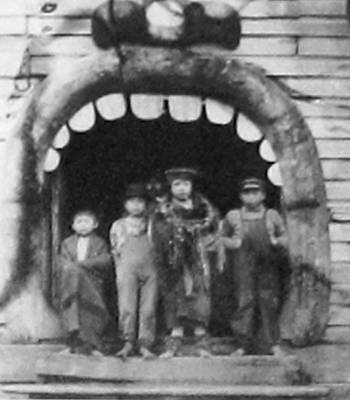
'I went to the Big House in Alert Bay with the late Jimmy Sewid. As we walked toward the house, he said, 'The door of the house is the mouth of our ancestor. It is the mouth of heaven. The fire is the soul of the house.'
'Inside the Bighouse, I looked up and saw the backbone, ribs, and soul. I could feel it, sense it, and touch it with my spirit.'
Wedwdi Speck, 2007
Kwakwaka'wakw hereditary chief, G'exsem na'mima, Kwagu'l First Nation.
The photo at left shows a young Hamats'a initiate standing with others in the entrance of a Bighouse at
Xwamdasbe' (Hope Island), ca 1910
Kwakwaka'wakw Bighouse
Until the late 1800s, members of an extended family would live together in a cedar-plank Bighouse, or Gukwdzi.
When a Bighouse was prepared for winter ceremonies, the sleeping quarters and objects of daily life were cleared away to mark its transformation from a secular to a mythic space.
Today, newly built Bighouses and other large halls remain vital gathering places in which feasts and ceremonial events are held.
Source: Display, Museum of Anthropology, University of British Columbia
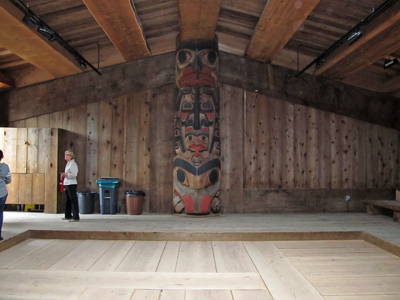
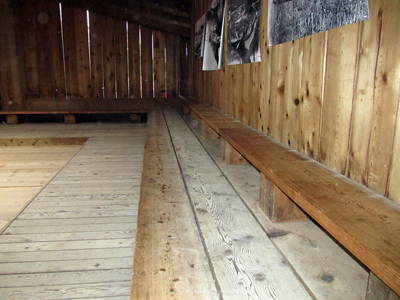
Inside one of the Big Houses at the Museum of Anthropology, University of British Columbia.
(Note the sleeping platforms along the sides. For the important winter ceremonies, these would have been cleared away as shown here, but during the rest of the year they would have held furs and mats to make the area more comfortable for sleeping and ordinary life inside the Big House, as well as all the paraphernalia of daily living in the rest of the huge space, which would have held a large extended family - Don )
Photo: Maria Hitchcock, 2012
Source: Display, Museum of Anthropology, University of British Columbia

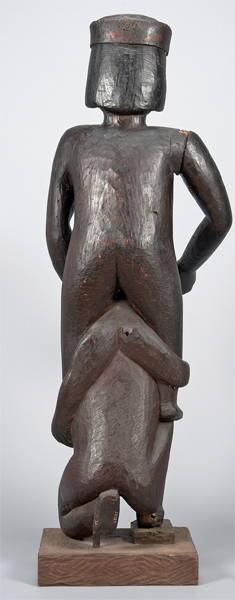
Wooden, carved figure depicting a chief being carried by a slave.
Kwakwaka'wakw culture
A17154
The top figure has a painted face and body, and is wearing a headdring; all are painted red and black with Northwest Coast designs. The position of the body is standing with his right arm extended and his palm open. The left hand is under the other figure's chin. The second figure, or slave, is in a crouched position with his left knee bent under and his right knee bent up supporting the right leg of the 'chief'. The 'slave' is holding the other figure's left foot in his left hand and the right is wrapped around the 'chief's' leg. The second figures face has an open mouth and is painted red and black with Northwest Coast stylised forms. The figures are mounted on a rectangular wooden block.
This figure would have been displayed publicly, perhaps during a potlatch, to honour or commemorate the greatness of a chief. (His right arm should be raised upward - not as it is in the present position.)
The figure represents the relationship between those of noble rank and those of the slave class. The chief is portrayed in an idealised fashion, with his right arm extended in one of the stylised gestures of speech-making and greeting used on formal occasions. In contrast, the slave's features are crudely carved. The upper figure shows high rank by the wearing of a distinctive headring or headdress.
Made in British Columbia, Canada
Received from Walter C. Koerner (Donor) during January 1973
cedar wood, paint and stain
Height 1308 mm, width 458 mm, depth 343 mm
Condition: fair
Accession number: 233/21
Photo (left): Don Hitchcock 2012
Photo (right) and text: http://www.rrnpilot.org/items/35605
Source: Display, Museum of Anthropology, University of British Columbia
(The terms 'Salish', 'Coast Salish' and 'Inland Salish' are terms which are not easy to define.
Most researchers now appear to use the term 'Coast Salish' to refer to the First Nation peoples living on the continental coast, and mostly within about 100 Km of it or less, in the basin draining into the 'Salish Sea', a term which was itself only defined in 2010, outlined in the coloured map below. The term also refers to the First Nation people originally living on parts of the lower eastern and southern coast of Vancouver island, as well as part of the Olympic Peninsula.
Note, however, that the original term of Salish applies to a much wider region, and was and is applied to the Flathead Nation, and the region around Flathead Lake in Montana, a considerable distance away, with a different culture and in a quite different ecological system.
The black and white map below the coloured map shows the complete Salish language groups, including both Coastal and Inland Salish groups. Note that on this map, the Coast Salish area also includes most of the Olympic Peninsula, not just a relatively narrow strip as shown in the coloured map. - Don )
From Wikipedia:
Coast Salish peoples
Coast Salish is a relatively new term used to describe the groups of indigenous peoples who live in southwest British Columbia and northwest Washington state along the Salish Sea and share a common linguistic and cultural origin. The Coast Salish are seen as one of the main cultural and linguistic branches of a larger group known as Salishan or Salish. There are five recognized divisions of the Salish language family, with Coast Salish and Interior Salish being the primary two. The Salish family consists of 23 separate languages. European and American explorers first encountered Salishan people along the Pacific Northwest coast in the late 18th century. The first detailed information was obtained by the Lewis and Clark Expedition of 1804-1806. The term 'Salish' was originally applied only to the Interior Salish Flathead tribe living in the region of Flathead Lake, Montana. By the mid-20th century it had been extended to cover all people speaking a similar language. The Flathead Nation continues to refer to their language and culture as Salish. A variant name for Flathead Lake is 'Selish Lake'. The name Salish Sea was coined only in the late 20th century. There is no overarching title for this area or even a commonly shared name for any of the waterbodies in any of the Coast Salish languages.
The waterways of the Salish Sea were important trade routes for the Coast Salish and they remain a source of food and other resources for the indigenous peoples. The basin includes territory of the Northern Wakashan Kwakwaka'wakw and Southern Wakashan peoples (the Nuu-chah-nulth, Makah, and Ditidaht) and, formerly, that of the Chimakum (a Chimakuan people related to the Quileute who no longer exist as recognisable group, having been wiped out by the Suquamish and others in the 19th century).
Other names
The region encompassing these waterways is or was also known variously as the Georgia-Puget or Puget-Georgia Basin, or in the singular as the Georgia Depression, the Georgia Basin or Puget Sound et al. The Canadian half of the region has also often been referred to as the Gulf of Georgia, a term which encompasses the Strait of Georgia and all other waters peripheral to it, as well as to the communities lining its shores or on its islands. Like the term 'Puget Sound,' the terms 'Georgia Strait' and 'Gulf of Georgia' describe the general region as well as the body of water.
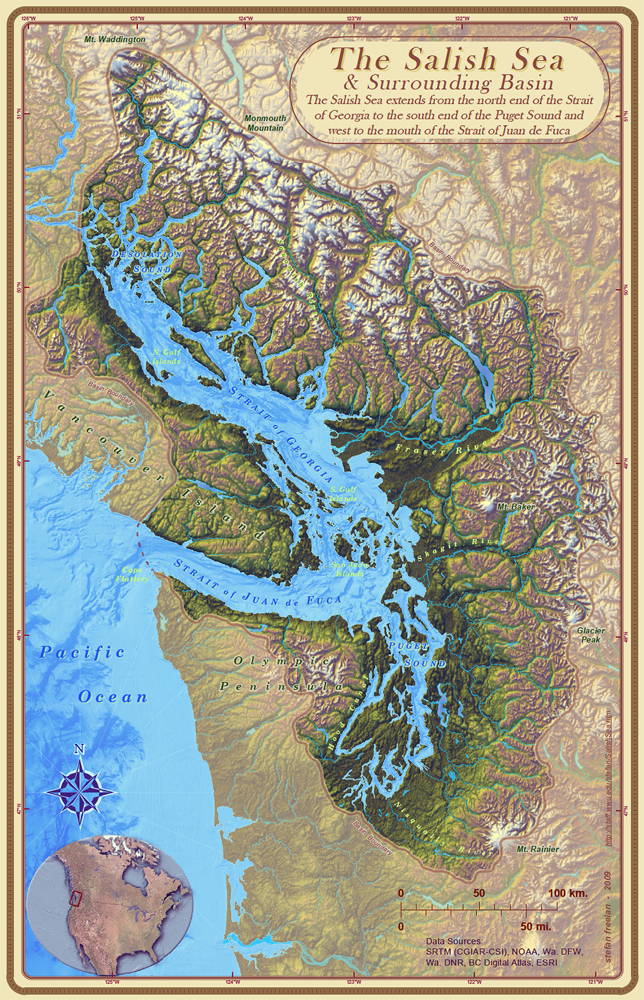
Map of the Salish Sea & Surrounding Basin, Stefan Freelan, WWU, 2009
In the fall of 2009 and winter of 2010 the Washington State Board on Geographic Names, the Province of British Columbia Geographic Names Office, the U.S. Board on Geographic Names and the Geographical Names Board of Canada each approved the name 'Salish Sea' as an official designation for the inland marine waters of Washington and British Columbia.
Map Production Notes
Cartographer: Stefan Freelan, 2009
Software: ESRI's ArcGIS 9.2
Elevation Data: SRTM (CGIAR-CSI) 2
Bathymetry Data: NOAA, Wa. DFW
Additional Data: Wa. DNR, BC Digital Atlas, ESRI
Source: http://staff.wwu.edu/stefan/salishsea.htm
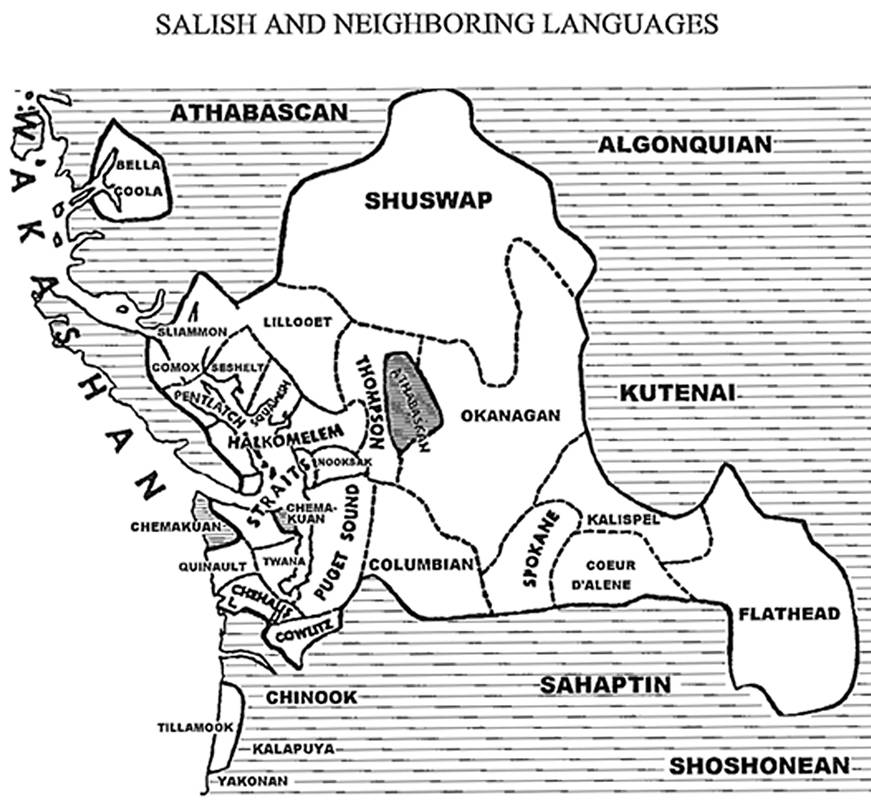
Map of the Salish Language Groups
See
http://en.wikipedia.org/wiki/Salishan_languages
for a more detailed list of Salish languages.
Coast Salish:
A. Bella Coola-Nuxalk
B. North Georgia Branch
Comox-Sliammon
Pentlatch
Sechelt
South Georgia Branch
Squamish
Halkomelim (Cowichan, Musqueam, Stolo)
Nooksack
Northern Straits (Samish Sooke Sohghis Sanich, Lummi)
Clallamor Southern Straits
Puget Sound Branch
Lushootseed
Hood Canal Branch
Twana
C. Tsmosan – Olympic
Quinault
Lower Chehalis
Upper Chehalis (Sastop, Tenino, Oakville)
Cowlitz
D. Tillamook – Nehalem, Tillamook, Siletz
Source: http://www.syilx.org/who-we-are/the-syilx-people/language/history-of-the-language/
A Basic Guide to Names (Coull, 1996)
Listed below are the First Nations Peoples as they are generally known today with a phonetic guide to common pronunciation. Newcomers to these phonetic pronunciations may still find a huge gap between what they say and what they hear a native speaker saying. The best way to learn these name is to listen closely when in the presence of someone more familiar, and perhaps even ask for a quick lesson. Also included here are name formerly given these groups, and the language families to which they belong.
| People | Pronunciation | Have Been Called | Language Family |
| Haida | Hydah | Haida | Haida |
| Ktunaxa | Tun-ah-hah | Kootenay | Ktunaxa |
| Tsimshian | Sim-she-an | Tsimshian | Tsimshian |
| Gitxsan | Git-k-san | Tsimshian | Tsimshian |
| Nisga'a | Nis-gaa | Tsimshian | Tsimshian |
| Haisla | Hyzlah | Kitimat | Wakashan |
| Heiltsuk | Hel-sic | Bella Bella | Wakashan |
| Oweekeno | O-wik-en-o | Kwakiutl | Wakashan |
| Kwakwaka'wakw | Kwak-wak-ya-wak | Kwakiutl | Wakashan |
| Nuu-chah-nulth | New-chaa-nulth | Nootka | Wakashan |
| Tsilhqot'in | Chil-co-teen | Chilcotin | Athapaskan |
| Dakelh | Ka-kelh | Carrier | Athapaskan |
| Wet'suwet'en | Wet-so-wet-en | Carrier | Athapaskan |
| Sekani | Sik-an-ee | Sekani | Athapaskan |
| Dunne-za | De-ney-za | Beaver | Athapaskan |
| Dene-thah | De-ney-ta | Slave(y) | Athapaskan |
| Tahltan | Tall-ten | Tahltan | Athapaskan |
| Kaska | Kas-ka | Kaska | Athapaskan |
| Tagish | Ta-gish | Tagish | Athapaskan |
| Tutchone | Tuchon-ee | Tuchone | Athapaskan |
| Nuxalk | Nu-halk | Bella Coola | Coast Salish |
| Coast Salish** | Coast Salish | Coast Salish | |
| Stl'atl'imc | Stat-liem | Lillooet | Interior Salish |
| Nlaka'pamux | Ing-khla-kap-muh | Thompson/Couteau | Interior Salish |
| Okanagan | O-kan-a-gan | Okanagan | Interior Salish |
| Secwepemc | She-whep-m | Shuswap | Interior Salish |
| Tlingit | Kling-kit | Tlingit | Tlingit |
** Although Coast Salish is not the traditional First Nations name for the people occupying this region, this term is used to encompass a number of First Nations Peoples including Klahoose, Homalco, Sliammon, Sechelth, Squamish, Halq'emeylem, Ostlq'emeylem, Hul'qumi'num, Pentlatch, Straits.
References
- Barbeau, M., 1950: Totem Poles, 2 Volumes, National Museum of Canada, Bulletin No. 119, Anthropological Series, No. 30, Ottawa: Department of The Secretary of State. 1950.
- Brown, P., 2011: We Are The Wuikinuxv Nation, UBC Museum of Anthropology Pacific Northwest sourcebook series © Wuikinuxv Nation UBC Museum of Anthropology, 2011 University of British Columbia 6393 N.W. Marine Drive Vancouver, B.C. V6T 1Z2
- Collison, W., 1915: In the Wake of the War Canoe, Toronto: Musson Book Company.
- Coull, C., 1996: A Traveller's Guide to Aboriginal B.C., Whitecap Books (April 1996)
- Duff, W., 1959: Histories, Territories and Laws of the Kitwancool, Anthropology in British Columbia Memoir No. 4 (Victoria: Provincial Museum of British Columbia, 1959)
- Galois, R., 1994: Kwakwaka'wakw Settlements, 1775-1920: A Geographical Analysis and Gazetteer, Volume 1 of Northwest native studies series, UBC Press, 1994
- Grant, P., 2001: Wish You Were Here: Life on Vancouver Island in Historical Postcards, Horsdal and Schubart
- Hawthorn, A., 1979: Kwakiutl Art, University of Washington Press (January 1, 1979)
- Jonaitis, A., 2006: Art of the Northwest Coast, University of Washington Press, October 1, 2006
- Martin, J., 2009: Making settler space - George Dawson, the Geological Survey of Canada and the Colonization of the Canadian West in the Late 19th Century , Ph D. thesis submitted to Queen's University Kingston, Ontario, Canada, September 2009
- Mayer, C., Shelton A., 2010: The Museum of Anthropology at the University of British Columbia, University of Washington Press, February 15, 2010
- Savard, D., 2005: Changing Images: Photographic Collections of First Peoples of the Pacific Northwest Coast Held in the Royal British Columbia Museum, 1860-1920BC Studies, no. 145, Spring 2005
- Stewart, H., 1993: Looking at Totem Poles, Douglas & McIntyre, 01/01/1993 - Indians of North America - 191 pp.
Back to Don's Maps
 Back to Archaeological Sites
Back to Archaeological Sites
 Back to Pacific NW Coast index
Back to Pacific NW Coast index
